elio ciol RESPIRI DI VIAGGIO
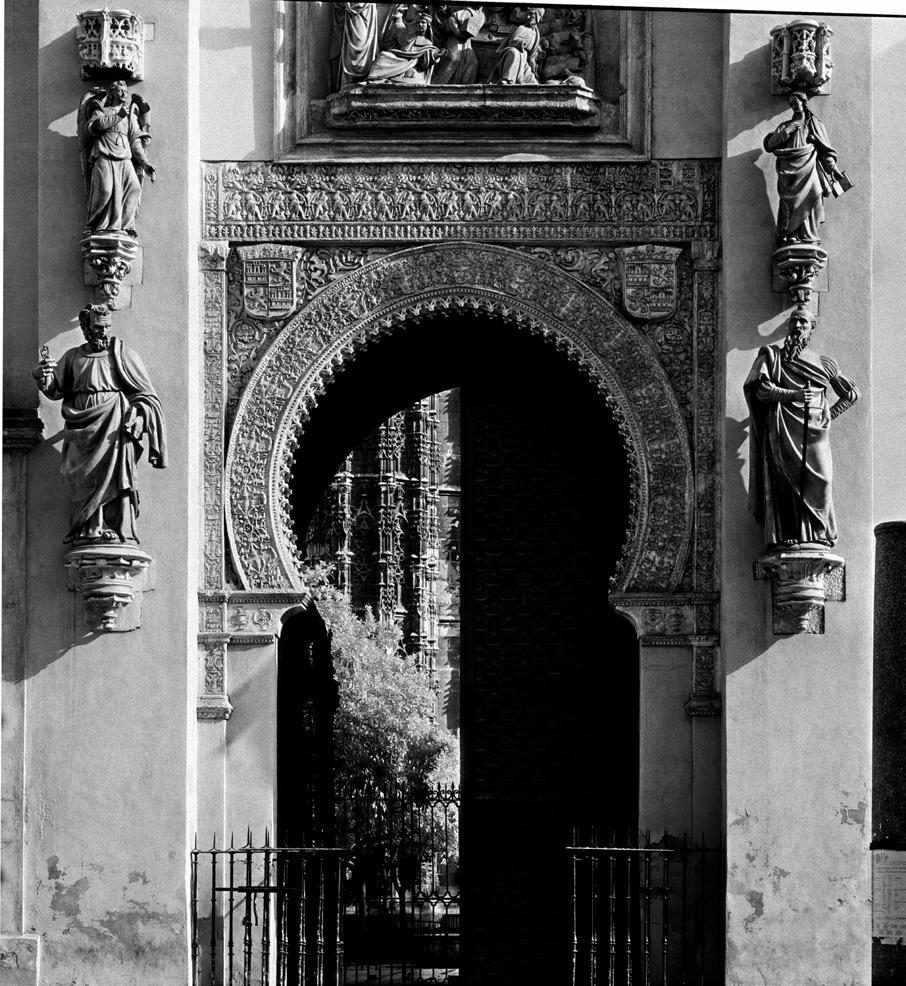
Progettazione grafica / Graphic design
Carolina Tomasin per
Foto / Photos
Elio Ciol
Traduzioni / Traductions
British School of Verona
Stampa / Print
Grafiche Silz, Verona
Finito di stampare nel mese di febbraio 2021
First published February 2021
Edito da / Edited by Punto Marte editore
ISBN 978-88-94875-34-8
Copyright by Elio Ciol / Punto Marte edizioni
elio ciol
RESPIRI DI VIAGGIO BREATHING IN THE SCENE
CASARSA DELLA DELIZIA, SPAZIO ESPOSITIVO EX SALA CONSILIARE MARZO-GIUGNO 2021
Promosso da Città di Casarsa della Delizia
Con il sostegno di Camera di Commercio di Pordenone - Udine
Confcommercio Imprese per l’Italia Ascom Pordenone
Unione Artigiani PordenoneConfartigianato Imprese
Consorzio di Sviluppo Economico Locale del Ponte Rosso - Tagliamento ITAS Mutua
Con la collaborazione di Pro Casarsa della Delizia
Testi di Fulvio dell’Agnese
Allestimento sala espositiva
DM+B & Associati
Organised by The Municipality of Casarsa della Delizia
With the support of Pordenone – Udine Chamber of Commerce Confcommercio Imprese per l’Italia Ascom Pordenone Unione Artigiani PordenoneConfartigianato Imprese Consorzio di Sviluppo Economico Locale del Ponte Rosso - Tagliamento ITAS Mutua
With the cooperation of Association for the Promotion of Casarsa della Delizia

Words Fulvio dell’Agnese
Exhibition hall setup
DM+B & Associati
A proposito di viaggi…
Questa mostra dal titolo “Respiri di viaggio” è una raccolta di foto che ho avuto la fortuna di scattare durante i miei viaggi all’estero. Fissavo nella pellicola quello che mi colpiva come cosa nuova, inaspettata, esuberante e in armonia con il luogo che visitavo, sempre così lontano dal mio Friuli.
E già gioivo di poter poi mostrare le immagini a tante persone, amici, e far godere anche i loro occhi. Ora è arrivato questo momento grazie alla collaborazione e al sostegno del Comune del mio Paese, Casarsa Della Delizia, che ringrazio molto e che nonostante la terribile situazione del Coronavirus è riuscito a realizzare questa mostra.
Ed è del tutto casuale che questo evento si realizzi in un tempo assai prossimo, voglia o non voglia, al grande viaggio che mi aspetta.
Un grande viaggio verso il mistero dell’Infinito e all’incontro con il creatore della luce, delle stelle -di una immensità di stelle- e della nostra terra.
Ma soprattutto con l’Autore dell’amore fraterno.
Un incontro che spero avvenga in tanta luce e pace.
About journeys…
This exhibition, titled “Breathing in the Scene”, is a collection of photos I was lucky enough to take on my travels around the world.
I captured on my rolls of film what struck me as being new, unexpected, bright and in harmony with the place I was exploring, far from my beloved home region of Friuli in the north-east of Italy. It was joy enough for me to show my pictures to my friends and other people, and see their eyes light up as mine did, but now, thanks to the cooperation and support of the Municipal Council in my hometown of Casarsa della Delizia, I have the opportunity to show these images to a wider audience. My sincerest thanks go the Council for managing to organize this event despite the terrible Coronavirus pandemic.
It’s totally coincidental that this event is being held so close to the great journey which awaits me, whether I want to make it or not.
My last journey will take me towards the mysteries of the infinite and a meeting with the Creator of light, of stars – an infinity of stars –, of our earth and, above all, of brotherly love.
I hope this meeting will be filled with light and peace.
Elio Ciol Casarsa, marzo (march) 2021
Respiri di viaggio è il percorso espositivo con il quale la città di Casarsa della Delizia intende rendere omaggio ai traguardi di vita e professionali di Elio Ciol, da oltre settant’anni sublime tessitore di luce, maestro della fotografia contemporanea.
Stima e gratitudine si uniscono in questa azione culturale all’impegno volto ad onorare la generosa donazione effettuata dal maestro nel 2016: oltre settecento opere, ora patrimonio del Comune, tra le quali si contano numerose fotografie già acquisite dalle collezioni permanenti di alcuni tra i importanti musei del mondo, quali il Metropolitan Museum of Art di New York, il Center for Creative Photography di Tucson, il Victoria and Albert Museum di Londra sino al Museo Pushkin di Mosca. Nel 2017, con una mostra di grande successo di pubblico e di critica, ha preso avvio un progetto culturale di lungo respiro che si propone, nel nome di Elio Ciol, di promuovere Casarsa come punto di riferimento regionale dell’arte fotografica.
A questo intendimento risponde la presente proposta espositiva, che non mancherà di sorprendere ed emozionare. In mostra, accanto ad opere presenti nel fondo comunale, susciteranno certamente interesse le numerose fotografie inedite, non solo in bianco e nero ma anche a colori, riprese dal maestro nei tanti viaggi in molti paesi del mondo.
‘Breathing in the Scene’ is the exhibition organised by the municipal council of Casarsa della Delizia to pay homage to the professional and personal achievements of Elio Ciol, our homespun master of contemporary photography who has been making tapestries of light for over seventy years.
The exhibition is a demonstration of our respect and gratitude for the generous donation made by Ciol in 2016 –more than seven hundred works are now owned by the town, many of which have been added to the permanent collections of some of the most important museums in the world: the Metropolitan Museum of Art in New York, the Center for Creative Photography in Tucson, Arizona, the Victoria and Albert Museum in London and the Pushkin Museum in Moscow, to name a few. In 2017, an exhibition which met with the appreciation of critics as well as the general public marked the starting point of a broad-ranging Arts project using the name of Elio Ciol to promote Casarsa della Delizia as the flagship for the photographic arts in our region. This new exhibition is the product of the same desire, and we’re sure it won’t fail to surprise and delight. The photographs on show are not only from our collection – there are also a number of previously unseen works which will certainly be appreciated. Some are in black and white, while others are in full colour, but all of them were taken by Ciol on his many travels around the world. At a time like this, when we are faced with unprecedented restrictions on our movements, our natural desire to
In un tempo di costrizioni nel quale ci misuriamo con un’inusuale esperienza di limite, si agita in noi più urgente che mai il bisogno naturale di movimento. La vita ha sete di viaggio e la mostra osa una risposta con un’esperienza culturale attraverso un suggestivo itinerario fotografico attorno a questo tema. Un rincorrersi di architetture, paesaggi e colori lontani conquistati da Elio Ciol, la cui grazia è capace di vedere e custodire. I luoghi hanno bisogno di qualcuno che li racconti. E il maestro con la sua sensibilità ci accompagna in questa narrazione visiva che provoca in noi la reazione desiderata dello stupore, di un nuovo inatteso, di una gioia che sgorga dal vedere cose mai viste, dal conoscerle, dal saperle vere. Ed ecco il miracolo. Il cammino fisico impossibile si invera in noi nel viaggio più difficile e trasformativo, quello da noi stessi a noi stessi.
Un sincero ringraziamento agli enti e alle realtà economiche che hanno scelto di sostenere la realizzazione di questo evento, certi che investire soprattutto oggi in cultura significhi investire nel futuro.
Un grazie particolare al prof. Fulvio Dell’Agnese, curatore della mostra, al quale è toccato il privilegio di affiancare il maestro Ciol nel minuzioso e sistematico lavoro di selezione degli scatti e di ideazione del percorso espositivo, consegnando al visitatore parole leggere e vibranti, preziosa bussola di orientamento. Ogni viaggio inizia con la partenza, prepariamoci ad avere occhi nuovi e facciamo il primo passo. Buon viaggio!
move and explore is felt more strongly than ever. Life is hungry for journeys and with this exhibition we hope to provide a cultural experience which speaks to this need through a series of art photographs about travel. It’s a procession of architecture, landscapes and colours from the far-off lands Elio Ciol has conquered with his lens and whose grace he has always captured with mastery. Places need someone to talk about them, and Ciol’s sensitivity guides us through this visual story, arousing the desired reactions in us: amazement, wonder at unexpected sights, the joy of discovering new things and of feeling their realness. Herein lies the miracle: the physical journey we can’t make at the moment is transformed into a more difficult one – our own inner journey. We would like to express our sincere thanks to the public bodies and private enterprises which have given their support to this event, knowing that investing in the Arts more than ever means investing in the future.
Special thanks must go to Prof. Fulvio Dell’Agnese, the exhibition curator, who has had the privilege of working closely with Ciol in the painstaking task of systematically reviewing his works in order to decide on the exhibition theme and select the works for display, and whose words will provide visitors with a precious compass orientating them as they walk with Ciol on his travels. Every journey begins with a departure – let’s get ready to look at the world from a new point of view and set off. Enjoy the journey!
Lavinia Clarotto
 Sindaca della Città di Casarsa della Delizia Mayor of Casarsa della Delizia
Fabio Cristante
Assessore alle Politiche Culturali e del Territorio Spokesman for the Arts and the Municipal Territory
Sindaca della Città di Casarsa della Delizia Mayor of Casarsa della Delizia
Fabio Cristante
Assessore alle Politiche Culturali e del Territorio Spokesman for the Arts and the Municipal Territory
8
LO SGUARDO SELETTIVO DEL VIAGGIATORE
di Fulvio Dell’Agnese
Ci sono differenti maniere per girare il mondo in compagnia di una fotocamera. Quella attualmente più in uso è la pratica dei selfie, e la conosciamo tutti. Basta avere uno smartphone in tasca, impugnarlo, estendere al massimo il braccio – ma se volete una prolunga in alluminio la gamma di soluzioni va da Amazon agli ambulanti sul Ponte degli Scalzi, a Venezia – e scattare. Il risultato sarà la vostra faccia che occupa un terzo dell’inquadratura e, sullo sfondo, un brandello di realtà turistica che viene riscattato dal suo torpore – talora millenario –, dalla sua grigia esistenza di monumento, opera d’arte o paesaggio grazie alla vostra presenza, la cui attestazione visiva è a quel punto pronta per essere “postata” e condivisa con un mondo di frequentatori dei social sicuramente ansioso di sapere dove siete e cosa state facendo.
Un’alternativa valida anche se un po’ fuori moda ai selfie è costituita dall’approccio fotograficamente bulimico al viaggio, di cui oggi ricordiamo – non senza una certa tenerezza – le prime comparse nel secolo scorso, con le comitive di Giapponesi che erano in grado di attraversare città come Roma o Firenze traguardando costantemente i Fori imperiali o la Galleria degli Uffizi attraverso il mirino della reflex. La loro era una ingenuità fanciullesca che – anche prima di facebook e instagram – impediva di ritenere posseduto un luogo o vissuta un’opera d’arte fino a quando questi non fossero stati registrati sulla pellicola, più o meno rumorosamente deglutiti dall’apparecchio fotografico e dal suo otturatore.
Ovvio che il digitale abbia dilatato i termini possibili dell’abbuffata: il mondo circostante si offre all’obbiettivo senza più i limiti dettati dal criterio di contenimento degli scatti, una volta eliminati i costi della pellicola e l’ingombro dei rullini. Ne sono conseguenza collaterale i grumi di spazzatura visiva che si accumulano, in formato jpeg, nelle memorie dei computer; ma anche la scomparsa delle chilometriche sessioni di diapositive con cui le conquiste del viaggiatore venivano partecipate ad amici e parenti. Per rinfrescare la memoria al riguardo – o per evocare i tratti della situazione a vantaggio dei più giovani – basti pensare alla geniale scena di Playtime (1967), in cui Jacques Tati, nelle vesti di Monsieur Hulot, a casa di un amico impiega tutte le proprie energie per sottrarsi con eleganza al rito del telo bianco e del proiettore, prima che il caricatore venga inserito e che sullo schermo compaiano – cadenzate dal cla-clac del braccio meccanico – le prime immagini delle vacanze estive: fotografie sicuramente innocenti nella loro vacuità, ingenue come quelle che nello stesso film una giovane turista, appena scaricata da un pullman a Parigi, cerca di scattare a una fioraia al primo angolo di strada, mettendola in posa con dolcezza come se si dovesse ordinatamente integrare in una scenografia predisposta.
9
Esiste infine una terza via per vivere il viaggio attraverso la fotografia, incentrata sulla selezione. Alla portata del viaggiatore comune, essa delinea i contorni di una dimensione comunque popolare dell’esplorazione, ma pretende normalmente un grado maggiore di attenzione, una concentrata disponibilità percettiva: a Siena entriamo tutti, prima o poi, in Piazza del Campo, ma forse è solo se ci rendiamo conto di avere trovato in quella conca il «gheriglio stesso della città»1 che – avendo una fotocamera a tracolla – decideremo di cercare un’inquadratura che testimoni una simile sensazione; che racconti – se ne avremo il coraggio e sentiremo il bisogno di tentarlo – la nostra intimità di quell’istante con il luogo, «come se fossimo entrati in uno spazio che ci apparteneva, uno spazio dove eravamo attesi»2
Il caso su cui verte questa mostra non è diverso nella sostanza, ma assai differente dalla media nel risultato formale. Fotografo di professione, ma in giro per diletto, fuori da ogni logica standard di reportage, Elio Ciol ha realizzato nel corso degli anni e dei suoi molti viaggi centinaia di immagini che hanno catturato – con la maestria che da sempre gli viene riconosciuta, e che pure continua a stupire – momenti di privato incanto di fronte a un edificio monumentale, a un paesaggio urbano, a un graffito rupestre o ad una parata militare. Immagini di grande tensione espressiva, capaci di eludere il brusio turistico che solitamente appanna le lenti, e che sembrano frutto di un miracoloso arrestarsi del tempo: non solo quello insito nel processo fotografico – la realtà che si incide sulla pellicola e viene sottratta in fragmento alla quotidiana cronologia del divenire – ma anche quello, altrettanto decisivo, che pare aver consentito all’autore di operare in contesti non pienamente governabili, ben distanti dalla docilità di un set preordinato. Come sarà stato possibile, in pochi minuti rubati al gruppo dei compagni di viaggio, trovare il tempo e la sospensione del respiro per scatti così calibrati, che sembrano frutto di calcolate esposizioni e studi compositivi, attuati con ponderazione al cavalletto?
Due casi esemplari sono quelli di Khiva e Santorini. Le mura di Khiva, con le loro merlature, costruiscono nella vista dall’alto un serpeggiante merletto che fa venire in mente le panche del Parco Güell di Gaudì, in versione metafisica: niente trencadis coloratissimi, niente persone. Su questi bastioni, o ai loro piedi, pare esserci spazio solo per uno stupore contemplativo, di fronte ai perfetti innesti delle masse architettoniche. Al punto che non sarebbe poi così strano veder sbucare all’orizzonte il pennacchio di fumo di una locomotiva coi suoi vagoni, come in un De Chirico degli anni dieci…
«E tuttavia le immagini di Ciol, sempre per merito di un calibratissimo uso delle risorse della fotografia, mettono anche in risalto la scabra superficie di quelle fortificazioni, per così dire la loro pelle. Allora tutta quella imponenza, quella forza e quella apparente robustezza, finiscono per lasciare intravvedere, tra le screpolature e fessurazioni del fango con cui sono state costruite quelle mura, un’interna fragilità, una nascosta debolezza, un’inesorabile precarietà di fronte al flusso della storia che erano state comandate a contenere. Il vero nemico (lo comprese alla fine anche Giovanni Drogo, il giovane ufficiale protagonista
10
1 H. MATAR, Un punto di approdo, Torino, Einaudi, 2020 [2019], p. 12.
2 Ibidem
del Deserto dei Tartari) non verrà ormai né da Sud o da Nord, né da Est o da Ovest, è già dentro le mura e aspetta che giunga il suo momento. Ecco perché, al di là delle più solide apparenze, le fortificazioni costruite nei secoli dagli uomini ci ricordano comunque, per una sorta di ironia romantica, il nostro effimero essere nel tempo» (A. Bertani)3
La purezza delle forme dei bastioni di Khiva si può apparentare a quella, diversamente sospesa nella luce, degli edifici di Santorini: dicromie di muri a calce e azzurri intensi, di bianchi intonaci sullo sfondo di cielo e mare. Architettura del sole, la definisce l’autore.
Qui il gioco dei riferimenti pittorici condurrebbe dalle parti di Magritte e delle sue tele dai colori compatti eppure ingannevoli: nulla ci garantisce che dietro a certe porte inquadrate da Ciol si sviluppi uno spazio realmente praticabile, che le scale sullo sfondo conducano davvero a un piano superiore della casa o comunque a una dimensione temporalmente in linea con quella di chi, come noi, osserva da fuori dell’uscio. Il battente incorniciato di giallo, una volta spalancato, non ci precipiterà dall’ombra del suo arco direttamente nella luce azzurra screziata di nubi cremose come latte? Neppure i vasi in terracotta di un’altra immagine, che la meccanica razionale della visione colloca in angoli prospettici perfettamente scanditi, sono soltanto quello che appaiono essere; antichi nel loro materiale, lo sguardo di Elio sembra scoprirli a vigilare sul blu profondo delle acque, su equilibri che affondano nel passato. «Il suo pensiero fotografico s’è immedesimato nel significato remoto, ancestrale, che l’uomo cicladico aveva dell’esistenza. Significato che Ciol ha recuperato dall’architettura recente di Santorini, segno di una continuità ideale non determinata da acritica fedeltà ai propri trascorsi, ma dall’ambiente, che, sostanzialmente, è depositario di situazioni immemorabili, che riposano, atemporali ma sempre vive, sugli assi cartesiani dei netti profili degli edifici sacri e profani: impaginazioni costruite per proporsi all’abbaglio della luce, dove il bianco delle pareti s’alterna a cielo e mare, a vegetazione e strapiombi, oggettivando la legge ottica della complementarietà dei colori. […] Terra, mare, sole, sono unici, incontrastati protagonisti di una realtà che sgomenta ed esalta e nella quale l’architettura s’è inserita senza essere sopraffatta e senza sopraffare» (L. Perissinotto). In queste immagini leggiamo, alla fine, i modi di un rapporto dell’uomo con la natura e i suoi ritmi oggi ampiamente compromesso, se non irrimediabilmente perduto.
I luoghi visitati vengono insomma sottoposti, attraverso la fotografia, a una sorta di decantazione. Viene perfino da pensare che lo sfasamento fra realtà fisicamente sperimentata e immagine stampata si sia prodotto un po’ per volta, nel buio della sacca, mentre la pellicola viaggiava verso casa per giungere al bagno di sviluppo. Trovo l’idea estremamente poetica, anche perché l’odore dei rullini fotografici e la microcorazza del loro involucro mi hanno sempre affascinato, suggerendomi la costante sensazione d’avere a che fare con qualcosa di vivo.
Non fosse che, con Elio Ciol, le cose vanno allo stesso modo anche con le immagini digitali. Il miracolo,
11
3 Il brano è tratto dal testo Le mura di Khiva, scritto da Angelo Bertani per il progetto di pubblicazione di una cartella fotografica firmata da Elio Ciol, poi rimasta inedita. Medesima sorte ebbero, in anni passati, altri scritti più avanti citati nel testo: Tosh Hovli, la Via della Seta, sempre di Angelo Bertani; Alhambra. Il Tempo incarnato di Elio Ciol e La Cattedrale di Siviglia Visioni circolari di Alessandra Santin; L’architettura del sole di Luciano Perissinotto.
dunque, non è strettamente alchemico, avviene anche in assenza di sentori ermetici; e allora non stupisce che il fotografo, oltre ad accogliere senza remore le nuove tecnologie, si dimostri pienamente disponibile al dialogo con la storia contemporanea.
Anche se oggi è tornata a chiamarsi San Pietroburgo, la città fotografata da Ciol nel 1985 è più che mai Leningrado.
Le bandiere si muovono nella piazza – enorme scacchiera – portandosi dietro le persone, inevitabilmente ridotte a soldatini colorati nella strategia visiva della manifestazione di regime di cui osserviamo le prove. A turbare è lo scarto di scala, la sproporzione, che schiaccia anche i passanti di fronte ai giganteschi pannelli inneggianti agli eroi della rivoluzione. Che rapporto hanno le persone vere con quelle mascelle volitive dipinte su fondo rosso, con le immagini dei soldati che esibiscono le armi? O meglio, esiste un rapporto fra individuo e ideale politico – qualunque esso sia –, quando questo si declina in ideologia?
È un simile interrogativo che si snoda, sottile come un filo, lungo le linee in cui si dispongono le comparse dello spettacolo di massa, a cucire la città e la grande spianata sulla quale si svolge la celebrazione. Un disegno complesso, restituito con particolare sensibilità al colore da parte di Ciol, che “osserva” invece in bianco e nero quando davanti a lui si presentano differenti arabeschi.
Da San Pietroburgo alla Spagna, lo stacco è marcato. Nella Moschea di Cordoba il rigoglio mozarabico degli ornamenti procede parallelo all’eco di stilemi occidentali. E il sovrapposto moltiplicarsi in profondità degli archi dai conci dicromi trasforma la selva di navate – specie di palmeto pietrificato – in un meccanismo ottico alla Escher, in un ritmo di forme architettoniche che l’inquadratura dal basso esaspera sino a renderlo astratto.
Lo sviluppo dello spazio si fonde allora con il labirinto decorativo delle superfici, esplorato in altre fotografie, in cui bifore e trifore polilobate vengono assorbite dal tessuto complessivo dei rilievi.
Anche all’Alhambra di Granada, nelle fotografie del 1994, i ritmi del paramento si fanno trina che smaterializza la struttura; l’autore ne ritaglia scorci che sono “recinti dinamici”, al cui interno l’occhio è invitato a un’appagata deriva, mentre il brulichio di linee, sporgenze e concavità assorbe la geometria di fondo e trasmette quasi una sensazione di fremito pulsante, di fertilità innescata dalla luce.
Le superfici «giocano con le ampie finestre ad arco acuto e con gli usci, i cui lati non poggiano al suolo, ma lo sorvolano. Intorno e al di là preludono l’indicibile. […] Gli archi e le ogive indicano luoghi possibili in cui la dimensione temporale riacquista pienamente la dimensione estatica, […] definiscono un orizzonte di attesa. Foreste di colonne, labirinti spaziali, grafie straniere, cieli candidi, alludono al viaggio, tematizzano la visione come possibilità di riflessione e di piacere, che invita ad abbandonare la separazione tra la sfera delle emozioni e quella razionale della conoscenza» (A. Santin).
E non diversamente vengono allestiti quei “luoghi di simmetria” che sono le fotografie di Ciol della Cattedrale di Siviglia: la sua «descrizione non si interessa della globalità del corpo architettonico, ma si sofferma sul
4 «Il dettaglio, come residuo di un passato glorioso si confronta con il presente effimero, e riconduce la Storia all’Uomo. Egli è invisibile ma presente nel tondo, nella luce che rimbalza e si riflette nel buio circolare e nero; egli respira nelle soluzioni tecniche, nell’uso degli infrarossi, nell’allinearsi dei mattoni; nei marmi abilmente scolpiti che incorniciano ciò che c’è: il vuoto della finestra, il nero invisibile degli interni, il bianco piatto degli orizzonti a ridosso dello sguardo. L’assenza di profondità rende la bidimensionalità di queste opere una scelta di metodo. La statua di San Pietro, unico elemento naturalistico ritratto, conserva
12
frammento»; è «immersa in un silenzio contenente, costruita in una composizione quasi grafica” (A. Santin)4, e anche di fronte alla Giralda – eretta nel XII secolo come minareto e poi convertita a torre campanaria –Elio sceglie di ignorare il monumento e di ritagliare la simmetria di un pensiero fatto ornamento.
A stimolarlo non sono però solo contesti di così alto coefficiente estetico e spirituale. Anche in edifici meno fondamentali per la storia dell’arte, come – per restare a Siviglia – la Casa di Pilato, il fotografo rintraccia le condizioni per cui dal piano del vedere si operi lo scarto della “visione”. Formidabile l’assemblaggio di ombre, volumi e retrogusti storici nell’immagine in cui una figura femminile scolpita è distesa sotto a una panoplia di scudi e faretre. Chi sarà la donna? Sembra una Arianna addormentata, ma il rilievo che la sovrasta – e che pare dar corpo al suo sogno – non ha nulla di dionisiaco: le armi si attaglierebbero piuttosto all’immaginario dell’uomo che, in forma di busto imperiale, dal piedistallo a sinistra la osserva meditabondo e incombe con la sua ombra, come un amante incerto del controllo esercitabile sui pensieri e sulle passioni della sua compagna.
Ed è soprattutto il bilanciamento delle luci a trasformare il libero allestimento escogitato dal collezionista –che in tutta la casa accosta in beata incongruità classico, mudéjar e rinascimento – in metafisica suggestione del taglio d’inquadratura.
Il viaggio nella penisola iberica prosegue poi nei Paesi Baschi, ma con una creatura insolita e nata dalla voluta alterità rispetto al contesto: il Museo Guggenheim di Bilbao5
Ciol fotografa la struttura secondo gli stessi parametri visivi su cui ha basato la sua interpretazione della cattedrale di Siviglia o delle vertiginose trame moresche di Cordoba: non dà conto di un’architettura, ma elabora un paesaggio. Un lembo di natura fitto di scisti, depressioni e crode cangianti, su cui lo sguardo si muove vigile, inquieto, con quella capacità che è della visione laterale – limis oculis – di cogliere asperità e riflessi altrimenti destinati a sfuggire alla centrata pienezza di un’osservazione propriamente statica. Le masse vengono catturate in angolazioni d’un libero fluire che ne costituisce la più autentica ragione progettuale, ma che al contempo le proietta in una dimensione di musicali, astratte collisioni. Le lastre di titanio del rivestimento divengono elementi di una costruzione ritmica. Pura estensione della materia nella luce. Volume addensato nella compressione temporale di uno scatto dell’otturatore, espresso nella solida ambiguità del proprio status di energia sopita, pronta tuttavia – possiamo immaginare – a innescare una nuova torsione. Sopra al mobile cumulo in cui la struttura pare collassare, in alcuni momenti il cielo smarrisce i propri connotati atmosferici: azzera la sua dimensione naturale in una luce metafisica o sprofonda in un silenzio oscuro, preparando la via all’avanzare di giganteschi aracnidi dalle lunghe zampe, concepibili solo nel contesto d’una simile alterazione del visibile.
L’architettura fa propria la logica della spettacolarità che indirizza le sorti del sistema artistico contemporaneo; ma il guscio del museo-cenotafio – di quello che «non è più il luogo dello sguardo», della contemplazione posata sulla sacrale ostensione del dipinto o della scultura, ma è divenuto «il luogo dell’inversione dello la chiave di una circolarità della Natura e della Storia, dell’azione e del pensiero, dello spazio e del tempo».
5 Nelle righe che seguono, sono inglobate ampie parti del testo Fluide architetture, che chi scrive redasse per la mostra di Elio Ciol alla Galleria San Maurizio di Venezia, nel 2008.
6 J. CLAIR, La crisi dei musei La globalizzazione della cultura, Milano, Skira, 2008 [2007], p. 102.
13
sguardo»6, della stupefacente e irrelata rifrazione dello spazio espositivo e delle sue dinamiche interne –viene ricondotto da Elio Ciol ai termini di una visione discreta, priva di enfasi.
L’occhio del fotografo, in altri casi rispettoso del contesto e del suo ordine d’uso, avverte il prevalere della forma sulla funzione. L’edificio, contenitore di oggetti d’arte per accidente – specie di recipiente elastico che, mentre lascia libero lo spazio di espandersi in anarchico volume, tende a oscurare formalmente ciò che sta nel suo ventre, ovvero le opere –, si propone quale autonoma presenza geologica. Immane e irriducibile a una percezione unitaria, creatura ciclopica e proteiforme, è come se fosse diga e montagna assieme.
Poi ci sono le nuvole.
Quelle della Mongolia a Karakorum, ad esempio, che nelle fotografie del 1987 sovrastano templi, bocche di gronda e mura di cinta, ritmate da torri-padiglione quadrangolari, che sembrano cucire fra di loro con lunghe imbastiture terra e cielo.
Sbuca persino, fra le sterpaglie, un’imprevista tartaruga, docile monumento in pietra alla paziente attesa del farsi e disfarsi delle cose.
Ma sopra a tutto rimangono quei bioccoli di vapore, in grado di conferire a ogni panorama la sospesa modalità della visione. Neppure se un’anima derelitta ci passa sotto a cavalcioni d’un mulo, le nubi accettano di farsi ricondurre alla semplice registrazione atmosferica di un transitorio momento d’esistere. Stanno lì, ierofaniche, a sottintendere quanto di mistico e rituale può essere rimasto, come gromma, in uno sbrecciato calderone di bronzo; dialogano con i simbolici inquilini di un tempio – digrignanti protomi dei cornicioni – in un equilibrio di orizzontale condivisione della trascendenza7
Ed anche il monastero di Ulan Bator beccheggia sotto un cielo corrusco; i suoi tetti a pagoda sembrano una flotta di scafi incurvati, consapevoli della traversata che si prepara loro fra le nuvole- flutti, con l’equipaggio di piccoli idoli in coperta a scrutare fiducioso segnali del placarsi della tempesta, all’orizzonte.
In alcuni casi, il viaggio sotto cieli striati di bianco conduce il fotografo ancora più distante dai centri urbani. In Armenia, ad esempio, a percorrere gli allineamenti di Zorats Karer, dove le nubi amplificano la prospettiva delle infilate di megaliti: gigantesche selci preistoriche che ritagliano la pianura da millenni e lasciano ora, docili, che il fotografo sancisca nelle sue inquadrature il controllo visivo che esse esercitano sul paesaggio. Oppure a Wadi Mathendush, in Libia, dove i graffiti disegnano sulla roccia le sagome dei progenitori di rinoceronti, elefanti e coccodrilli: i grandi animali che erano padroni del territorio, prima del deserto, e che le popolazioni del tempo evocarono con rispetto in immagini ingenue quanto icastiche. Che poi sulle pareti del fiume fossile compaiano anche dei bovini e una giraffa, che lo scalpello ha scavato nella pietra con la spigolosa immediatezza di una xilografia espressionista, ha a che vedere con finalità propiziatorie per la loro cattura.
La materia si fa invece pittura a Petra, dove le increspature geologiche si offrono allo sguardo come un
7 Cfr. H. DAMISCH, Teoria della nuvola, Genova, Costa & Nolan, 1984 [1972], pp. 67-68: «[…] I segni del sacro non fanno eccezione rispetto a qualsiasi altro segno: essi appartengono a degli insiemi, a dei sistemi storicamente costituiti, in cui il rapporto laterale da segno a segno prevale sulla relazione diretta, verticale, tra significante e significato, che dovrebbe definire il simbolo. […] La nuvola non ha significato che le sia assegnabile per se stessa; non ha altro valore che quello che le viene dalle relazioni consecutive, oppositive e sostitutive che essa intrattiene con gli altri elementi del sistema».
14
tessuto vivente, le cui fibre dipingono un reticolo surrealmente elastico di rossi e di aranci; su di esso la vegetazione si installa come in una carne silicea, screziata e pulsante.
Ma le rocce rosate di Petra diventano a loro volta architettura, senza soluzione di continuità rispetto al paesaggio. I templi, con i loro sistemi di colonne, timpani e trabeazioni, sembrano le vestigia di una città che la natura ha riassorbito, inglobandola nel profilo delle colline; pare che un sipario di pietra stia per calare definitivamente sulle facciate monumentali, che invece in quella pietra sono state scavate, simulando l’architettura come in un colossale rilievo scultoreo.
Ci sono fotografie in cui il processo di trasformazione viene smascherato: la materia rocciosa, modellata in impasti geologici che immaginiamo profumare di pasticceria, tanto appaiono cremosi, mostra di essere sostanza dell’edificio; i fusti delle colonne confessano di essere parte della montagna e di non sostenere nient’altro che il fantasma di un architrave. Ma rimane, visivamente, il dubbio che la metamorfosi possa funzionare al contrario: che quel colonnato stia perdendo i suoi connotati originari di costruzione, risucchiato sotto i nostri occhi dall’energia della natura, che insidia e va ormai assimilando al proprio corpo il volume dei capitelli e il profilo del portale.
Non è molto diversa, in fondo, la sorte di quelle città che, sgretolate da un declino storico, vengono fatte rivivere dall’archeologia trattenendole in bilico sul limite che separa il sito di interesse naturalistico e la testimonianza culturale. Città che nella loro suggestiva disgregazione tornano ad essere il paesaggio da cui erano sorte.
A Gerasa – per restare in Giordania – l’infilata di colonne del foro, nel suo insolito emiciclo, ha ancora la forza di legare i resti di età romana a un riverbero di identità urbana. Ma i capitelli corinzi del Tempio di Artemide si profilano all’orizzonte, fra i sassi e gli arbusti, sullo sfondo di un cielo azzurrissimo, come reali piante d’acanto radicate al suolo.
E poi, soprattutto, c’è Leptis Magna. La città di Settimio Severo, in Tripolitania, nella quale Ciol ha realizzato una delle sue più memorabili serie fotografiche. Il suo obbiettivo indugia sull’angolo di una strada che si perde nella luce, carezza il volume di una trabeazione solcata da un girale fiorito, che nel foro della più bella colonia romana d’Africa si dimena ancora – tra sbrecciati binari di ovoli e perline – quasi fosse una delle ciocche anguiformi della terribile Medusa che gli giace accanto. E, così facendo, la fotografia di Elio contraddice ancora una volta la prima istantaneità del suo divenire, proprio come certi luoghi in cui il tempo delle cose si blocca dilatandosi; lo sguardo è costretto allora a sostare nella contemplazione di una Leptis Magna in bianco e nero, quasi che le sue Gorgoni avessero fissato la dimensione estetica della propria trascorsa, vitale esistenza in una durevole sospensione.
«Quando le ombre si stampano, e avviano / la loro graduale esalazione del passato»8, sono le geometrie che pulsano sotto la pelle dell’immagine a raccordare il relitto a ciò che esso fu e al passo ulteriore di astrazione cui lo sguardo dell’artista ci conduce.
15
8 C. WRIGHT, Mezzogiorno [da China Trace, 1977], in Breve storia dell’ombra, Milano, Crocetti Editore, 2006, p. 93: «When shadows imprint, and start / their gradual exhalation of the past».
Dico di ciuffi di sterpaglia che replicano e avvolgono spire di pietra, o che – appena più probabili di quelli che abitano le rocce fratturate di Mantegna – segnano diagonali di resistenza della natura al levigato sigillo della storia. Dico di colonne sdraiate nel deserto ventre di un mercato: cilindri a lambire spigoli d’ottagono e convessità circolari, in intatti equilibri che paiono durare da sempre, come bottiglie in una natura morta di Morandi. «Parlo d’immobilità, del silenzio / […] Parlo di colore, di forma, del vuoto / che vigilano questi oggetti, e da cui sorgono»9
Forme, volumi, vuoti…
Sono tali anche i segni dell’uomo nel paesaggio: le abitazioni rupestri della Cappadocia (i “Camini delle fate”: tane umane che convivono con l’antitesi dell’idea di anfratto, sospese come sono su friabili pinnacoli, versione in positivo degli imbuti di Laudomia, sulle cui pendici «in ogni poro della pietra s’accalcano folle invisibili» di non nati10), o i terrazzamenti fotografati in Nepal.
Qui la mano dell’uomo, nei secoli, ha saputo modellare con dolcezza i declivi d’altura tracciandovi digradanti screziature, portandoli ad assumere la grafica sinuosità di un verde arenile segnato dall’andare e venire delle acque. Ma in quel medesimo, altissimo angolo di mondo il fotografo – lo stesso che ha appena realizzato vedute degne di un giardino zen per la loro compostezza e rarefatta astrazione, immagini che potrebbero formalmente dialogare con le superfici scolpite da Tony Cragg – sa anche riassaporare l’odore della terra quotidianamente abitata, le ineleganze dell’esisterci sopra; e allora gli basta lo sguardo intenso di una bambina per catturare i segni della dignitosa fragilità dei suoi simili: la piccola è seduta su una roccia come una ninfa di Poussin, ma la pozza d’acqua sullo sfondo, intorno alla quale si svolge tutta l’umile e circolare vita del suo villaggio, ci accompagna nella consistenza melmosa di una faticata sopravvivenza, che nessuno scrupolo estetico induce l’artista a ignorare. Si tratta solo di innescare un differente processo di scandaglio del visibile, che accompagna l’emergere di proporzioni di luce in situazioni più dense di umanità.
Non c’è il tempo per condividere con chi è inquadrato un po’ di esistenza, ma per averne rispetto sì. Sono poche, in queste fotografie, le persone; Ciol le ritrae solo quando è certo di non scivolare nell’aneddotico, nell’esotismo addomesticato. Perché troppo spesso «là dietro, in fondo alla figura nel mirino, l’individuo inquadrato diventa un’immagine dell’individuo. Perde la sua personalità per acquistare quella che il fotografo intende assegnargli: mistico, esotico, pittoresco, selvaggio, ma soprattutto statico»11
È il genere di pericolo che viene accuratamente evitato anche nelle fotografie scattate in India, a Varanasi, in cui l’artista procede escludendo sia l’imposizione di modelli sia un giudizio di valore12. Le figure dei devoti sono in equilibrio fra la geometria delle scalinate e il suo sciogliersi nel mobile riflesso delle acque
9 C. WRIGHT, Morandi [da China Trace, 1977], in Breve storia dell’ombra, cit., 2006, p. 81: «I’m talking about stillness, the hush / […] I’m talking about paint, about shape, about the void / These objects sentry for, and rise from». La parte di testo qui dedicata alle fotografie dell’antica città romana è in buona parte tratta da F. DELL’AGNESE, Leptis Magna, in E. CIOL, Leptis Magna, Venezia, Edizioni del Cavallino, 2007.
10 I. CALVINO, Le città invisibili, Milano, Mondadori, 2002 [1972], p. 143.
11 M. AIME, D. PAPOTTI, L’altro e l’altrove, Torino, Einaudi, 2012, p. 109. «Infatti, in molti casi i locali mettono in mostra aspetti della loro cultura per i turisti, estraniandoli dalla pratica quotidiana per trasformarli in pura rappresentazione, seppur fedele all’originale» (ivi, p. 108). Specificamente riferite a Varanasi, e alla cerimonia dei lumi galleggianti fatti scivolare sulle acque del
16
del Gange. Sono loro a tenere insieme il fiume e la città. E anche dal profondo della vita popolare l’occhio recupera assetti compositivi che sembrano calcolati a priori: il vecchio che avanza lentamente, di ritorno dalle abluzioni, calca esattamente l’ultima porzione di terreno che lo separa dal gradino e da noi – sottolineata da una serie di elementi orizzontali –, mentre l’incedere di qualche centimetro in senso opposto dell’animale sacro indirizza il nostro sguardo alla comunione di cenci e bacili d’ottone da cui l’uomo si è appena separato e dilata il tempo dell’immagine nella nostra percezione. E in quella trasposta durata, «incompreso aleggiava ovunque un significato»13.
Altra, nelle sue liturgie e dunque nel modo di tradursi in spazi e immagini, la religiosità del Monastero di Rila in Bulgaria. Qui il vociare che pareva di sentir arrivare dal fiume nella foto di Varanasi si è completamente sopito; sui muri scorre – in forma di pittura – un film muto, i cui sgargianti fotogrammi si incasellano ordinati, ognuno con la propria didascalia.
Se nella ritualità induista a stordire era il moltiplicarsi di gesti e suoni individuali nel grande collettore urbano della quotidianità, nella cittadella ortodossa regna – altrettanto pervasiva – una geometrica proliferazione del segno architettonico (gli archi di portici e logge, la dicromia “optical” degli intradossi) fronteggiata dall’esuberanza narrativa e simbolica di una Bibbia parietale dipinta in rosa, oro e azzurro. Nel mezzo, a dispetto di qualche rado turista, il vuoto; e un silenzio increspato solamente dallo zampillo defilato di una fontana, dai passi di un monaco che viene verso di noi, in parallelo ai dannati degli affreschi spinti tra le fauci di Lucifero; in tanto repertorio di iconografia cristiana, egli incrocia quasi lo sguardo del bellicoso Arcangelo Michele sulla parete, ma a porre in discussione per un attimo la certezza del suo cammino interviene qualcosa fuori campo... Un piccolo accidente quotidiano, forse, al quale la fotografia allude in una meccanica da Blow up in cui l’invisibile ha il ruolo di determinare un possibile significato alternativo della scena.
Da un labirinto all’altro, ci si reimmerge infine nel dedalo di ornamentazioni che negli edifici religiosi dell’Asia si impone quale unica via di omaggio visibile all’ineffabile, ma che pure nei palazzi e sulle loro pareti, su cui dovrebbero proiettarsi le ombre della concreta vita civile, diventa ritmo colorato e trina in rilievo.
A Tashkent, la Casa dell’Ambasciatore vede dissolversi la sua grammatica architettonica sotto un fiorire di tralci, un colorato spolverio di fiori e gemme che dev’essere precipitato da un tappeto volante – da dove altro? –, e che le fotografie costringono dolcemente in geometria, facendo attenzione a non alterarne il soffice spessore di polline, come in una scultura vegetale di Christiane Löhr. Solo materia impalpabile, dunque? No.
Gange, sono le righe seguenti, di Geoff Dyer: «Non bisognava essere turisti particolarmente scaltri per capire che lo spettacolino era trito e ritrito, messo su a bella posta per i turisti, un son et lumière con centinaia di interpreti. Qualunque significato dovesse avere, gli era stato ormai sottratto, verosimilmente da molto tempo, o solo il giorno prima, o forse gli veniva sottratto ora, sotto i nostri occhi. La cerimonia mostrava ormai il pallore del dissanguamento, ma ogni sera doveva sanguinare di nuovo, riuscendo così solo ad apparire più vieta e esangue» (G. DYER, Amore a Venezia. Morte a Varanasi, Torino, Einaudi, 2009, p. 186).
12 Cfr. T. TODOROV, La conquista dell’America. Il problema dell’“altro”, Torino, Einaudi, 1992 [1982], p. 225.
13 G. DYER, Amore a Venezia. Morte a Varanasi, cit., 2009, p. 180.
17
«Ancora oggi i soli nomi delle città di Samarcanda e di Bukhara richiamano alla mente antiche carovane e brulicanti caravanserragli, tappeti coloratissimi e sete preziose; ma si sa, si viaggia sempre inseguendo un miraggio o ciò che si vorrebbe vedere più di ciò che si vede» (A. Bertani). Eppure, quelle “memorie fantastiche” sotto le lenti di un 50 o 24 millimetri prendono corpo. Nella Medressa di Mir-i-Arab a Bukhara le presenze umane si muovono ai bordi di un selciato che pare condividere con gli edifici che lo circondano una perfetta planarità; ancora una volta, quasi impossibile immaginarsi dei volumi, al di là di quei brulichii fioriti in viola e blu, facciate come arazzi. E a Samarcanda, nel complesso di Shah-i-Zinda, il fotografo esalta dell’arabesco lo sviluppo in verticale, accompagnandolo a sconfinare nella vertigine. La prospettiva si fonde con la sua antitesi, con il segno che nega la realtà dello spazio. E tutto precipita verso l’alto nella profondità di un pozzo luminoso, interminabile broderie osservata a volo radente, non poi così distante dagli effetti psichedelici alla Huxley delle sequenze di raccordo finale del viaggio di 2001 Odissea nello spazio
Anche «all’interno del Palazzo Tosh Hovli, le incantevoli decorazioni delle piastrelle in ceramica smaltata ci accolgono sotto forma di un grande tappeto steso in onore degli ospiti: come un tempo le popolazioni nomadi che fondarono e ricostruirono più volte Khiva facevano nelle loro tende all’arrivo di genti amiche, così i loro discendenti hanno srotolato sulle pareti degli edifici più importanti della città una trama di segni che disseta e ristora lo sguardo. Elio Ciol, sia pure con l’occhio selettivo di un europeo, si è accorto di questa analogia e dunque con il suo obiettivo ci ripropone, ricavandoli e isolandoli dall’insieme, tanti sontuosi bukhara e tabriz. In fondo quello che viene dispiegato dinnanzi a noi, scettici uomini d’Occidente, è un grande giardino fiorito, fatto di forme stilizzate e di colori: ogni sua parte è una sorta di recinto riservato e protetto in cui poter trovare armonia e serenità. In questo giardino verticale predominano il blu, l’azzurro e il verde smeraldino, i colori assolutizzati del cielo, delle polle d’acqua e dell’erba che vi cresce attorno, ma anche quelli di un paradiso in terra che piedi profani non possono calpestare». Alla fine, osservando «quei segni quasi ipnotici, quegli arabeschi smaltati tra i quali si aprono arcane finestre, ci accorgiamo che in effetti ci troviamo per davvero nel nucleo segreto della Via della Seta: ecco davanti a noi le sue mille diramazioni, i suoi mille nodi, le sue mille oasi rigogliose. Magari l’abbiamo tanto cercata inutilmente nelle guide di carta, nei segni comuni per via, e ora invece ce la troviamo dinnanzi, la stiamo percorrendo con gli occhi, con l’immaginazione, forse anche con la suggestione di un miraggio lontano» (A. Bertani).
Curioso il destino di questa mostra: arrivare dopo l’esperienza che tutti abbiamo vissuto negli scorsi mesi, radicalmente alternativa all’idea di viaggio che – alla maniera di Ciol – si respira nelle fotografie. Nei giorni di isolamento abbiamo sperimentato in molti una immersione nel digitale senza limiti: gli incontri in videoconferenza sono divenuti abituali; ci siamo trovati – per lavoro o nello sbigottimento di non averlo più
18
– a indugiare ossessivamente fra le magiche finestrelle azionate dal mouse, lì a prometterci l’accesso al mondo che le circostanze ci avevano fisicamente precluso. Ne è scaturita, nel migliore dei casi, una sorta di serendipity digitale. Ma le sue dinamiche non equivalgono all’aggirarsi tra gli scaffali di libri caro a Carlo Ginzburg, condizione di curiosa e in parte casuale ricerca rispetto alla quale mancano sia il contatto fisico con i testi, sia la selezione a monte delle informazioni, che ora sono un’opaca valanga.
E il distinguo vale anche per i luoghi del mondo: visitarli in prima persona rimane esperienza insostituibile. E ancora più importante è saperli vivere, anche se per pochi momenti; riuscire a non transitarvi come dei corpi estranei, trovare un modo per partecipare – seppur minimamente – della loro essenza. Che significa? Vuol dire ribellarsi alla “filosofia” standard dello sbarco dalla nave da crociera; non vivere il mondo come troppi turisti al mondo vivono Venezia, scaraventati indifferentemente dentro il Fondaco dei Tedeschi o al cospetto dei mosaici di San Marco come pura massa consumatrice (e che sberleffo allo stolido affollamento, la limpidezza riguadagnata per qualche giorno, durante la “quarantena”, dalle acque dei canali!).
Significa non passare per la Grande Muraglia o nella Città proibita di Pechino, per le Piramidi di El Giza o per i templi dell’alto Egitto con indifferenza d’animo, ingurgitando lo stimolo visivo come un cibo preconfezionato; «l’identità stessa dei luoghi, infatti, si fonda in misura sempre crescente sugli “atlanti iconografici” che vengono attivati e messi in circolazione dai mass media»14, al punto che ancor prima di partire dobbiamo utilizzare i nostri strumenti culturali per svincolarci da possibili condizionamenti: perché «l’immagine turistica […] pre-esiste al viaggio» e «tutti noi, in quanto turisti, viviamo la nostra esperienza, fin dal momento in cui la ipotizziamo, all’interno di un immaginario globalizzato»15 .
Al contrario, le foto di Elio Ciol testimoniano il senso concreto (e non la proiezione turistica) di un contesto, pur astraendo il più delle volte dalle presenze umane e distillando dagli spazi geometrie di volta in volta fluttuanti, ortogonali, caleidoscopiche.
Ciò significa indagare l’identità profonda del luogo, che a guardare in macchina sia una Gorgone di due millenni fa – e allora è come se ci si sentisse in dovere di incamerare un po’ di oscurità dalle lontananze del mito – o un bambino nepalese di pochi anni: di entrambi Elio registra la domanda muta e dà la chiara sensazione di far scattare l’otturatore non per archiviarla, nel comporsi dei moti del volto, ma per ragionare intorno al suo senso; indugiando per nostra fortuna – come avrebbe detto Kublai Kan a un viaggiatore quale Marco Polo – «in malinconie inessenziali»16
19
14 M. AIME, D. PAPOTTI, L’altro e l’altrove, cit., p. 26.
15 Ivi, pp. 6-7; «Le immagini, che sono state alla base del desiderio di partire, infatti, tendono anche a guidare, come criterio percettivo di giudizio, l’esperienza reale».
16 I. CALVINO, Le città invisibili, cit., p. 60.
20
THE SELECTIVE GAZE OF THE TRAVELLER
by Fulvio Dell’Agnese
There are different ways to travel the world with a camera in hand. Currently, the most popular way is to take selfies – anyone can do it, and practically everyone does. As long as you have a smartphone in your pocket, all you have to do is take it out, stretch out your arm (or buy an aluminium selfie stick anywhere from Amazon to the street sellers which populate every city on the tourist trail) and take a snap. The resultant photo will show your face – taking up about a third of the frame – with a scrap of tourist attraction in the background. Thanks to the presence of your face, this attraction will be woken from its slumber – which may have lasted for millennia – and lifted out of its grey existence as a building, work of art or landscape. Now it’s ready to be posted and shared with a world of social media users anxious to know exactly where you are and what you’re up to.
An alternative to the selfie culture – albeit rather out of fashion these days – is the ‘bulimic photography’ approach, which we now remember with a certain nostalgia. The second half of last century saw coachloads of Japanese tourists traversing the whole of cities like Florence and Rome, walking through the Uffizi Galleries or the Imperial Forum, with a camera constantly pressed to their face, seeing these wonders only through their SLR lenses. The childlike naivety of these tourists conveyed (or perhaps created) the notion that a place or a work of art had not been seen and appreciated unless it had been captured on camera (remember, this was before the days of Facebook and Instagram), generally with a satisfying clunk and whirr from the camera.
Of course, the advent of digital photography has meant we can binge even more on photographic images – the world around us can be captured and recorded without the photographer having to worry about carrying rolls of film around or paying for hundreds of prints. The main collateral damage of this free-forall is the heaps of visual garbage in jpeg format clogging up the memories of our computers. Whatever happened to those endless slide-projection sessions where the returning traveller shared their conquests with friends and family? Just to refresh our memories on this point – or to provide a sketch of this quaint former custom to our younger readers – let us think of the famous scene in the film Playtime (1967), where Jacques Tati, playing Monsieur Hulot, tries with all his might to get away politely from the ceremony of the projector and white screen a friend was trying to subject him to before the slide loader clicks into place and the first images of his summer holidays, separated by the click-clack of the loader moving on, are projected onto the screen. The photos, of no artistic value, are innocent scenes, as naïve as those taken in the same film by a young tourist who gets off a coach in Paris and tries to photograph a flower seller on the first street corner he comes to by putting her in the ‘right’ pose to fit his idea of how picturesque the scene should be.
21
However, there is a third way to heighten the experience of a journey through photography and it’s based on selectiveness.
It’s accessible to all travellers and encapsulates a dimension of exploration that is popular in its way, but requires a greater degree of attention, more ability to focus our perceptions. Everyone who visits Siena ends up in Piazza del Campo sooner or later, but maybe it’s only if we fully realize that we have found the “very core of the city”1 in that shell shape that (if we have a camera on us) we decide to look for an angle that conveys that kind of sensation. If we are brave enough and feel the need to attempt it, we look for an image that will recount our feeling of intimacy with that place in that moment in time, “as if we had entered a space we belong in, a space that was waiting for us.” 2
The travel photography option this exhibition revolves around is no different in substance, but quite distinct in most of its formal outcomes. A professional photographer travelling for fun, with no desire to produce reportage, over the years Elio Ciol has produced hundreds of images which have captured moments of private enchantment before a monumental building, an urban landscape, a cave drawing or a military parade with the technical and artistic mastery he has always been known for and even now continues to amaze us with. His images elude the hive of tourists which usually gets in the way of travel snaps, and are loaded with expression; they seem to be the fruit of a miraculous stopping of time, not just the ability to freeze a single instant which is inherent to photography – a tiny fragment of reality lifted up from the daily march of time by being etched on film – but also the equally decisive halt which seems to have allowed Ciol to operate in ungovernable contexts which are a far cry from posed actors against a preordained background.
How did he ever manage to find the time to sneak away from his travel companions and hold his breath for long enough to take such balanced shots that they look like the result of long-pondered exposure times and compositions … with the camera resting on a tripod?
The photos taken at Khiva and Santorini make perfect case studies. When viewed from above, the crenelated walls of Khiva make a kind of winding lace suggesting echoes of Gaudì’s Parco Güell, but more abstract: here, there are no colourful trencadis and no people. Atop those bastions – or at their feet – it seems there is room only for a kind of contemplative wonder at the almost surreally perfect interweaving of the architectural elements. At times, one almost expects to see a puff of smoke on the horizon, followed by a locomotive and a series of wagons behind it, like an early De Chirico painting.
“And yet Ciol’s images – again thanks to his perfectly rationalized use of the resources available to the photographer – also highlight the rough surface of the fortifications; their skin, if we like. Then, all their majesty, their strength and their apparent sturdiness, start to reveal an inner fragility through the cracks and fissures in the mud used to build the walls; they conceal weakness, an intrinsic inability to withstand the flow of history they were built to contain. The real enemy (even Giovanni Drogo, the young officer whose story
22
1 H. MATAR, Un punto di approdo, Torino, Einaudi, 2020 [2019], p. 12.
2 Ibidem
is told in Dino Buzzati’s ‘The Tartar Steppe’, realized this eventually) is no longer going to arrive from North or South, nor from East or West – he’s already inside the walls, just waiting for his moment. That’s why the fortifications built by men over the centuries, despite their appearance of utter solidity, still, with a kind of romantic irony, remind us of the fleeting nature of our existence” (A. Bertani).3
The purity of form in the Khiva walls can be likened to that of buildings of Santorini, although with their bicolour scheme of whitewashed walls and deep blues, the bright white against the blue of the sea and the sky, it is permeated by a different light. ‘The architecture of the sun’ is how Luciano Perissinotto has dubbed it.
In this case, the pictorial references lead us towards Magritte and his paintings with deceptively flat colours – we cannot be sure that behind some of the doors framed by Ciol’s photographs there is actually an inhabitable space, that the stairs in the background really lead to an upper floor of the house or any kind of environment in the same dimension of space-time as the one inhabited by the person who, like us, looks from outside the threshold. Once it has been flung open, will the yellow-edged shutter hurl us from the shadow it creates directly into the blue light speckled with steamed-milk clouds? Even the terracotta plant pots in another picture – which the rational mechanics of vision tell us have been placed in perfect symmetry and perspective – are not simply what they appear to be. Made of a material used since ancient times, they seem to tell Ciol that they are sentinels watching over the deep blue sea, maintaining a timehonoured balance. “His photography philosophy identifies with the remote, ancestral meaning Cycladic men gave to their existence. Ciol manages to retrieve this meaning through the more recent architecture on Santorini, signifying a continuity of ideas which is not determined by blind loyalty to the island’s past, but by an environment which is basically the depositary of immemorial situations resting – outside of time but still alive – on the Cartesian axes of the clear-cut profiles of sacred and secular buildings. These layouts have been arranged to offer themselves up to the dazzling light, where the white of the walls alternates with the blue of the sea and sky, vegetation and sheer cliffs, giving concrete form to the optical law of complementary colours. […] Earth, sea and sun are the undisputed stars of a reality which astounds and uplifts, one in which architecture has been inserted without either overwhelming or being overwhelmed” (L. Perissinotto). Lastly, in these images we can perceive the modalities and rhythms of a relationship between man and nature, which has today been seriously prejudiced, if not completely destroyed.
Therefore, the places visited by Ciol could be said to be distilled through his photographs. We could almost imagine that the phase difference between the physically experienced reality and the printed image is produced a little at a time, in the darkness of his bag, while the film wends its way home to be bathed in developing fluid. I find the idea extremely poetic, in part because the smell of camera films and the miniature armour of their cases have always fascinated me; I have always had the feeling that they are somehow alive.
3 This passage was taken from Le mura di Khiva, written by Angelo Bertani for a proposed publication of Elio Ciol’s photographic work which was never published. A number of other writings which will appear later in this essay suffered the same fate: Tosh Hovli, la Via della Seta, again by Angelo Bertani; Alhambra. Il Tempo incarnato di Elio Ciol and La Cattedrale di Siviglia. Visioni circolari by Alessandra Santin; L’architettura del sole by Luciano Perissinotto.
23
However, with Elio Ciol, the same thing happens even with digital images. Therefore, the miracle is not strictly of an alchemical kind – it also happens where there is no hint of hermetic philosophy in the air. It is no great surprise that our photographer not only embraces new technologies without restraint, but also shows that he is ready and willing to interface with contemporary history.
Even though it’s now called Saint Petersburg again, the city photographed by Ciol in 1985 is very much Leningrad.
Flags move around the enormous chessboard of the square, dragging people behind them; the people are no more than coloured toy soldiers in the visual strategy of the Communist-regime parade the photograph testifies to. What is most disturbing is the lack of scale, the disproportion that sees passers-by in the foreground dwarfed by the gargantuan billboards extolling the virtues of the heroes of the Revolution. What have ordinary people got to do with those defiantly set jaws painted against a red background or with soldiers presenting arms? Or, in other words, is there a relationship between the individual and the political ideal – whatever it may be – when it manifests as ideology? A similar question snakes, as thin as a thread, along the lines of the ‘extras’ in the mass show, sewing together the city and the great square the official celebration is taking place in. The complex pattern is captured by Ciol with great awareness as he presents it in full colour; he keeps the black-and-white option for ‘observing’ different decorative motifs. Moving from Saint Petersburg to Spain, the contrast is clear. The Mozarabic luxuriance in the decorations in the Mosque-Cathedral of Córdoba runs parallel to the echo of Western stylistic elements, and the series of arches stretching into the depths of the cathedral with their identical bicolour tops transforms the jungle of naves (a kind of petrified palm grove) into an optical mechanism worthy of Escher. Ciol’s decision to frame them from below accentuates the rhythm of the architectural forms to the point of abstracting them. The development of the space merges into the decorative labyrinth of the surfaces, which Ciol explores in other photographs where polyfoil twin and triple lancet windows are absorbed into the complex weave of reliefs. In the Alhambra at Granada, photographed by Ciol in 1994, the rhythms of the wall surfaces are again a kind of lacework dematerializing the massive structure; our photographer chooses a number of angles that act as ‘dynamic fences’ within which the eye is invited to roam happily while the whirl of lines, protuberances and concavities absorbs the original geometry and almost conveys the sensation of a pulsing ardour, or fecundity unleashed by the light.
The surfaces “play with the large pointed windows and the doorways, the sides of which are not anchored to the ground, but hover above it. Around and beyond them is a foretaste of the indescribable. […] The round and pointed arches speak of potential places where the dimension of time fully reacquires the dimension of ecstasy, […] delineate a horizon that may one day be reached. Forests of columns, maze-like spaces, foreign writings and clear skies allude to the question of travel and thematize vision as an opportunity for reflection and pleasure which invites us to shake off the separation between the realm of emotions and the realm of rational consciousness” (A. Santin).
4 “The detail, as a remnant of a glorious past, confronts the ephemeral present and leads History back to Man. He is invisible but present in the round window, in the light which bounces off the black circle of darkness; he lives in the technological additions, in the use of infra-red sensors, in the arrangement of bricks; he is there in the skilfully carved marbles which frame what is there: the black hole of a window, the invisible blackness of the interiors, the dull white of the horizons close to our gaze. The lack of depth makes the two-dimensionality of these works a question of method. The statue of Saint Peter – the only figural
24
The ‘homes of symmetry’ that are Ciol’s photographs of the Cathedral of Seville are set up in a very similar fashion: his “description is not interested in the totality of the architectural structure, but dwells on a fragment of it”; is “immersed in a containing silence and constructed in an almost graphic composition” (A. Santin)4 and even before the Giralda (built in the 12th century as a minaret and later converted into a bell tower), Elio chooses to ignore the grandeur of the building as a whole and focus on the symmetry of an idea translated into decoration.
However, it is not only places with such a high aesthetic and spiritual coefficient which enthral him. Even in less important buildings for the history of art, such as (seeing as we’re in Seville) Pilate’s House, Ciol traces the conditions under which ‘vision’ is rejected in favour of ‘seeing’.
The composition of shadows, forms and historical aftertastes in the photograph where a sculpture representing a female figure is lying under a panoply of shields and quivers is extraordinary. Who might this woman be? She looks like a sleeping Arianna, but the relief above her – which seems to give substance to her dream – has nothing of Dionysus in it. The weapons look much better fitted to the imaginary of the male figure immortalized in the form of an Imperial-era bust, who sits atop a pedestal to the left and observes her in a reverie. His shadow stretches tentatively towards her, like a lover unsure of how far he can exercise control over the thoughts and desires of his companion.
It is above all the balancing of light and shadow in the photograph which transforms the seemingly random arrangement of the collector (who filled the whole house with an eclectic mixture of Classical, Mudéjar and Renaissance art) into something metaphysical.
His travels around the Iberian peninsula then take him to the Basque Country, where he captures an unexpected beast, one born from a deliberate desire to create a contrast with its surroundings: the Guggenheim Museum in Bilbao.5
Ciol photographs the museum following the same visual parameters on which he based his interpretation of the Cathedral of Seville or the dizzying Moorish architecture in Córdoba: his aim is not to display a work of architecture but to interpret a landscape. A strip of nature full of metamorphic rock, hollows and shimmering crags, which the gaze roves over alertly and restlessly, with the special ability of lateral vision to detect highlights and areas of roughness which would escape the front-focused gaze of a completely static form of observation.
Forms are captured from angles resulting from the kind of flow which constitutes the most authentic form of design, but at the same time launches them into a dimension of abstract, almost musical collisions. The titanium sheets used as the cladding of the building are nothing more than beats in a complex rhythm, a swathe of matter in the light. Its volume is increased by the temporal compression effected by the closing and re-opening of a camera shutter, expressed through the solid ambiguity of its status as dormant energy, although we imagine that it could twist into another shape at any time. Above the mobile heap the building seems to collapse into, at times the sky loses its purpose as an atmospheric agent – its natural dimension is
element portrayed – holds the key to the circularity of Nature and History, of thought and action, of space and time.”
5 In the following paragraph, several excerpts from Fluide architetture have been adapted; this essay was written by the present writer to accompany the Elio Ciol exhibition at the San Maurizio gallery in Venice, in 2008.
25
cancelled out by a metaphysical light or it sinks into a dark silence, paving the way for the arrival of gigantic, long-legged arachnids, conceivable only when faced with an alteration of the visible world of this kind. Here, architecture appropriates the taste for the spectacular which guides the contemporary art scene, but the shell of this museum-cenotaph – of what is ‘no longer the home of the gaze’, of contemplation focused on the sacred ostension of a painting or sculpture, but has become “the place where the gaze is inverted”6 , where the exhibition space and its internal dynamics are refracted and overturned – is presented quietly, without any particular fuss, by Elio Ciol.
The eye of the photographer, which in other cases is so respectful of the context and its general use, here perceives that form has been given precedence over function. The building, which only incidentally houses works of art – a kind of elastic container which, by giving the impression that it is ready to expand its size in an anarchical fashion, tends to eclipse what is found deep within its bowels, i.e. the artworks –, presents itself as an independent geological phenomenon. Monstruous and impossible to view from a single perspective, this cyclopic and protean creature could be either a dam and a mountain.
Then there are the clouds.
Let’s take the Mongolian clouds at Karakorum as our first example. In Ciol’s photographs from 1987, they loom over temples, the mouths of water-spouts and perimeter walls marked by four-cornered towers that seem to sew the earth and sky together with long stitches. Even an unexpected tortoise pokes up its head from among the brushwood; this gentle stone creature is a monument to the patient observation of all things being created and then destroyed. Yet those flocks of water vapour always hang in the sky, giving every landscape the suspended feeling of a vision. Even if a forlorn soul passes underneath them riding a mule, those clouds refuse to go back to being a simple atmospheric condition recorded at a fleeting moment of existence. They hang there, like hierophants creating a bridge to that which is holy, carrying all the mysticism and ritual which stick to the insides of a cracked bronze cauldron; they dialogue with the symbolic tenants of a temple – the grinning protomes on the cornices – finding balance in their horizontal sharing of transcendence.7 The monastery at Ulan Bator also pitches under a choppy sky; its pagoda rooves look like a fleet of curvy boats waiting expectantly for the crossing lying before them among the wave-clouds, with their crew of idols on top watching hopefully for signs on the horizon that the storm is abating. In some cases, his journey under a sky streaked with white leads our photographer even further from urban civilization. In Armenia, for example, he follows the lines of Zorats Karer, where the clouds broaden the perspective of the lines of standing stones. These gigantic prehistoric flints have been marking out the plateau they stand on for millennia, and now they unprotestingly allow Ciol to ratify the visual control they exercise over the landscape in his shots.
His journey also takes him to the remote Wadi Matendush, in Lybia, where the prehistoric graffiti show the forebears of rhinoceroses, elephants and crocodiles, the great beasts who were the masters of that land
6 J. CLAIR La crisi dei musei. La globalizzazione della cultura, Milan, Skira, 2008 [2007], p. 102.
7 See H. DAMISCH, Teoria della nuvola, Genoa, Costa & Nolan, 1984 [1972], pp. 67-68: “[…] the signs of the sacred are no different from any other signs: they belong to sets, to historically constructed systems in which the lateral relationship of sign to sign prevails over the direct, vertical relationship between signifier and meaning which should define the symbol. […] The cloud
26
before it became a desert and which the human populations of those times portrayed with the utmost respect in images at the same time both simple and vividly realistic. Bovine creatures and giraffes were also depicted on the walls of the fossilized river – etched into the rock with the spiky immediacy of an Expressionist xylograph – for the purpose of bringing luck to the men hunting them.
At Petra, on the other hand, carved stone becomes a painting. The eye perceives the geological ruffles as a living fabric whose fibres paint a surreally elastic web of reds and oranges; vegetation nestles into it as if into a siliceous, speckled, pulsing flesh.
And yet the rose-tinted rocks of Petra also become architecture, in net contrast to their surrounding landscape. The temples, with their careful compositions of columns, tympanums and lintels, look like the vestiges of a city reclaimed by nature and pulled into the very hills; one gets the feeling that a stone curtain is ready to fall definitively on the monumental facades, although the reality is the opposite: they were carved out of and emerge from those hills, as a kind of colossal relief sculpture emulating architecture. There are photographs where the process of transformation is unmasked: kneaded into geological doughs we imagine smelling sweetly of pastry, the creamier the rocks look, the more clear it is they are the firm substance of the building. The shafts of the columns confess that they belong to the mountain and hold up nothing more than the ghost of an architrave. However, on the visual level, we wonder whether this metamorphosis could take place in the opposite direction – could it be that the row of columns is losing its original function and being swallowed up before our eyes by the power of nature, which by now has halfdigested the capitals and the door frame?
At the end of the day, this fate is not so different from the one endured by cities which have fallen into decay at some time in the past and which archaeologists have brought back to life, balancing them on the fence separating places of natural beauty from cultural attractions. These cities, evocative in their decay, go back to being part of the land they arose from.
To stay in Jordan for the moment, in Jerash, the line of columns marking out the forum, with their unusual oval formation, still has the ability to connect these Roman-era ruins with their erstwhile urban identity. But the Corinthian capitals from the Temple of Artemis can be seen on the horizon, sticking up among rocks and bushes, against a deep-blue sky, like actual acanthus plants rooted to the ground.
Then we have Leptis Magna: the city in Tripolitania built by Septimius Severius, the subject of one of Elio Ciol’s most memorable series of photographs. His lens pauses on the corner of a street bathed in a blinding light and gently caresses the form of a lintel traversed by a flowered scroll decoration, which still curls in the forum of the most beautiful Roman colony in Africa, between cracked rails made of ovoli and beads, almost as if it was one of the slithering locks of the terrible Medusa lying beside it. By doing this, Ciol’s photograph once again contradicts the initial immediacy of its existence, just like in certain places where earthly time stops and dilates; the gaze is then forced to stop to contemplate a Leptis Magna in black and white, as if its Gorgons had captured the aesthetic dimension of their past life and frozen it indefinitely.
has no meaning it can be given in itself; the only worth it has comes from the consecutive, oppositional and substitutional relationships it entertains with other elements in the system.”.
27
“When shadows imprint, and start their gradual exhalation of the past”8 we see the geometries that pulse under the skin of the image, tying the ruin to what it used to be and to the further step of abstraction the artist’s gaze leads it towards.
We see clumps of brushwood which replicate and envelop coils of stone, or which – marginally more realistic than those colonizing Mantegna’s fractured rocks – mark out the lines of nature’s resistance to the polished seal of history. We see columns lying in the deserted belly of a market – cylinders brushing the corners of octagons and circular convexities in unbroken equilibriums which seem to have lasted forever, like the bottles in a Still Life by Morandi.
“I’m talking about paint, about shape, about the void
These objects sentry for, and rise from”9 .
Forms, masses, vacuums …
The marks made by man on the landscape are made of these: the primitive dwellings of Cappadocia (the ‘fairy chimneys’ are human dens that exist as the antithesis of the idea of a ravine, balancing on crumbling peaks. They’re like the reversal of the funnels of Calvino’s Laudomia, on the slopes of which “in every pore of the stone there are invisible hordes”10 or the terraces Ciol photographs in Nepal. Here, the hand of man has managed over the centuries to gently mould the high-altitude slopes by carving out a series of winding, sinuous stairways which make one think of a green shore where each stage of the rise and fall of the tide leaves its mark. Yet in that same high-altitude corner of the globe, our photographer – the same one who has just taken landscape shots with a composure and rarefied abstraction worthy of a Zen garden, images whose forms could be compared to Tony Cragg’s sculpted surfaces – also knows how to savour the smell of lands where people go about their daily business and the inelegance of living on these lands; all he needs is the intense stare of a child to capture the dignified fragility of her fellows. The girl sits upon a rock, like a nymph in a Poussin painting, but the pool of water in the background, around which the humble, circular life of the village goes on, presents to us the murky texture of a daily fight for survival, which no aesthetic consideration can persuade the artist to ignore. He starts off a different process of sounding the visible world, one which accompanies the emergence of some kind of light in the darker realms of humanity. There is no time to share a part of his existence with the subject of his composition, but his respect for her shines through. Not many people feature in these photographs – Ciol takes their portrait only when he is sure he will not slide down the slippery slope into anecdote or watered-down exoticism – because, all too often, “back there, behind the figure in the centre, the individual photographed becomes the mere image of that individual. They lose their own personality, which is replaced by what the photographer wants them to convey – whether the mystic, exotic, picturesque or wild – and rendered
8 C. WRIGHT, Noon [from China Trace, 1977].
9 C. WRIGHT, Morandi [from China Trace, 1977]. The section of this essay dedicated to the ancient Roman city in Africa is in large part derived from F. DELL’AGNESE, Leptis Magna, in E. CIOL, Leptis Magna, Venice, Edizioni del Cavallino, 2007.
10 I. CALVINO, Le città invisibili, Milan, Mondadori, 2002 [1972], p. 143.
11 M. AIME, D. PAPOTTI, L’altro e l’altrove, Turin, Einaudi, 2012, p. 109. “Indeed, in many cases the locals deliberately display certain aspects of their culture to tourists, estranging them from their daily practice in order to transform them into a mere representation, albeit formally faithful to the original” (Ibidem, p. 108). The following lines, written by Geoff Dyer, are specifically
28
completely static.”11
This is the kind of pitfall Ciol carefully avoids also in his photos of India – more precisely in Varanasi –, where he rules out any hint of either deliberate arrangement of his subject or value judgments.12 The figures of the Hindu faithful fit perfectly between the geometry of the staircases and where it melts into the waters of the Ganges. It is they who hold together the river and the city. Even in an image of ordinary people, the eye garners compositional schemes which seem to have been prearranged – the old man who, having performed his ablutions, comes slowly towards us precisely fills the last portion of ground separating him from the step and from us (highlighted by a series of horizontal elements), while the holy cow stepping ceremoniously a few centimetres in the opposite direction draws our gaze to the heap of cloths and brass bowls the man has just abandoned and allows us to feel the passage of time. In that drawn-out moment, “there was uncomprehended meaning everywhere.”13
The religion of the Rila Monastery in Bulgaria preaches different liturgies and is manifested through different spaces and images. Here, the hubbub we could almost hear rising up from the river in the photograph of Varanasi has been completely subdued; the paintings on the walls make a silent film made up of an orderly series of shiny frames, each one with its own caption. While the multitude of individual actions and sounds coming together in the great urban container of daily ritual was what overwhelmed us in Varanasi, here in the Orthodox citadel our eyes are bombarded with an equally frenetic proliferation of architectural elements (the arches of porticoes and loggias; the opticalillusion effect of the bicolour intradoses) vying with the narrative and symbolic exuberance of a Bible painted on the wall in pink, blue and gold. In between, except for the occasional tourist, emptiness. The silence is broken only by the isolated trickle of a fountain and the steps of a monk walking in our direction, parallel to fresco of the damned being forced into Lucifer’s jaws. Amid the tumult of Christian iconography, he almost seems to meet the gaze of the bellicose Archangel Michael trapped on the wall, but something happens off-frame to momentarily cast a doubt over the certainty of his progress. A minor accident, perhaps, which the photograph alludes to with mechanism worthy of Antonioni’s film Blow-Up, where the invisible has the role of providing a potential alternative meaning to the scene.
From one maze to another, we eventually arrive at the tangle of ornamentation which seems to be the only way to pay visual homage to the ineffable in the religious buildings of Asia, but is also found in more secular buildings and on their walls, where the shadows of mundane life should perhaps be projected instead of colourful patterns and lacework in relief.
in reference to Varanasi and the ceremony of candles floating on the waters of the Ganges: “You didn’t have to be a particularly discerning tourist to see that this was an exhausted pageant, drummed up for tourists, a son et lumière with a cast of hundreds. Any significance it was supposed to have had been drained, possibly a long time ago or maybe just yesterday, or even now, right before our eyes. The event had bled itself white, but each night it had to bleed afresh, which only made it seem more stale and bloodless.” (G.DYER, Jeff in Venice, Death in Varanasi, source: books.google.com).
12 See T. TODOROV, La conquista dell’America. Il problema dell’“altro”, Turin, Einaudi, 1992 [1982], p. 225.
13 G. DYER, op. cit.
29
At Polovtsev House in Tashkent, the architectural grammar fades away beneath a profusion of vine-shoots, or a dusting of brightly coloured flowers and gems which looks like it has fallen from a flying carpet – how else could it have got there? –, which the photographs gently pull into the realm of geometry without taking away their soft, pollen-like texture, reminiscent of Christiane Löhr’s organic sculptures. Is it just impalpable matter, then? Not at all.
“Still today, the very mention of the names Samarqand and Bukhara make us think of the caravans of merchants with their camels and the teeming caravanserais where they broke their journey, of colourful carpets and precious silks; but we know that when we travel we always head towards a mirage, or see what we would like to see rather than what is actually there” (A. Bertani). Nevertheless, through a 50mm or 24mm lens, those fantasies take concrete shape.
In the Mir-i-Arab Madrasa in Bukhara, the human figures move around the edges of an area of paving which seems to inhabit the same geometrical plain as the buildings around it; yet again, it is almost impossible to gauge the sizes of the walls behind the floral fantasia in blue and purple covering them almost like tapestries. And in the Shah-i-Zinda complex in Samarqand, Ciol focuses on the vertical thrust of the arabesque, following it to dizzying heights. The perspective merges with its antithesis, the lines which deny the reality of space. Then everything falls upwards into the depth of a shining well, an interminable broderie observed at surface level – something akin to the Huxley-style psychedelic sequence of images at the end of 2001: A Space Odyssey.
Also “inside Tosh Hovli Palace, the delightful patterns on the glazed ceramic tiles welcome us in much the same fashion as a large carpet laid out for distinguished guests; just as the nomadic peoples who founded and rebuilt Khiva several times used to do in their tents when welcome visitors arrived, their descendants unrolled a weave of lines and colours on the walls of the most important buildings in the city which satiates the eye’s hunger. Albeit with the selective eye of a European visitor, Elio Ciol gleans this analogy and uses his lens to seek out and isolate from the whole a number of Bukharas and Tabrizes with which to welcome his ‘visitors’. At the end of the day, what is unfurled in front of we sceptical Westerners is a great flowerbed made of stylized shapes and bright colours: each part of it is a kind of secluded enclosure where we can find peace and harmony. In this vertical garden, light blue, deep blue and emerald green dominate; they are the colours of the sky, the pools of water and the grass growing around them intensified to the maximum, but also the colours of an earthly paradise where profane feet may not tread.” In the end, when looking at “those almost hypnotic lines, those glazed arabesques punctuated by arcane windows, we realize that we really are standing at the secret core of the Silk Road – its hundreds of branches, its hundreds of meetingplaces, its hundreds of lush oases are right there in front of us. Maybe we’ve spent a long time searching for it in maps and guidebooks, or on road signs, and yet here it is – we’re scanning it with our eyes, with our imagination, maybe even with the hint of a distant mirage” (A. Bertani).
30
The timing of this exhibition is curious. It comes after the experience we’ve all lived through in the past months where even the slightest change of air was impossible – radically different from the idea of journey permeating Ciol’s ‘travel snaps’. In the weeks of lockdown, many of us became completely immersed in the digital world – meetings through videoconference became the norm and we ended up – whether for work or from dismay at no longer having employment – obsessively roaming among the windows opened up by our mouse which promised us access to the world we were prevented from physically experiencing. In the best scenarios, a sort of digital serendipity sprang up, but its dynamics are not comparable to the act of wandering among the bookshelves so dear to Carlo Ginzburg. Online, our condition is one of a curious and partly random search in which we lack both the physical contact with the books and the possibility to select them before being buried under an avalanche of information about them.
This distinction also applies to places around the world – visiting them in person is still an unrivalled experience, and it’s even more important to know how to fully experience each place, even if just for a few moments. The trick is to not simply pass through like foreign matter but to find a way to capture at least a crumb of their essence.
What does that mean? It means rebelling against the standard ‘philosophy’ of swarming off cruise ships, not experiencing the world the way too many tourists experience Venice: shoved into the Fondaco dei Tedeschi, in front of the mosaics in Saint Mark’s, or any other of the ‘must-sees’, simply as a mass of consumers (how people smiled sardonically when the water in the canals became clear again for a time during the lockdown!).
It means not walking along the Great Wall or entering the Forbidden City in Beijing, visiting the pyramids of El Giza or the temples of Upper Egypt with an indifferent heart, gobbling up the sights as if they were ready meals: “the very identity of the places is based to an ever-growing extent on the ‘iconographic atlases’ activated and circulated by the mass media,”14 to the point where we have to start using our cultural tools to free ourselves of any conditioning before we even leave our house, because “the tourist image […] predates the journey” and “all of us, as tourists, from the moment we come up with our plan, experience our journey from inside a globalized imaginary.”15 Elio Ciol’s photographs, on the contrary, testify to the real meaning (and not the bare image presented to tourists) of a place, even though he more often than not turns away from the presence of humans and distils geometries from spaces which range from fluctuating to angular to kaleidoscopic.
This means digging for the deep-down identity of the place, whether the lens sees a gorgon from two thousand years ago (in which case it’s as if he feels duty-bound to appropriate a bit of darkness from the distant myth) or a young Nepalese child. Ciol records the silent question each asks and gives us the strong feeling that he does not press the shutter button to file it away, but to ruminate on its meaning. Luckily for us, as Kublai Khan would have said to a traveller like Marco Polo, “he lingers over inessential melancholies.”16
14 M. AIME, D. PAPOTTI, op. cit., p. 26.
15 Ibidem, pp. 6-7; “The images behind our desire to travel to a certain place also tend to guide the real experience of it as a criterion for perceptive judgment.”
16 I. CALVINO, op. cit., p. 60
31
Alhambra, Granada (Spagna), 1994
Alhambra, Granada (Spain), 1994
Vera e propria cittadella fortificata se la si osserva dall’esterno, l’Alhambra ci viene proposta da Elio Ciol nel proliferare di edifici al suo interno: il mormorio di secoli di storia iberica, segnati dal lungo dominio arabo nel Medioevo e conclusi dalla fase di ampliamento voluta da Carlo V d’Asburgo nel XVI secolo. Con maggiore capacità mimetica agli occhi di un europeo, iscrizioni islamiche vi si mescolano al groviglio dei decori, in un succedersi ubriacante di archi e modanature su cui persino la luce sembra perdere la strada. Visivamente, la superficie dell’architettura si fa alveare e anche i possenti animali che sorreggono la fontana, nel trecentesco Patio de los Leones (li scorgete, lì al centro, sotto lo zampillo d’acqua?), rinunciano a incrinare con un ruggito il silenzio che gocciola dalle “stalattiti” degli intradossi, nelle gallerie circostanti.
From the outside, the Alhambra appears to be an impenetrable fortress, but Elio Ciol manages to get past its walls and under its skin. His photographs capture how it whispers of centuries of Iberian history, from the long Arab dominion in the Middle Ages to the expansion ordered by Charles V of the Hapsburg dynasty in the 16th century. With great camouflaging ability – at least to the untrained eyes of most Europeans – Islamic inscriptions wend around the tangle of patterns as part of an intoxicating weave of arches and mouldings where even light seems to lose its way at times. The surface of the architecture is reminiscent of a honeycomb and the atmosphere just as sweet. Even the powerful beasts holding up the fountain in the 14th- century Patio de los Leones (can you see them there, in the middle, under the jet of water?) never roar to break the silence that drips from the “stalactites” hanging from the Lambrequin arches surrounding the courtyard.
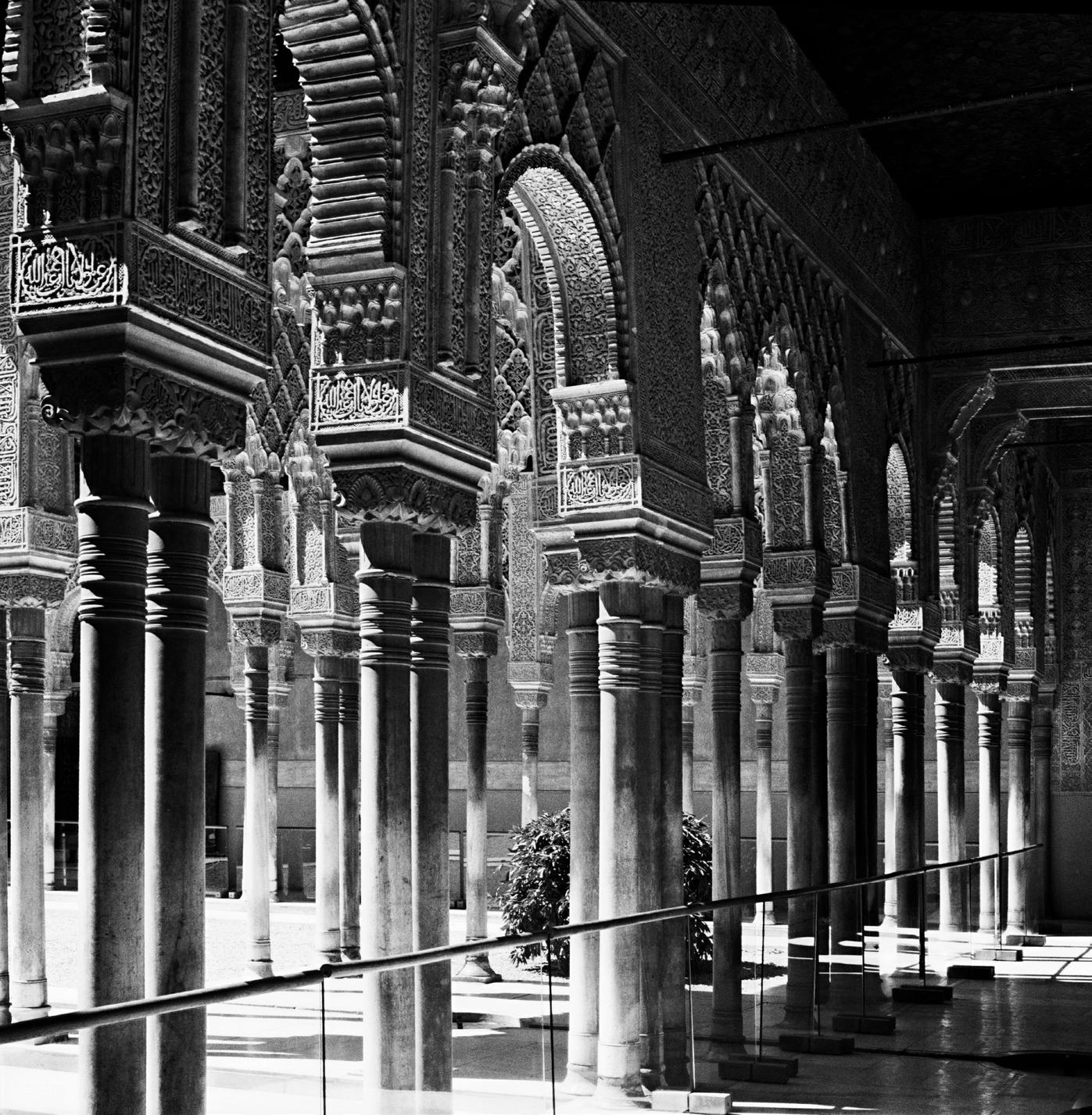
32

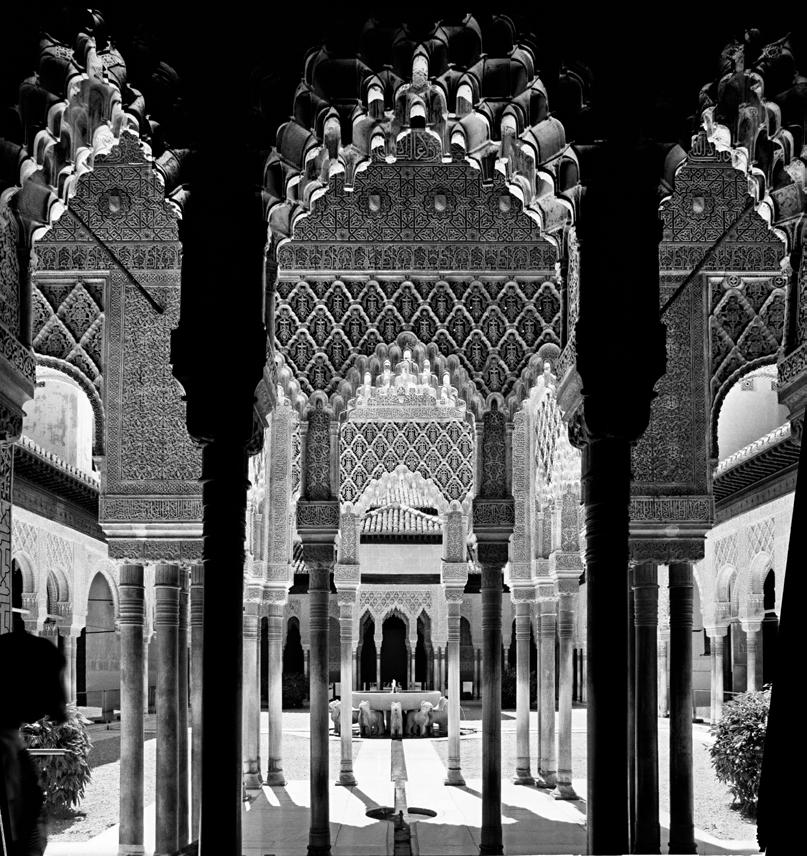
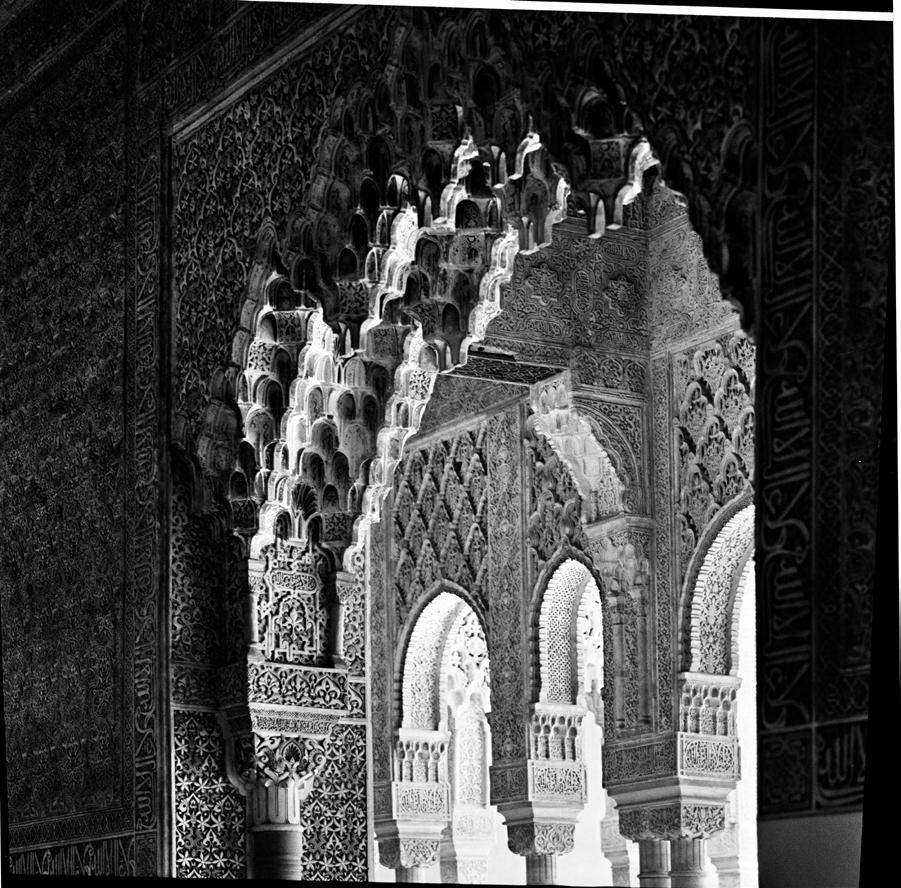
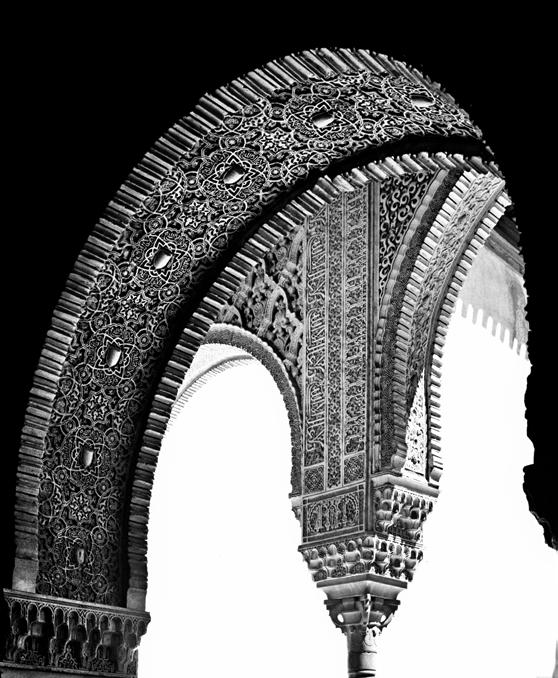
36
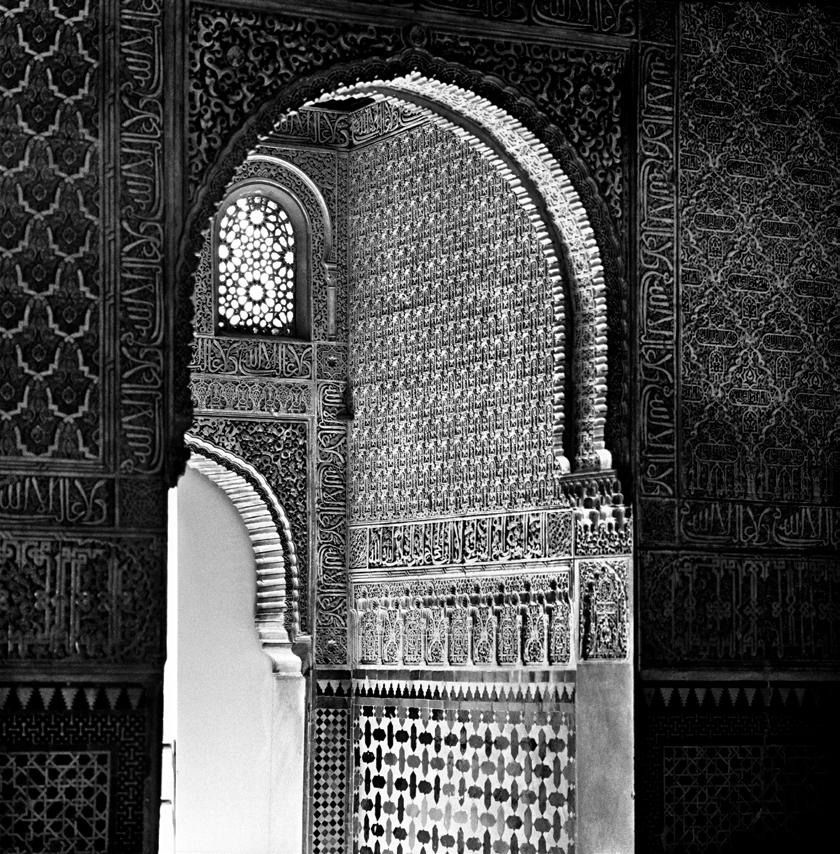
La Giralda, Siviglia (Spagna), 1994
The Giralda, Seville (Spain), 1994
Nel XII secolo nasce quale minareto della moschea di Siviglia, svettando sulla città ad oltre 100 metri di altezza. Convertita a torre campanaria della cattedrale, la Giralda ha sopportato il trascorrere delle epoche senza eccessivamente scomporsi; le trame decorative dei suoi trafori in mattoni erano e sono troppo eleganti per cedere alle trasformazioni culturali.
D’altronde, a quei poggioli così poco arabici – nonostante suggellino bifore almohadi – con quali convinzioni ci si può affacciare? Da quale condizione storica e religiosa osservare il mondo? La permeabilità diviene inevitabilmente regola.
Da parte sua, il fotografo sceglie di ignorare il monumento e di ritagliare la simmetria di un pensiero fatto ornamento.
Built in the 12th century as a minaret for the Great Mosque of Seville, this tower reaches a height of over a hundred metres. Later converted into the bell tower for the Christian cathedral, the Giralda has lived through the various epochs of history without becoming particularly uncomposed. The patterns of its brick latticework are too perfect to be unduly affected by cultural change.
Now we have to ask the question: with what religious convictions should we lean out onto its rather un-Arabic balconies (even though they guard Almohad-style twin lancet windows)? From what historical or religious viewpoint should we gaze upon the world below? The permeability of the architecture inevitably permeates up the mind.
For his part, the photographer chose to ignore the tower as a monument and concentrate on the symmetry of an idea translated as decoration.
38
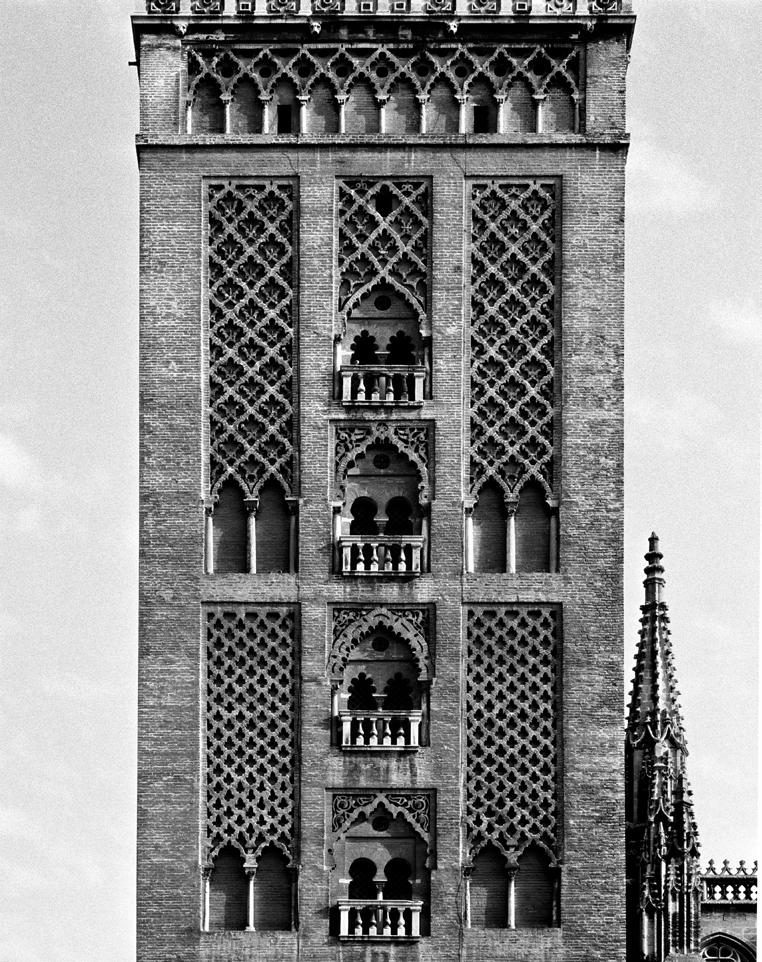
Cattedrale, Siviglia (Spagna), 1994
The Cathedral, Seville (Spain), 1994
Il grande arco a ferro di cavallo sembra suscitare il disappunto di San Pietro, statuariamente collocato a vegliare sull’accesso al Patio de los naranjos. La Porta del perdono ha forma moresca perché rimane a testimoniare la fase almohade dell’edificio (sec. XII): una moschea, destinata ad essere demolita nel Quattrocento per far posto a una colossale chiesa in stile gotico.
Così, intorno al cortile piantumato ad aranci sorse nell’arco di un secolo la Cattedrale di Siviglia, con gli archi rampanti e i portali sui quali pinnacoli e nicchiette ogivali proliferano con la medesima disinvolta fertilità delle raggere intorno ai rosoni. E, tenuto d’occhio da Pietro, l’antico portale ha da allora continuato con i suoi battenti ad aprirsi su una Spagna più cristiana, a dividere luce ed ombra in un mondo a volte bellissimo, mai del tutto conciliato.
The grand horseshoe arch seems to engender the disapproval of Saint Peter, embodied in a statue placed over the entrance of the Patio de los Naranjos. The Gate of Pardon is Moorish in style, as it has stood since the time of the Almohad dynasty (12th century). The original mosque was demolished in the 15th century and a colossal Gothic cathedral built in its place.
The Cathedral of Seville grew up around a courtyard full of orange trees over the course of a century. The interior is a maze of gothic arches and doorways, atop which pinnacles and pointed niches proliferate with the same easy fecundity as the rays on a rose window. With Saint Peter on guard, since the end of the Arab reign, the ancient doorway has never stopped opening on a more Christian Spain, dividing light and shadow in a world that can be so beautiful, but never quite at peace.
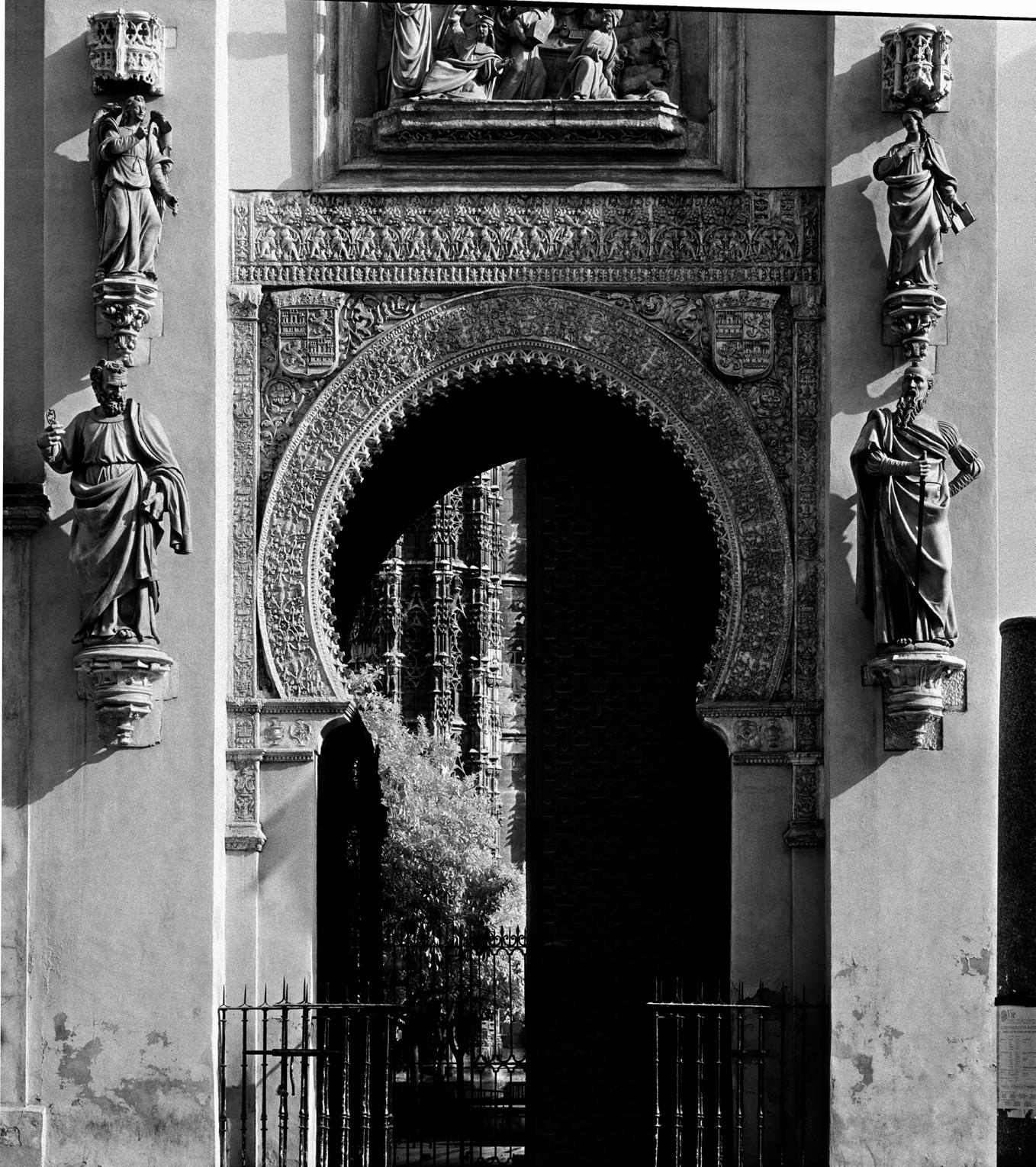
40

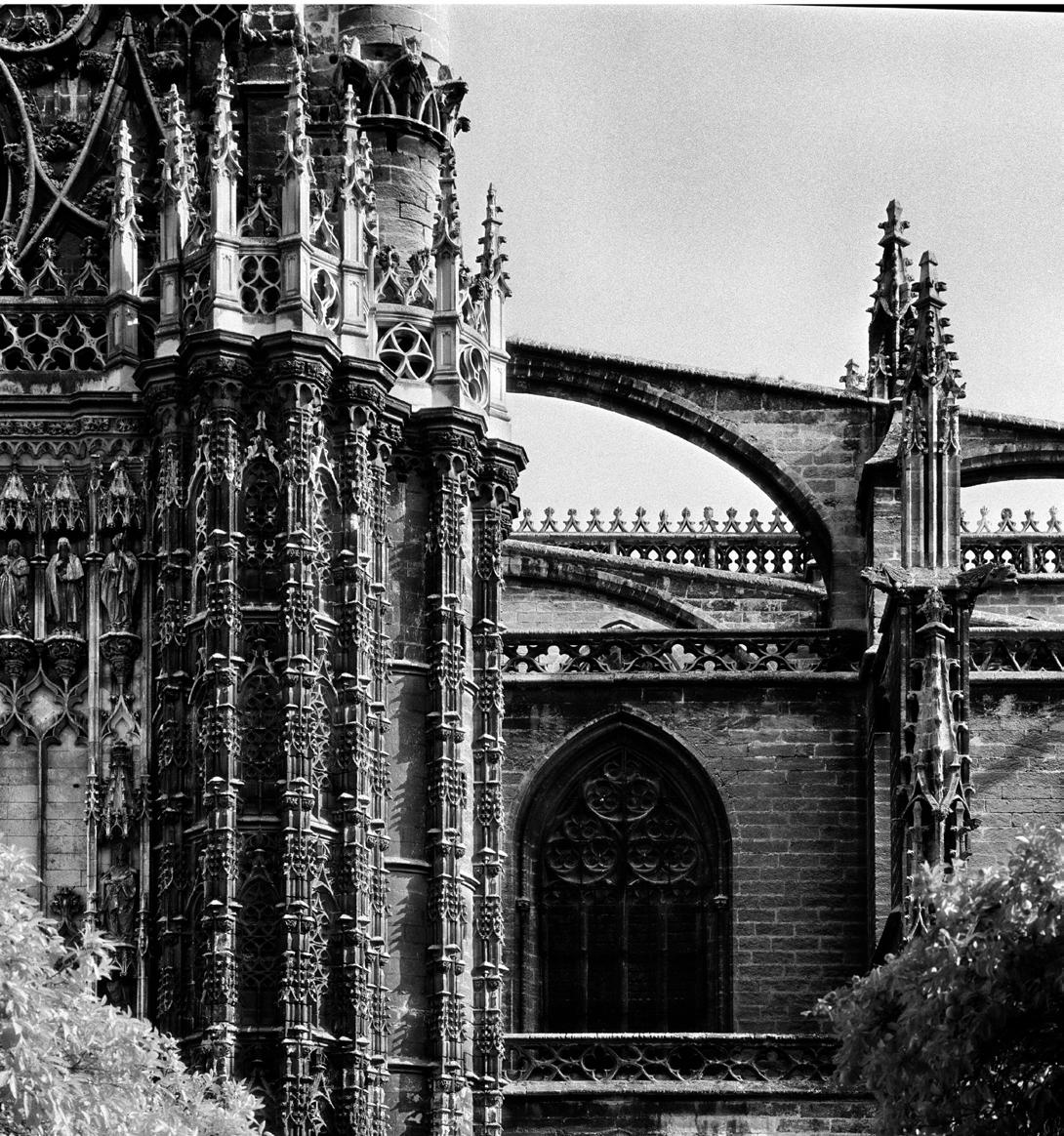

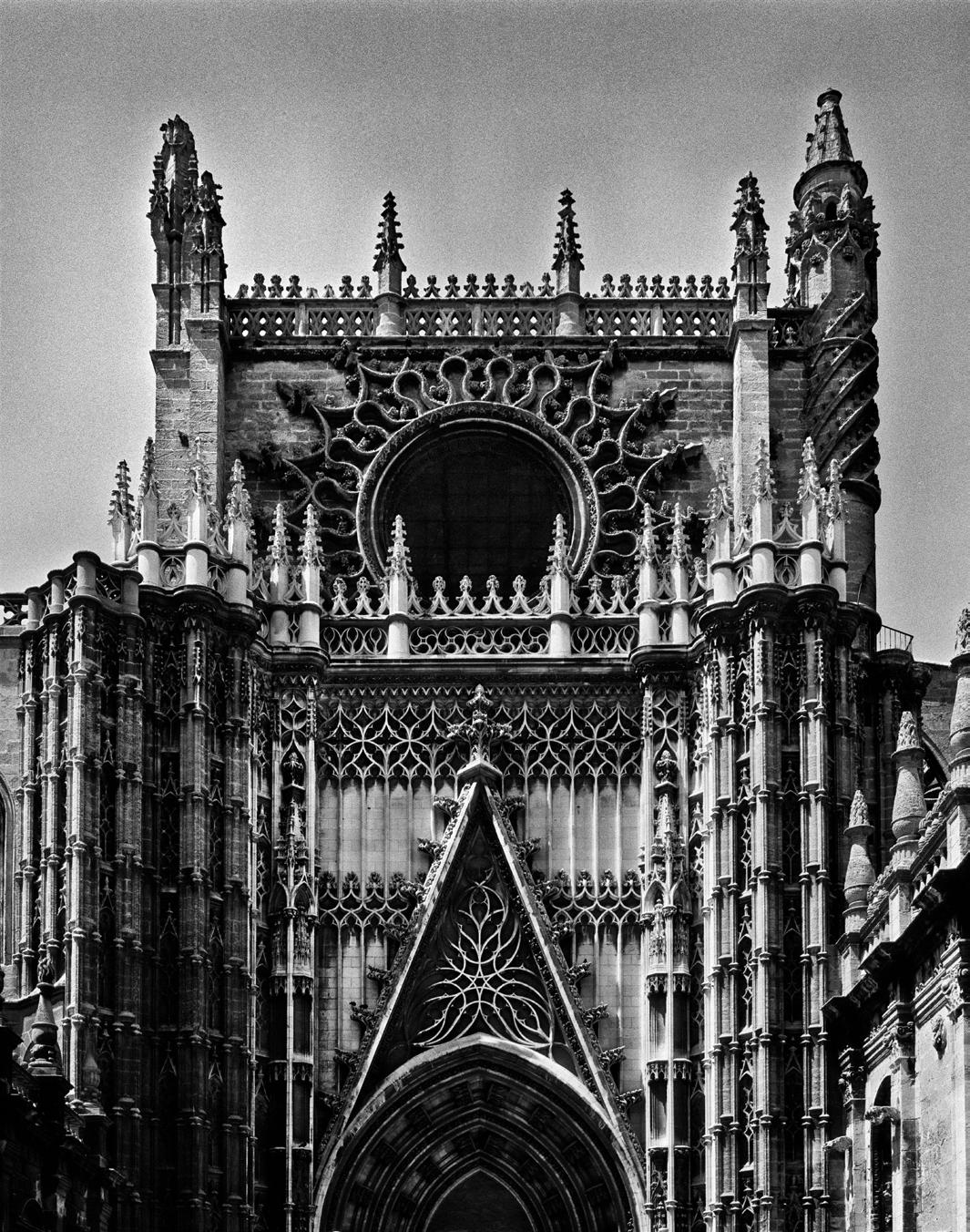
Casa di Pilato, Siviglia (Spagna), 1994
Pilate’s House, Seville (Spain), 1994
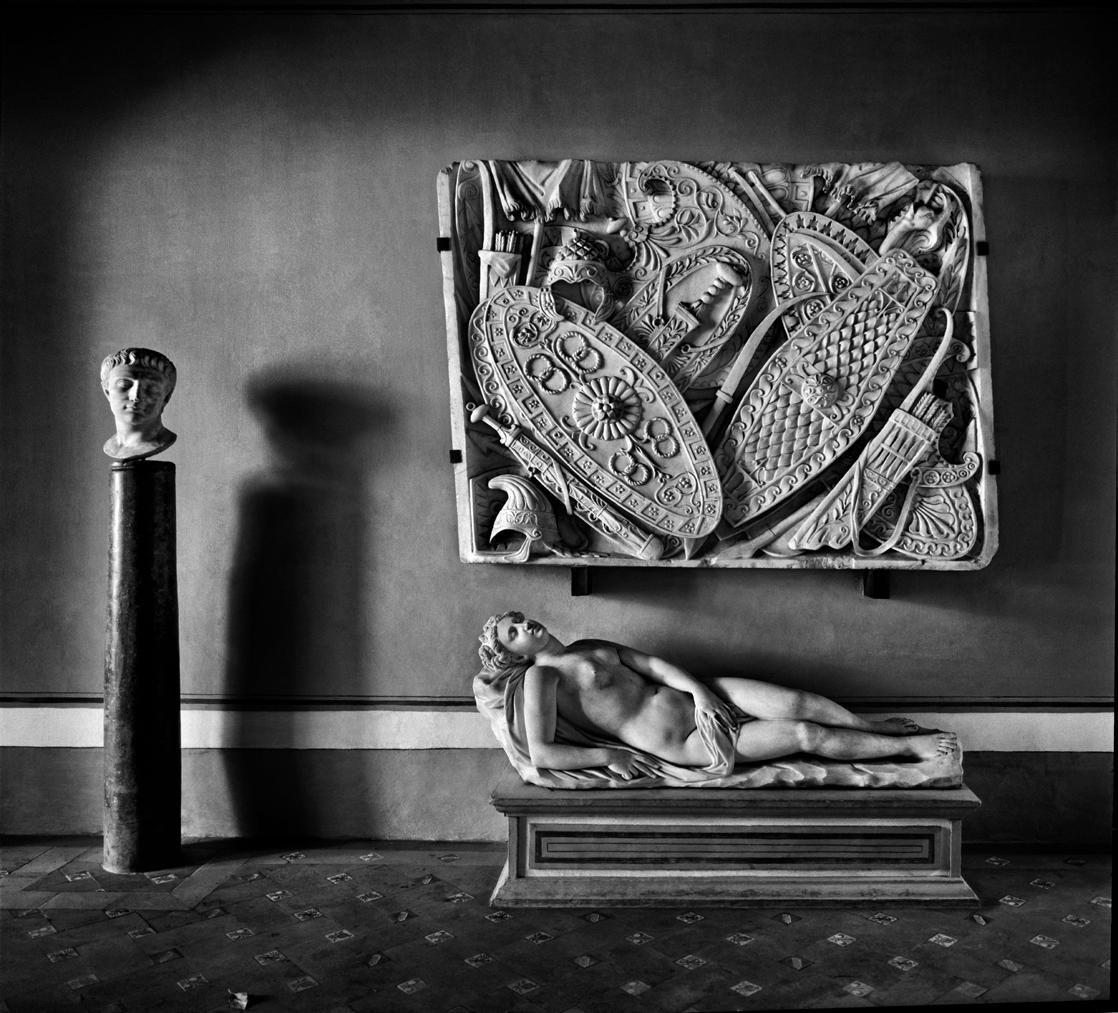
Pare che a inchiodare l’edificio al suo scomodo nome sia stata una tappa della Via Crucis con cui il marchese Enrìquez di Tarifa – agli inizi del Cinquecento – intese legare il nuovo palazzo di famiglia, in via di costruzione, alla Iglesia de Santa Cruz.
A dominare, nella Casa de Pilatos, è un’atmosfera di fusione stilistica: rinascimento e modi mudéjar, con l’aggiunta di statue romane e copie di sculture greche nel grande patio a doppio ordine di arcate. Un modello di classicismo italiano riveduto e corretto all’andalusa, in cui le opere d’arte rincorrono suggestioni diverse ma intrecciate; lo sa il fotografo, al quale basta l’esaltazione di un’ombra sulla parete per far intendere, nel sottile dissesto della geometria compositiva e attenuando il freddo sentore della pietra, la turbata attenzione di un busto per il languido corpo femminile che gli si stende accanto.
It would appear that this palace acquired its uncomfortable moniker in the early 16th century, when the Marquis Enriquez di Tarifa decided to create a link between the family residence that was being built and the Iglesia de Santa Cruz through one of the Stations of the Cross. A fusion of styles creates the unique atmosphere in the Casa de Pilatos: Renaissance arches and Mudéjar elements mix with the Roman statues and copies of Greek sculptures in the great courtyard with its double row of arches. We could say it’s an example of Italian classicism given an Andalusian twist, where the works of art come from different traditions but are interconnected; the photographer knows this and all it takes is to deepen a shadow on a wall to convey the uneasy attention a bust pays to the languid female body lying beside him, by capturing the subtle imperfection of the geometrical composition and softening the cold harshness of the stone.
44

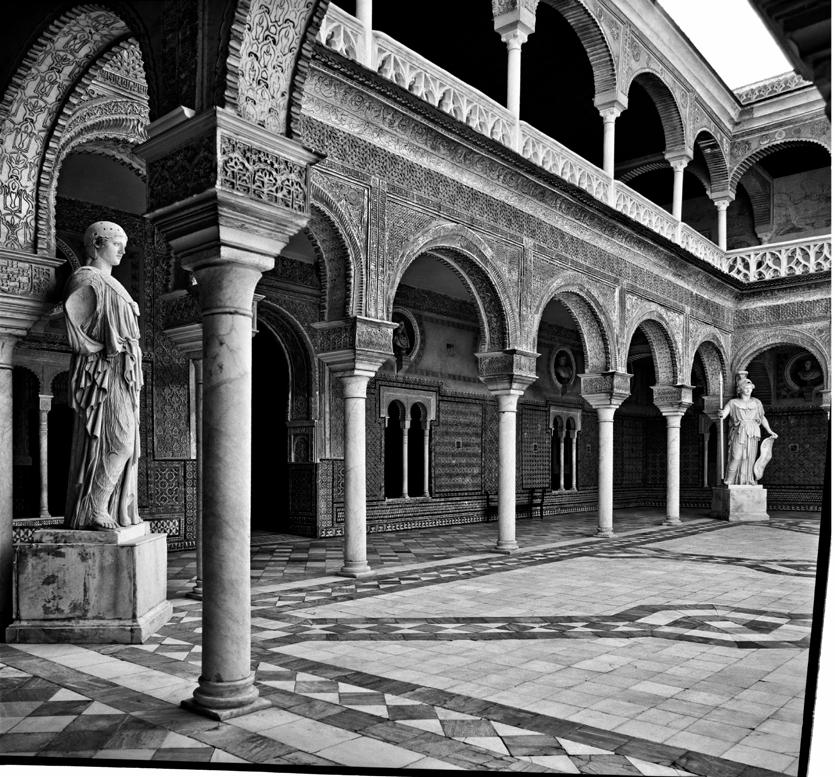
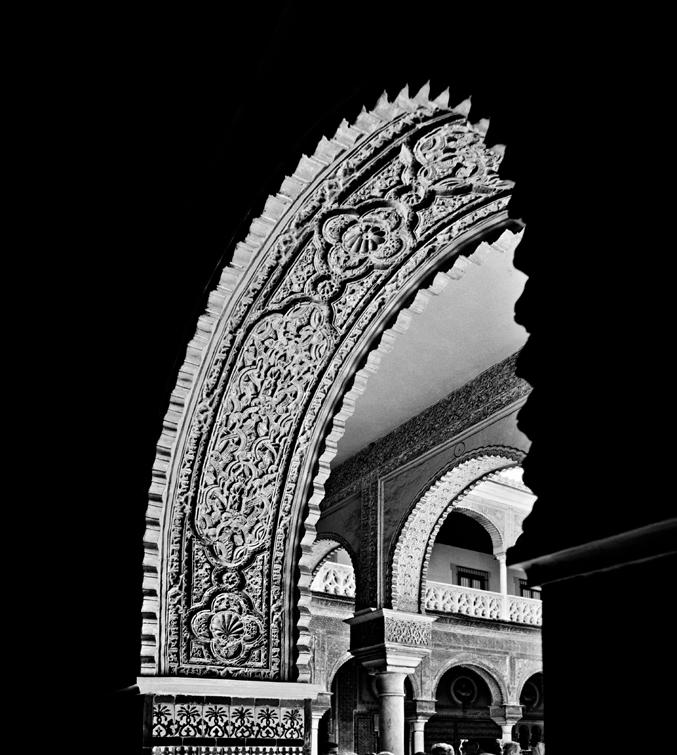
47
Moschea, Cordoba (Spagna), 1994
The Mosque-Cathedral of Córdoba (Spain), 1994
L’interno della moschea di Cordoba venne concepito come uno spazio alveolare, capace di comprimersi e dilatarsi visivamente nel respiro dei fedeli. E in effetti conobbe numerosi ampliamenti successivi, in una storia costruttiva che dal 780 – ai tempi del califfo omayyade AbderRahman I – arrivò al 990.
Le 850 colonne di granito, con il loro doppio ordine di archi, orchestrano un labirinto, un ambiente privo di univoca impostazione prospettica, che si espande in ogni direzione. Il fotografo è convinto che sia necessario sperimentarne umilmente l’incanto, e dunque lo inquadra mettendo l’obiettivo al livello del pavimento: a terra, come i piedi dei fedeli e le ginocchia piegate in preghiera.
The interior of the former Great Mosque of Córdoba was conceived as an alveolar space that would appear to expand and contract as the faithful inhaled and exhaled. As it happens, it underwent a series of expansions from the time of its first being built in 780 – under the reign of the Umayyad Calif Abd-er-Rahman I – up to 990. Its 850 granite columns holding up double rows of arches map out a labyrinth, a space without a unitary visual scheme that expands in all directions. The photographer is convinced that its enchantment must be felt with humility, so he has set his lens on the floor, on the same level as the knees of the faithful bent in prayer.
48
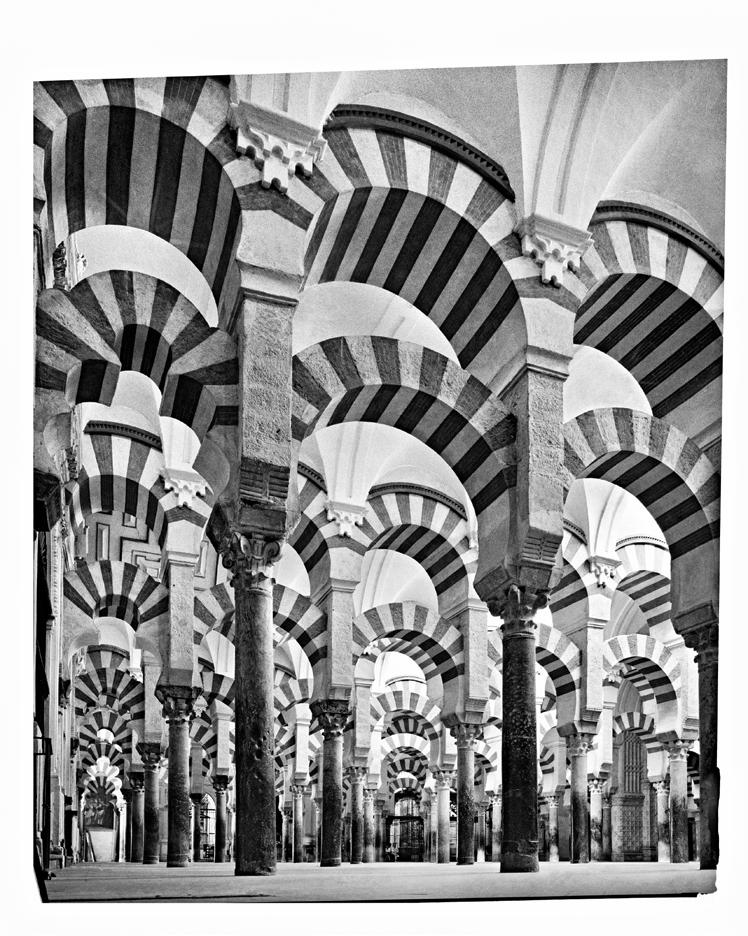
49
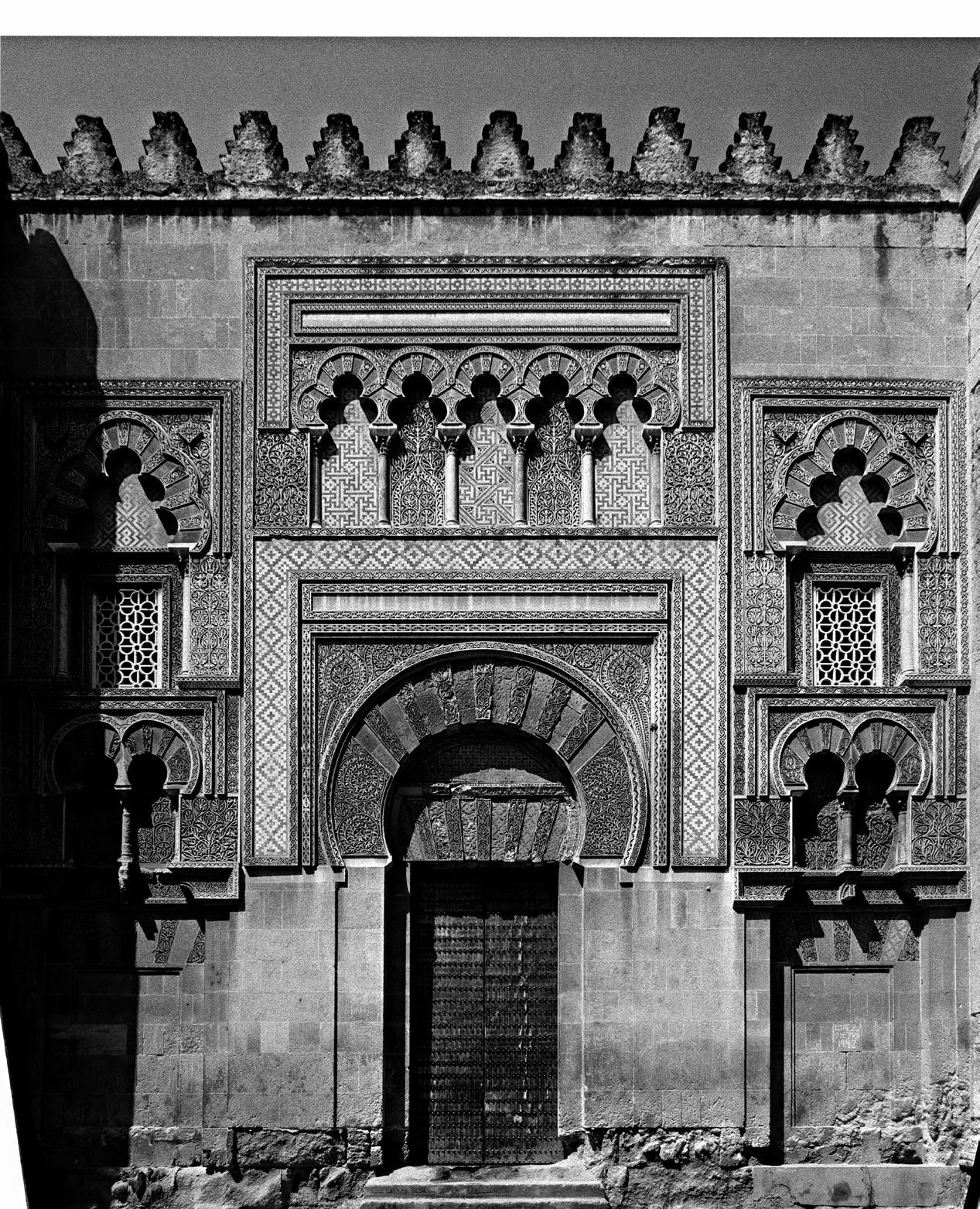
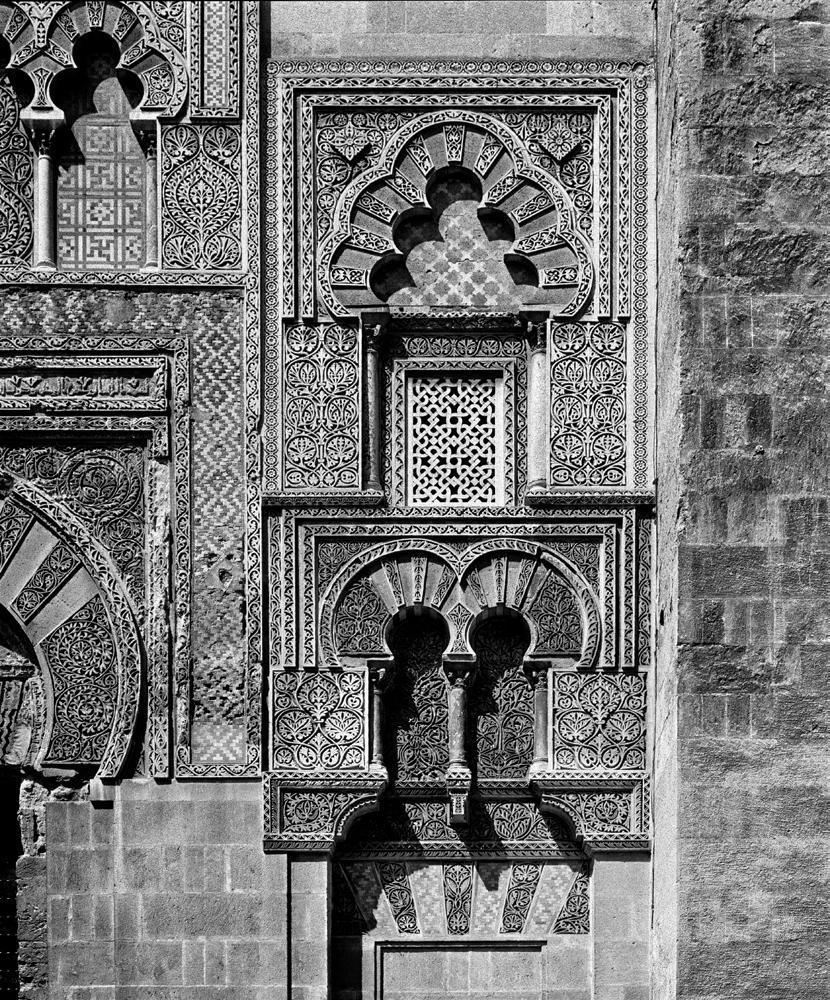
Guggenheim Museum, Bilbao (Spagna), 2007
Guggenheim Museum, Bilbao (Spain), 2007
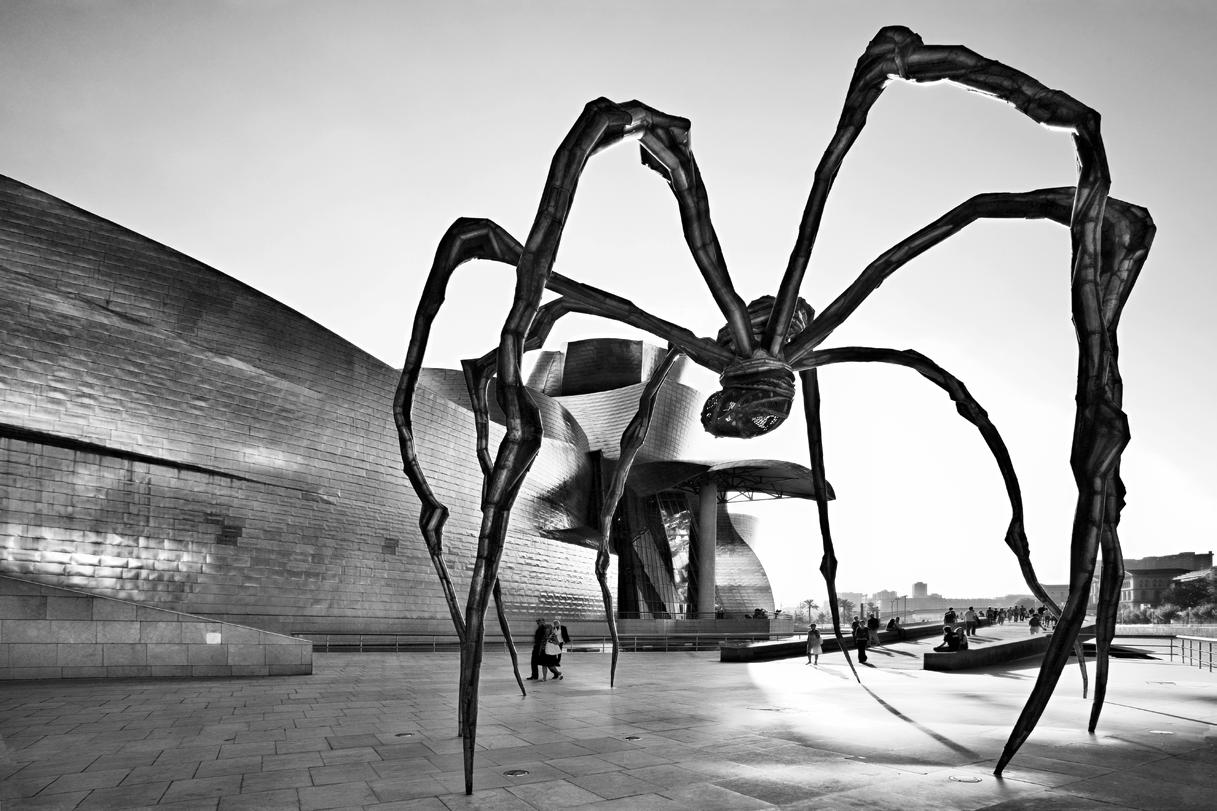
È un edificio che, nel 1997, ha cambiato la storia e le strategie dei musei contemporanei. Prima di allora, il Guggenheim di New York firmato da Frank Lloyd Wright e la Neue Nationalgalerie a Berlino di Mies Van der Rohe spiccavano per originalità e rigore delle forme, ma la creatura corazzata in titanio di Frank O. Gehry ha ribaltato ogni canone. Enorme scafo arenato sulle rive del fiume Nervión, nei Paesi Baschi, è concepito per esporre anzitutto se stesso. Se contiene opere d’arte, lo fa con la stessa indifferenza con cui il Pescecane di Collodi lasciava spazio nel suo stomaco a Geppetto e Pinocchio; le ospita paziente, ma ha piena consapevolezza della propria superiorità.
When it opened in 1997, this building changed the history and strategies of contemporary museums. Before then, the Guggenheim Museum in New York, designed by Frank Lloyd Wright, and the Neue Nationalgalerie in Berlin by Mies Van der Rohe had been the benchmarks of originality and geometrical rigour, but the titanium-shelled creature spawned by Frank Gehry revolutionized the genre.
The massive hull beached on the banks of the Nervión river, in the Basque Country, was conceived first and foremost as a monument to itself. Yes, it houses works of art, but with the same indifference that the whale that swallowed up Geppetto and Pinocchio allowed them to live in his stomach. It knows they’re there, but it’s quite aware of its own infinite superiority.
52

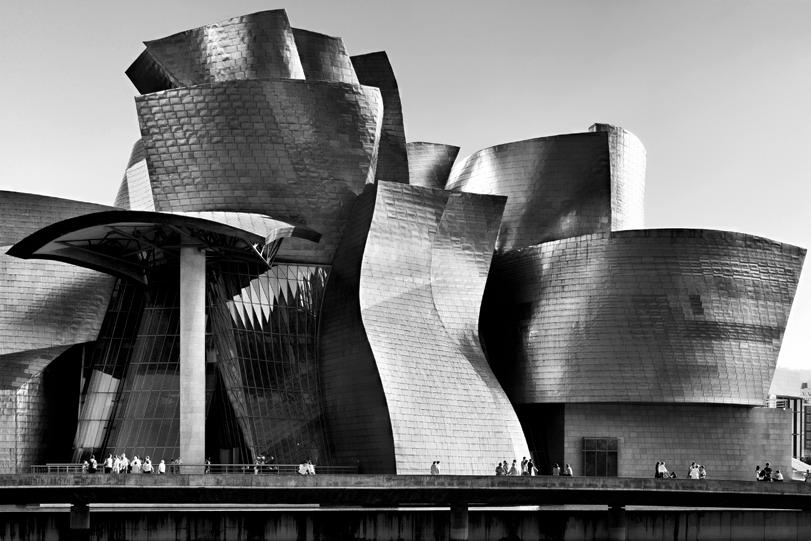
54
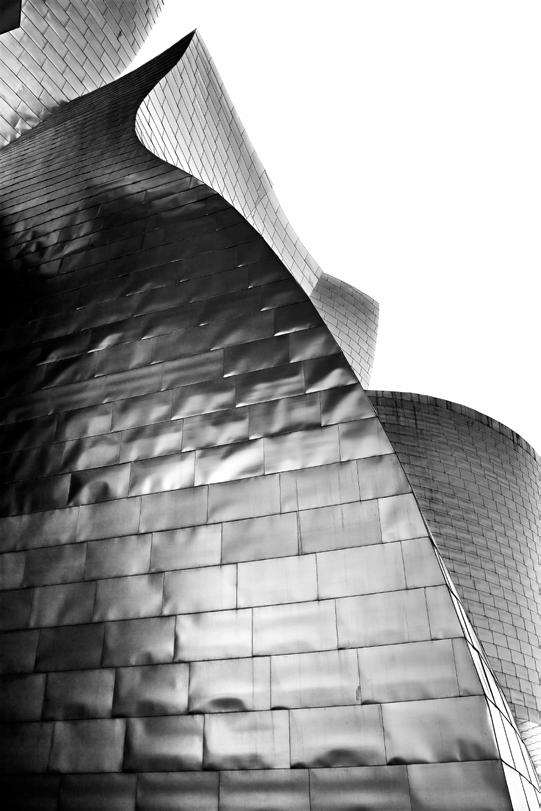
55
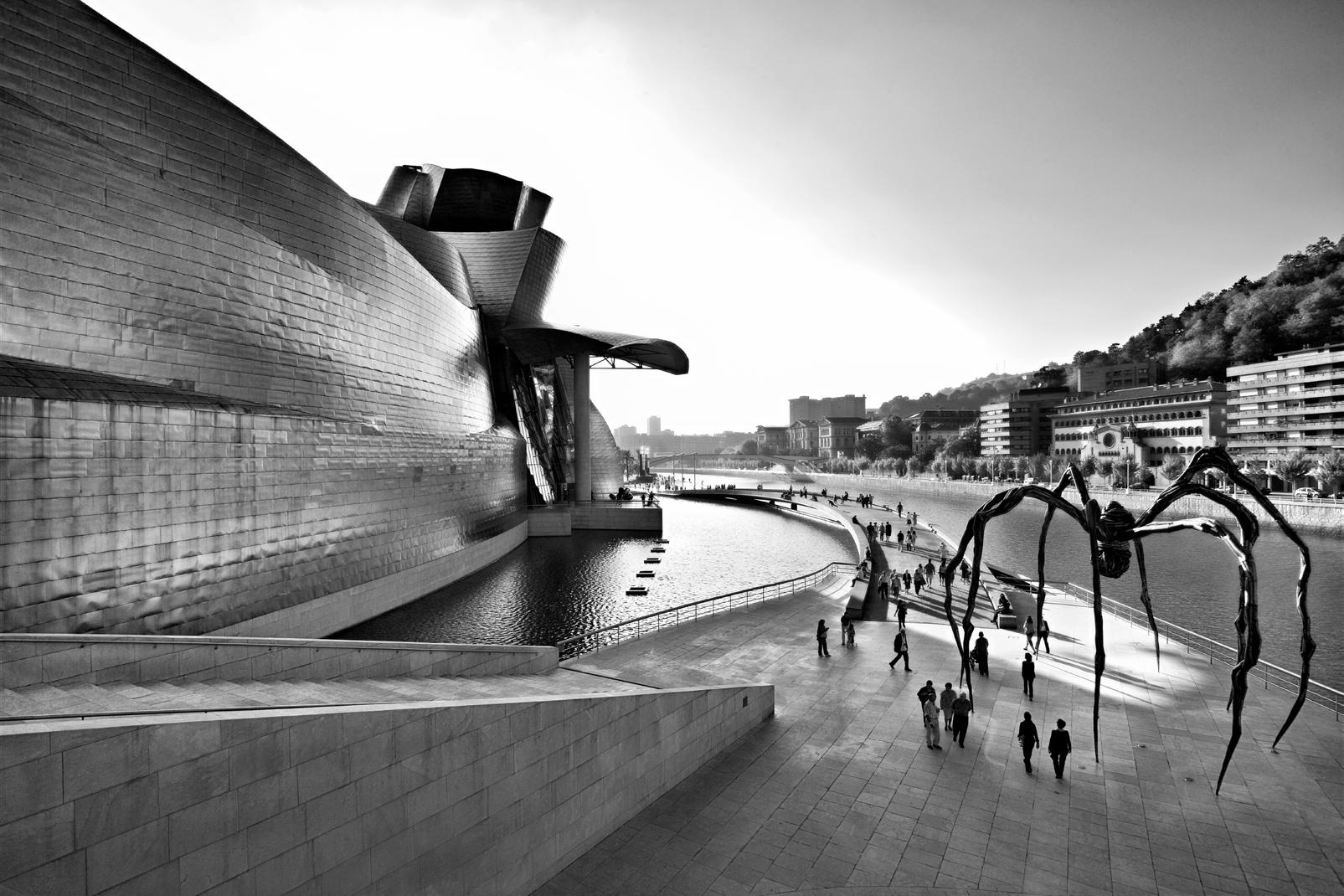

Egitto, 1980
Egypt, 1980
Le colonne del tempio di Kom Ombo, non distante da Assuan, risalgono alla dinastia tolemaica (305-30 a.C.) e portano sulla pelle i segni di quanto rigido fosse, nell’arte egizia, il rispetto delle convenzioni. Più di mille anni le separano dai chiaroscuri di altre pietre, nel tempio di Hatshepsut presso la Valle dei Re, ma le loro figure conservano i medesimi profili stilizzati; entrambi appartengono a un sistema di segni che non fa differenza fra scrittura e rappresentazione, resi visibili da una luce egualmente acuminata e capaci di tradurre in movimenti da automa il senso di un esistere regale.
Sulla loro efficacia vigilano da 4500 anni, intagliate nella pietra a El Giza, la Sfinge e la piramide di Micerino; due enigmi che la scelta di diaframma fonde in un unico persistere simbolico.
The columns of the Temple of Kom Ombo, not far from Assuan, date back to the Ptolemaic dynasty (305-30 BC) and are a clear sign of how rigidly conventions were adhered to in ancient Egyptian art. More than a thousand years had passed since the chiaroscuro of other stones –in the Temple of Hatshepsut in the Valley of the Kings – but they still show the same stylized forms. Both belong to a system of symbols where writing and figural representation are one and the same; they are rendered visible by the same sharp light and share the ability to represent the purpose of a royal existence through the same schematic brushstrokes.
At El Giza, the Sphinx and the pyramid of Menkaure have been watching over them for 4500 years; the choice of lens aperture merges these two enigmas into a single symbolic tradition.
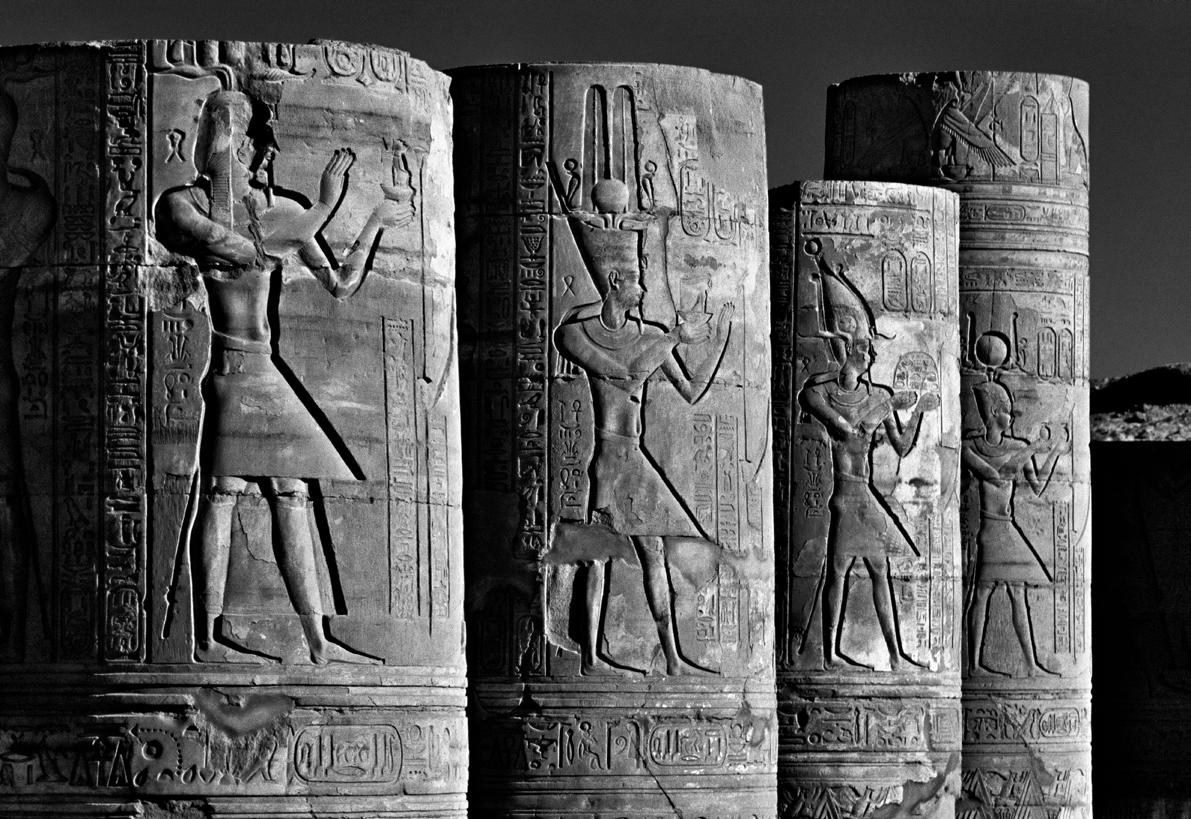
58

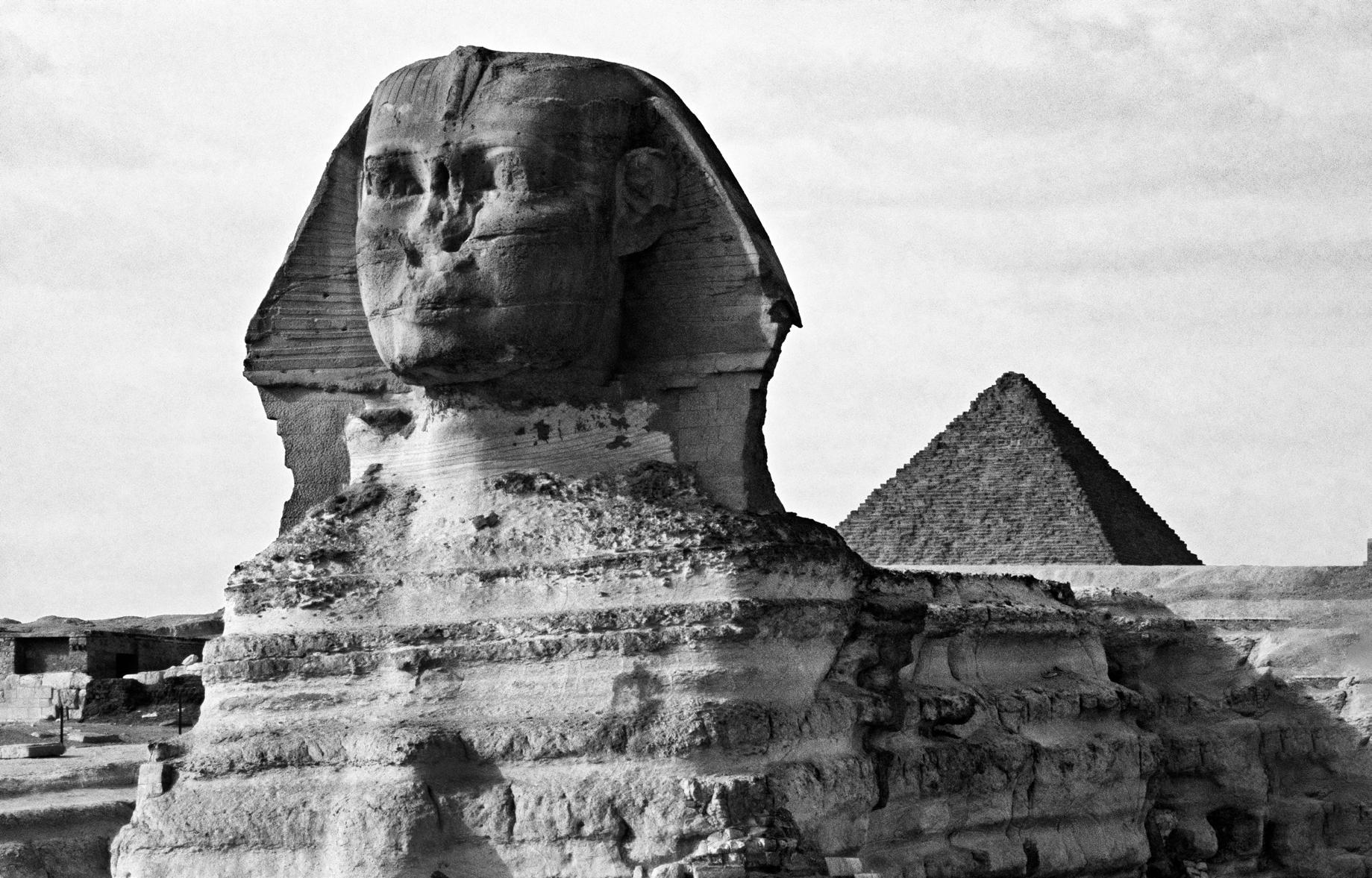


62
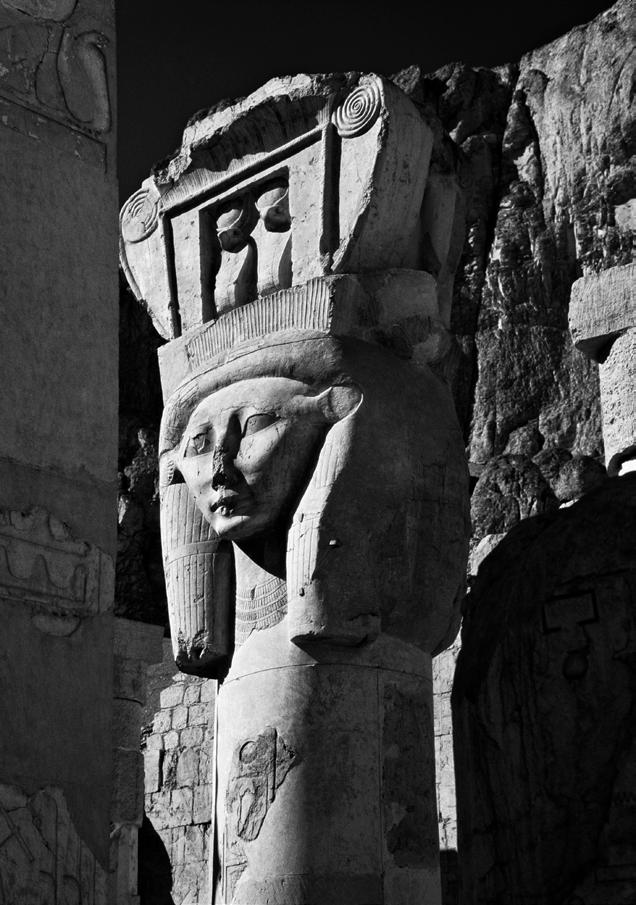
Leptis Magna, Libia, 2002
Leptis Magna, Lybia, 2002
Settimio Severo, agli inizi del III secolo d.C., volle fare del suo luogo natale una delle più belle città dell’impero romano. E tale ce la restituisce Elio Ciol nei suoi scatti.
A dispetto dell’erba che spunta dal selciato e tra i frammenti di trabeazione, i resti archeologici parlano di un progetto ambizioso: infilate di archi trionfali, rilievi che dovevano conferire al Foro Severiano una imponenza estetica che ancora aleggia, come ancora serpeggia la chioma di Medusa, imitata all’intorno dal ritorcersi degli arbusti.
E infine l’Arco di Settimio Severo, al cui labirinto di cornici e scanalature veniamo introdotti dal fotografo come se giungesse a noi da un’altra dimensione, troppo elegante per appartenere alla realtà di oggi: «brilla come la luna, come materia morta incrostata di luce» (L. Glück).
At the beginning of the 3rd century AD, Emperor Septimius Severus decided to make his birthplace into one of the most beautiful cities in the Roman Empire; Elio Ciol does his wish justice. Despite the tufts of grass poking through the broken paving stones and fallen cornices, the remains of the city show clearly what an ambitious project it was – rows of triumphal arches were designed to give the Severian Forum an imposing air, one which still hovers today, just as the snakes on Medusa’s head still writhe and twist, echoed by the crooked bushes around the site.
At the end of the procession is the Arch of Septimius Severus. The photographer introduces us to its maze of cornices and fluting as if it came from another dimension, one which is too elegant to belong to today’s reality: “Now the earth glitters like the moon, like dead matter crusted with light”. (L. Glück)
64
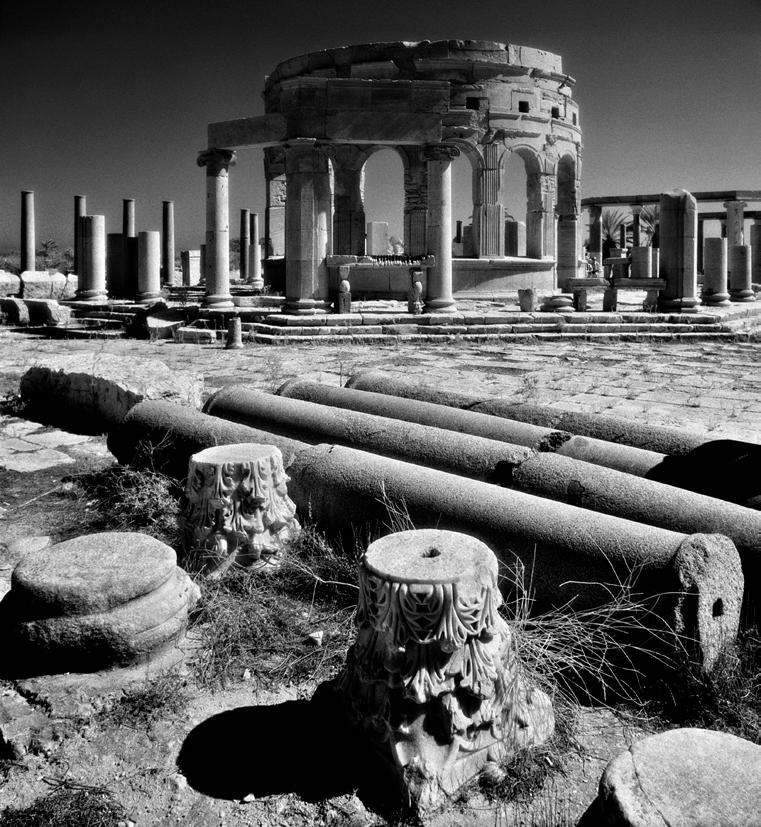
65
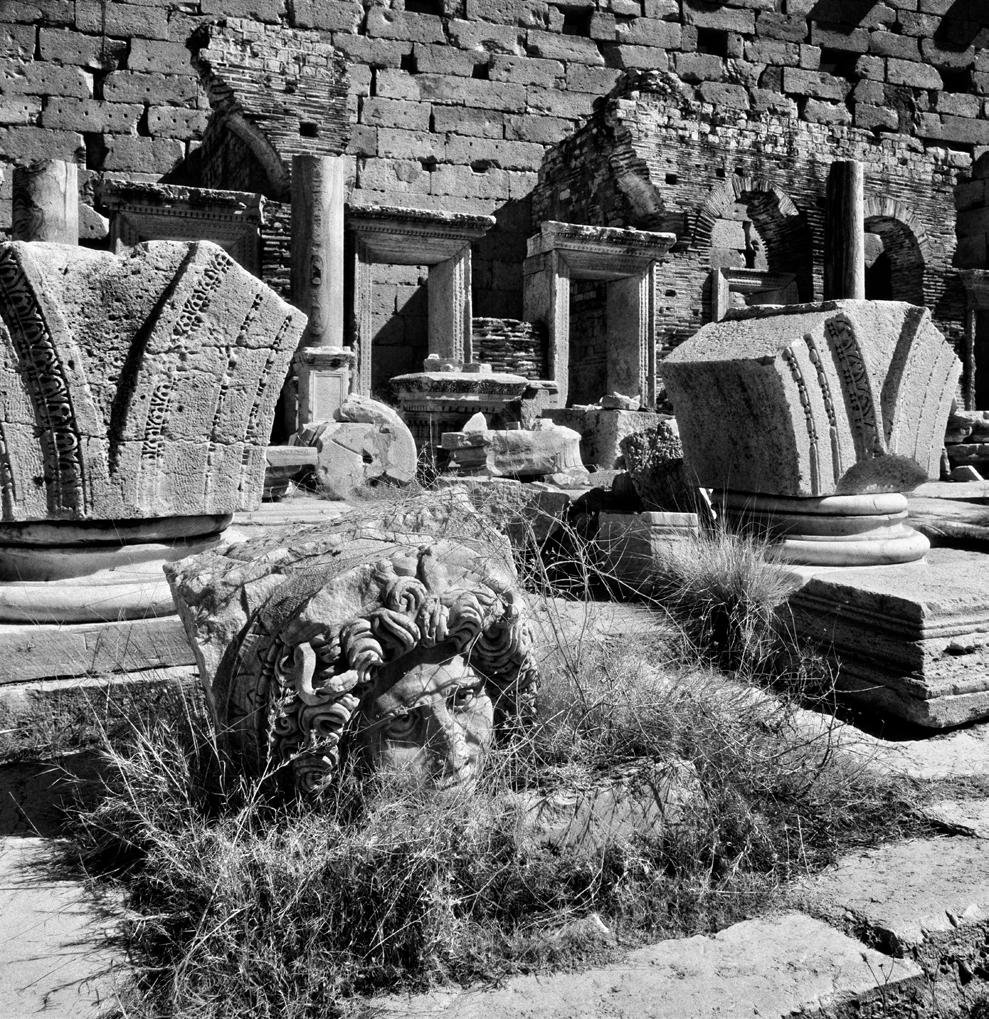
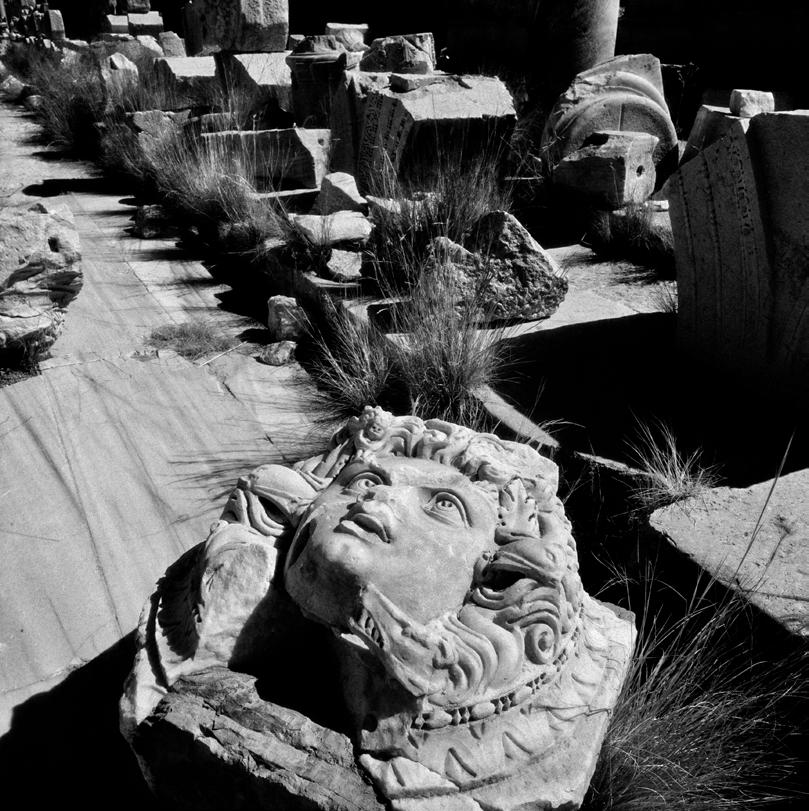


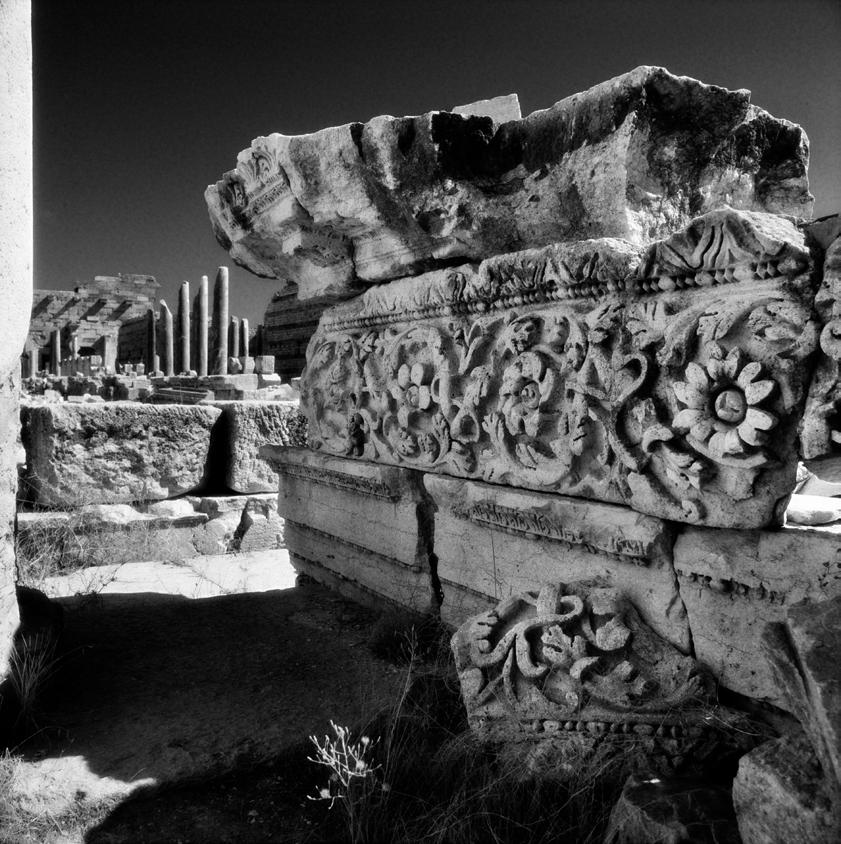
Wadi Mathendush, Libia, 2001
Mathendush Wadi, Lybia, 2001
I graffiti rupestri del Sahara libico, eseguiti in prevalenza nel Neolitico, occupano lastre di arenaria che migliaia di anni fa dovevano essere lambite dalle acque dei fiumi.
Difficile, oggi, immaginare vegetazione rigogliosa vicino alla silhouette dell’uomo intento a confrontarsi con l’antenato di un elefante; il paesaggio ora è arido e tagliente come le incisioni che sintetizzano i tratti dell’animale e della sua andatura, con solchi profondi accostati a incavi più leggeri. Un’alternanza riproposta dal coccodrillo che occupa maestosamente un altro, intero macigno, o dalle due giraffe che si offrono all’obiettivo in una sola inquadratura; gli antichi scultori ne hanno ritratta una con scrupolo realistico, l’altra affidandosi a una splendida sintesi lineare, con cui pare adesso gareggiare la buia fenditura che le separa… Insondabile quanto il passato da cui le immagini provengono.
The rock graffiti of the Lybian Sahara Desert, mostly dating from the Neolithic period, decorate slabs of sandstone that thousands of years ago formed the banks of rivers. It’s hard now to imagine lush vegetation surrounding the image of a man intent on hunting an ancestor of the modern elephant; the landscape today is dry and harsh, like the picture that conveys the features of the animal and its gait in a few scratches, with a mixture of deep grooves and shallower furrows. This alternation can be clearly seen in the crocodile that majestically occupies the whole of another rock, and in the two giraffes seemingly posing together for the camera; the sculptors of old depicted one of them with incredible realism, while the other is stylized, reduced to a few lines. The two seem almost to challenge each other across the dark crevice that divides them … as dark and inscrutable as the age of their creators.

70

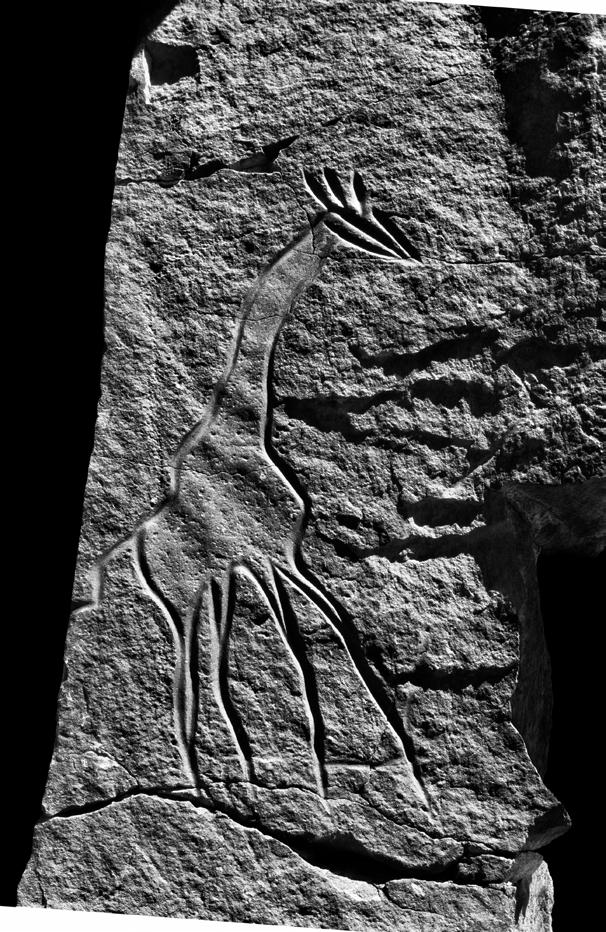
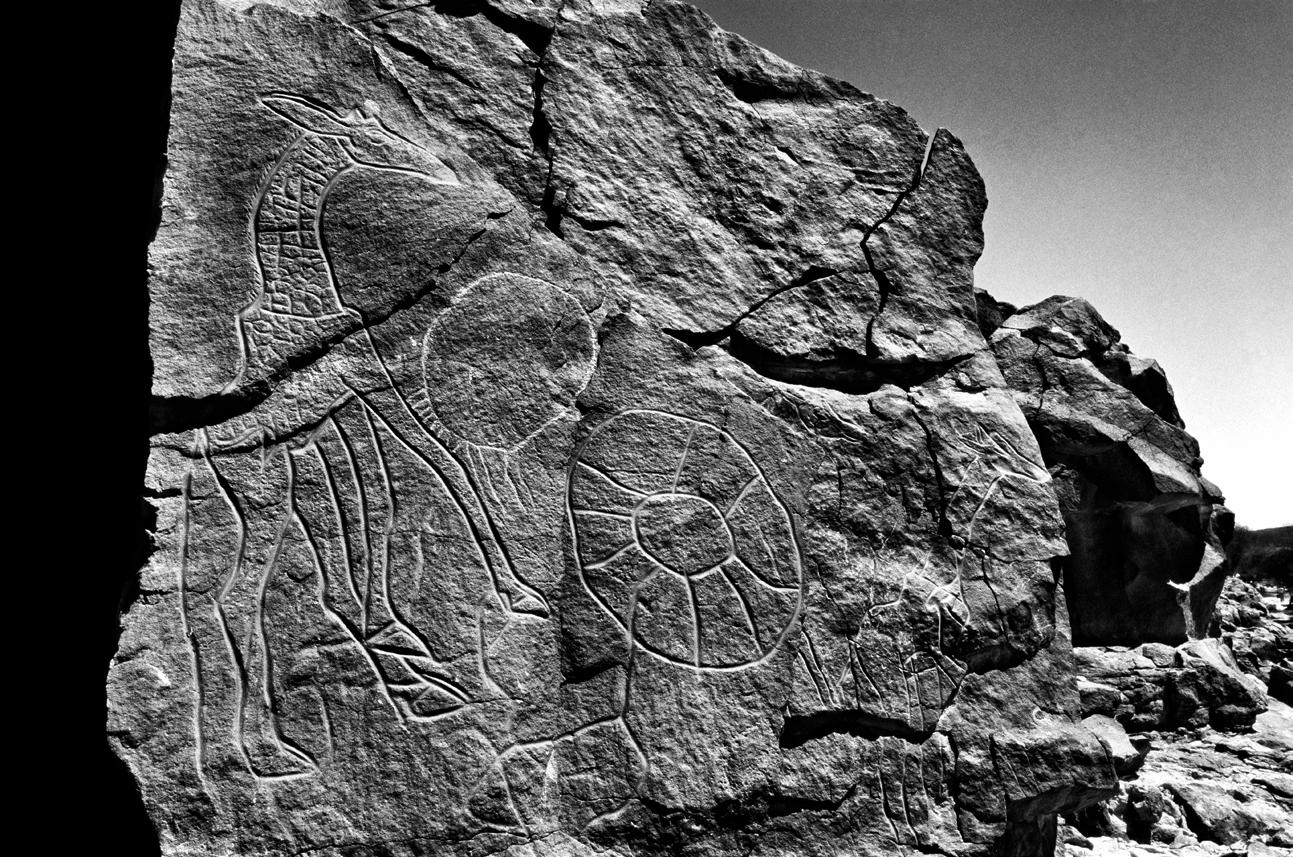
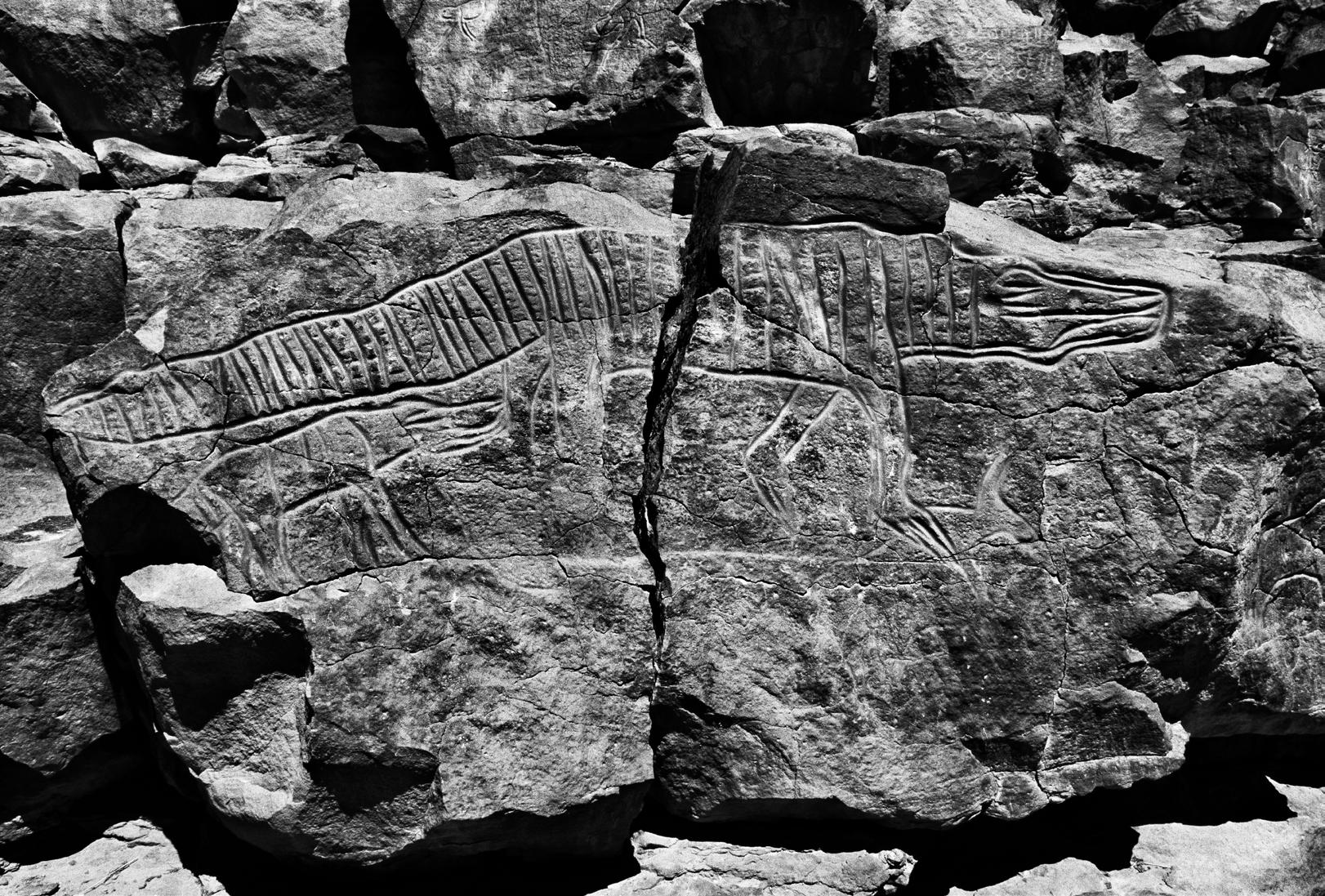

Zorats Karer, Armenia, 2005
Sembrano interventi di Land Art, per come condizionano la nostra percezione del paesaggio, ma risalgono ad almeno settemila anni fa.
Zorats Karer si trova su un altopiano, a quasi 1800 metri di altezza. Di qua non è passato Richard Long, e il cerchio di pietre da cui si dipartono gli allineamenti di megaliti pare offrire una commistione delle logiche dispositive dei Cromlech e Menhir che si possono incontrare in Europa del nord, da Stonehenge a Carnac.
Piantati nel terreno come sentinelle, i macigni intrattengono da millenni un misterioso, silente dialogo fra di loro e con il vento che rimescola le nubi in cielo, sull’altopiano; un sussurro talmente impercettibile che bisogna fermare un attimo il tempo – e il respiro – per provare a distinguerlo.
They feel like Land Art, the way they alter our perception of the landscape, but they date back at least seven thousand years.
Zorats Karer is located on a plateau almost 1800m above sea level.
Richard Long hasn’t been at work here, and the stone circle the lines of megaliths are arranged around seems to be a summary of the philosophies behind the arrangement of Cromlechs and Menhirs found in northern Europe, from Stonehenge to Carnac.
Standing erect like sentinels, the rocks have been engaging for millennia in a mysterious, wordless dialogue with each other and with the wind that whips up the clouds above the plateau; it’s such an imperceptible whisper that you have to stop time and hold your breath to have any chance of making it out.
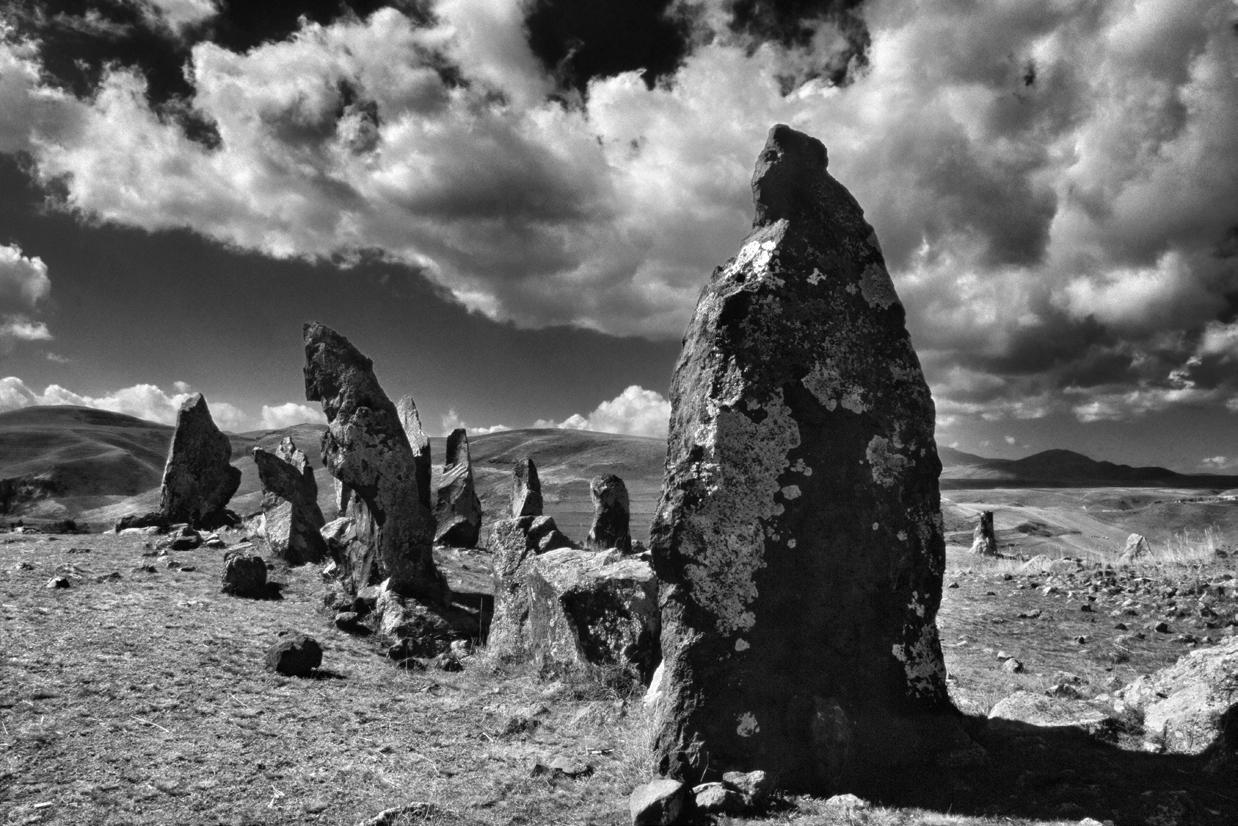
76

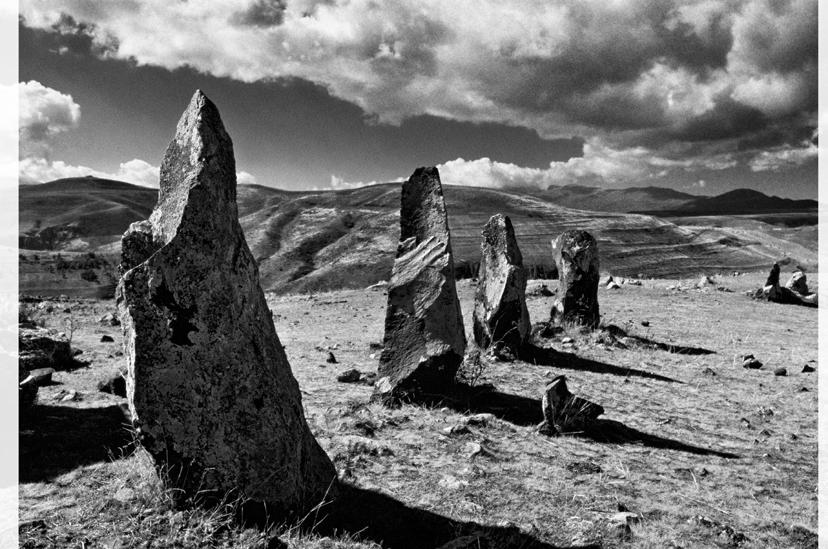
78

79
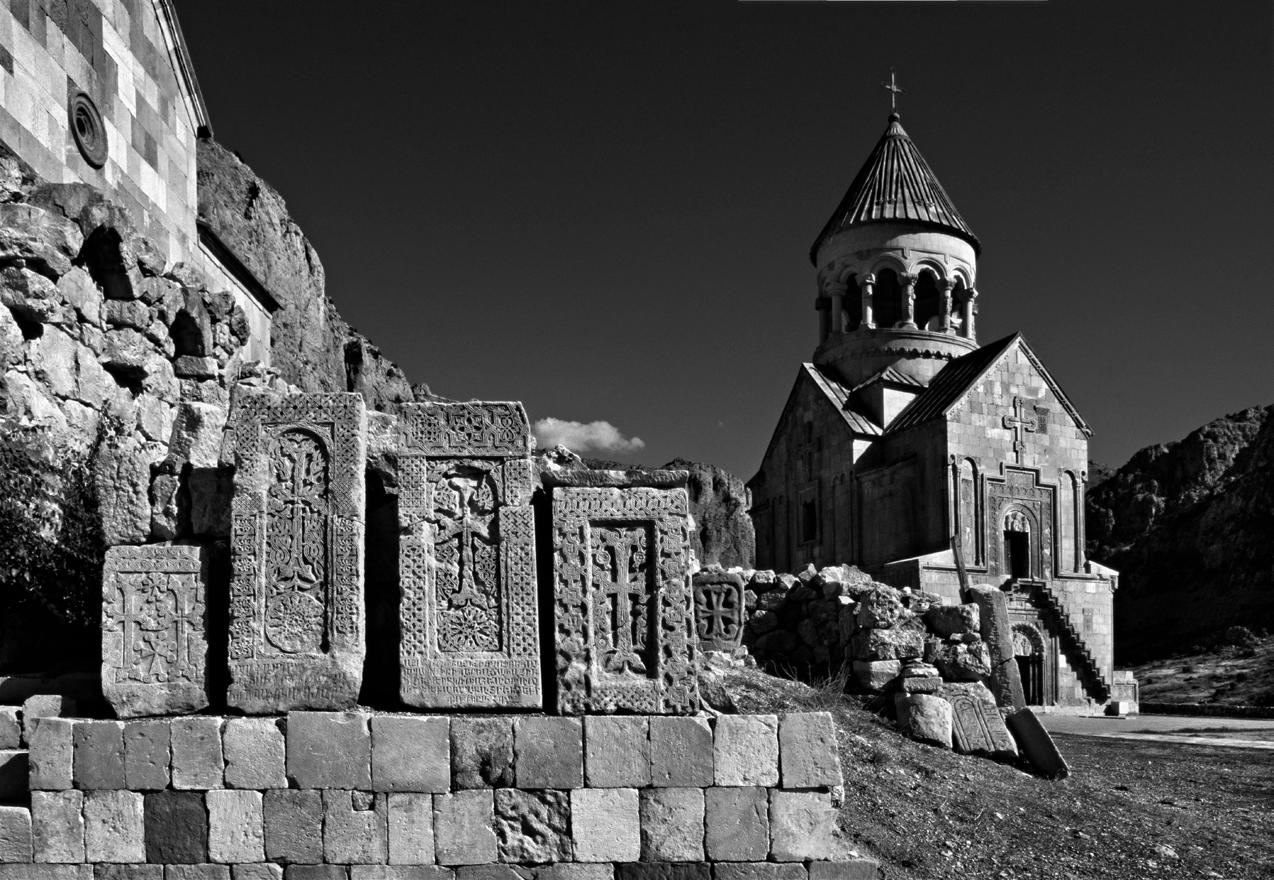
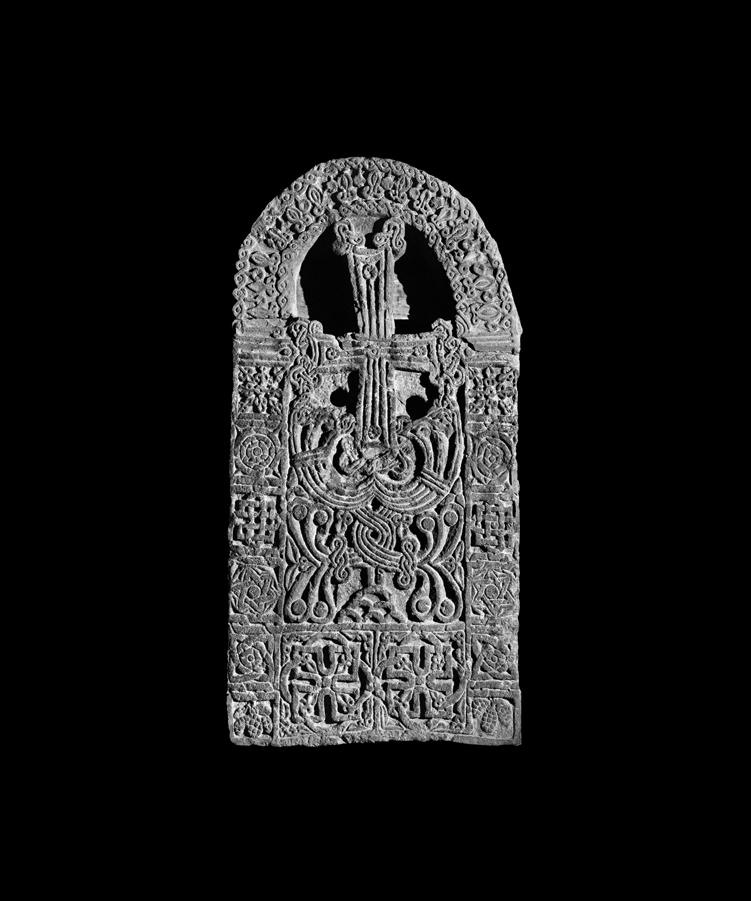

Karakorum, Mongolia, 1987
Karakorum, Mongolia, 1987
Siamo nel vasto altopiano della Mongolia, nel sito in cui sorgeva nel XIII secolo la capitale di un grande impero. Incuneato fra Russia e Cina, questo è un oriente ben diverso da quello delle poetiche animazioni di Miyazaki, ma come non pensare alle sue creature di fronte agli animali che – pesanti come un macigno o sospesi a una gronda – vivono sotto un cielo di nuvole erranti?
Pure il Monastero buddista di Erdene Zuu, al cospetto di nubi così poderose, sembra rimanere in rispettosa attesa; e così fa da ottocento anni la longeva tartaruga in primo piano, anche se ora quel cielo non deve più sostenerlo, come simbolicamente accadeva quando una colonna-obelisco le premeva sul carapace.
We find ourselves in the vast plains of Mongolia, in the place where the capital of a great empire stood in the 13th century. Nestled between Russia and China, this East is quite different from the one depicted in Miyazaki’s poetic animations, but how can we fail to be reminded of his fantastical creatures when looking upon animals that, some as heavy as rocks while others poised at the tips of water spouts, live under a sky full of racing clouds?
Even the Buddhist monastery of Erdene Zuu seems to respectfully wait for orders from these mighty accumulations of vapour, just as the longevous tortoise in the foreground has done for eight hundred years, even though he no longer has to hold up the sky as he did when he bore an obelisk on his carapace.

82

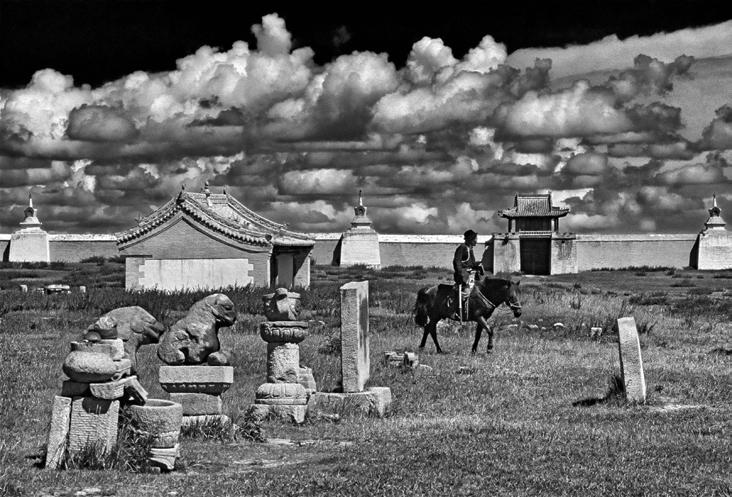
84
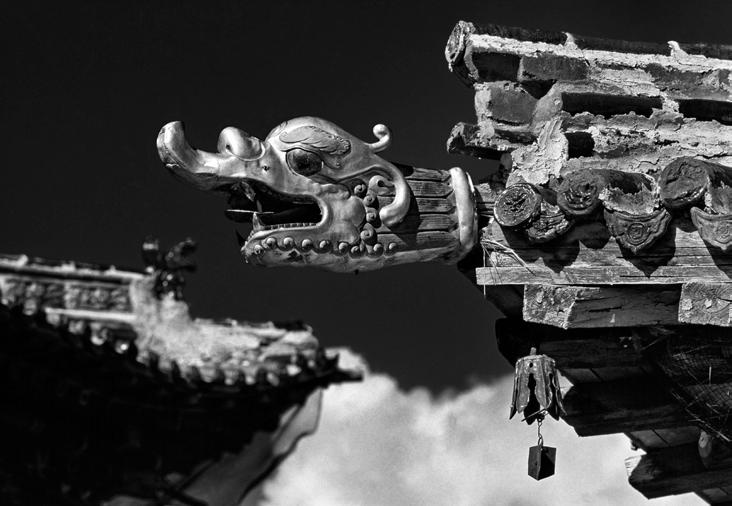
85
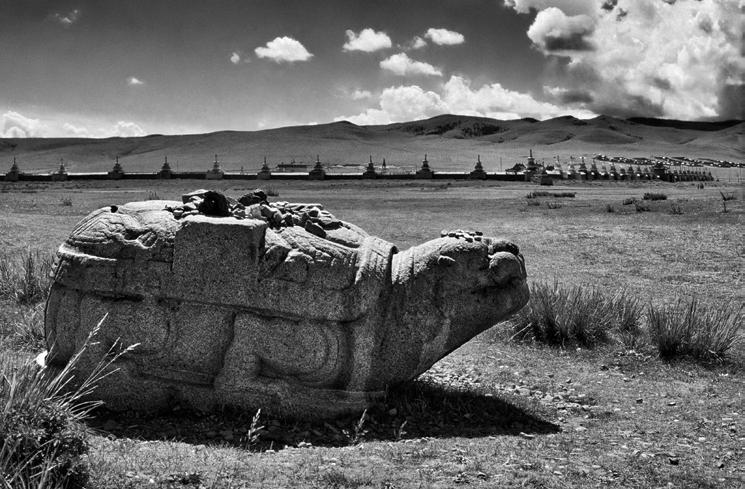
86
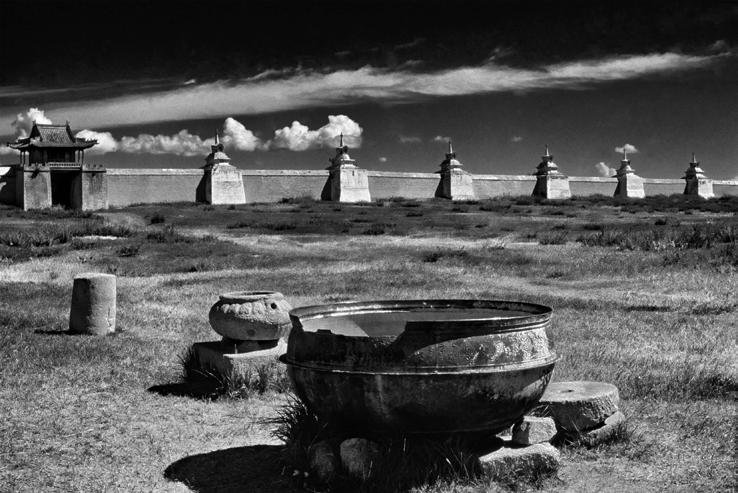
87
Monastero di Gandan a Ulan Bator, Mongolia, 1987
Gandan Monastery in Ulan Bator, Mongolia, 1987
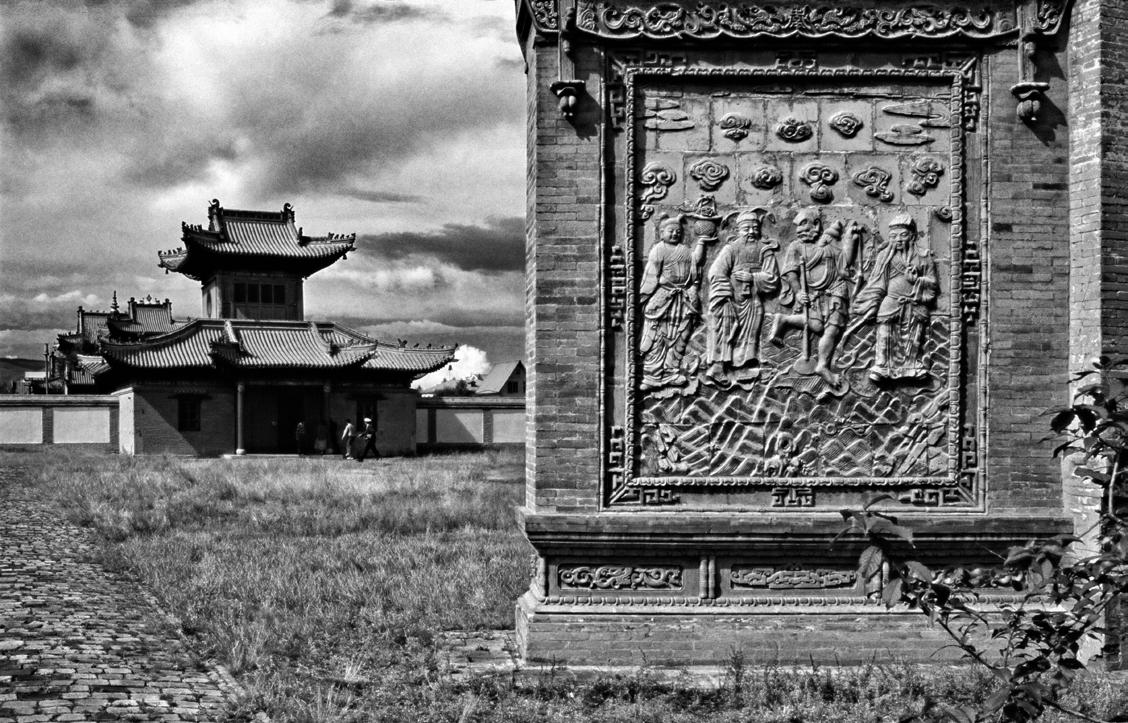
Gandantegchinlen, eretto nel XIX secolo, è una sorta di piccola città sacra. Nei decenni più bui delle repressioni comuniste del ‘900, rimase l’unico monastero buddista attivo in Mongolia; oggi pullula di turisti, ma nelle immagini di Elio Ciol non ne troviamo traccia. Il fotografo ha eluso la folla concentrandosi su differenti frequentatori dei templi, perché da ogni angolo di questa struttura qualcuno o qualcosa ci osserva: rilievi, acroteri, antefisse…
Questi dettagli il fotografo «ha dovuto avvicinarli» con l’obiettivo, ma si è ben guardato dal banalizzarli annullando la loro misteriosa “lontananza” rispetto alla quotidianità; li ha silenziosamente scrutati, «ma non per questo li ha separati da Dio» (G. Agamben).
Built in the 19th century, Gandantegchinlen could be described as a sacred city in miniature. During the dark decades of Communist repression in the 20th century, it was the only Buddhist monastery that managed to stay open in Mongolia. Today, it teems with tourists, but in Elio Ciol’s images there is no trace of them. He manages to get away from the ‘madding crowd’ and concentrate on different visitors to the temples, because someone or something is looking at us from every corner of this complex – reliefs, acroterions, antefixes … The photographer could only ‘get up close’ to these architectural details using his lens, but he was very careful not to render them banal by cancelling out their sense of being ‘above’ the cares of daily life; he observed them silently, “but did not separate them from God by doing so” (G. Agamben).
88

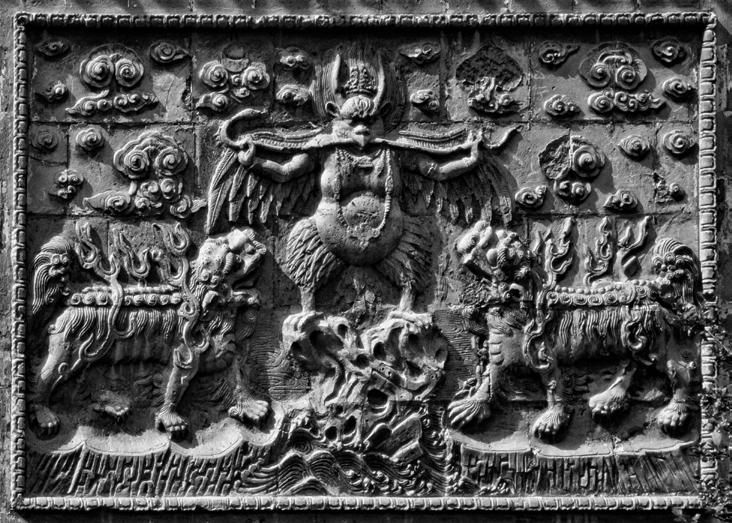
90
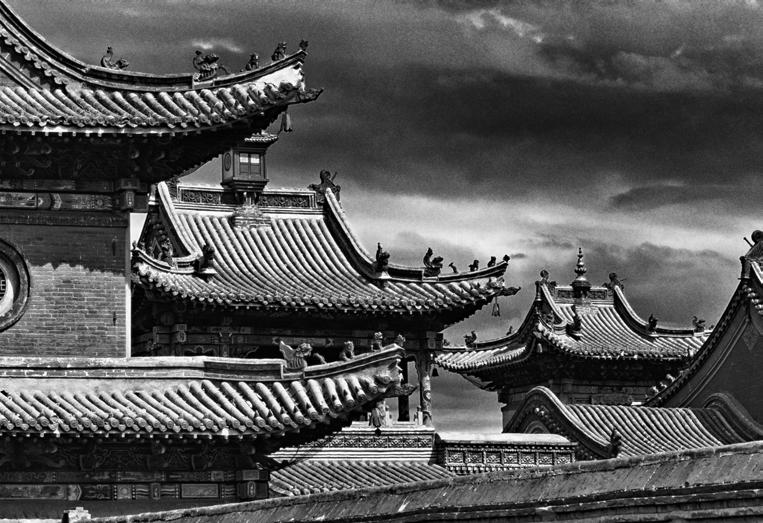
91
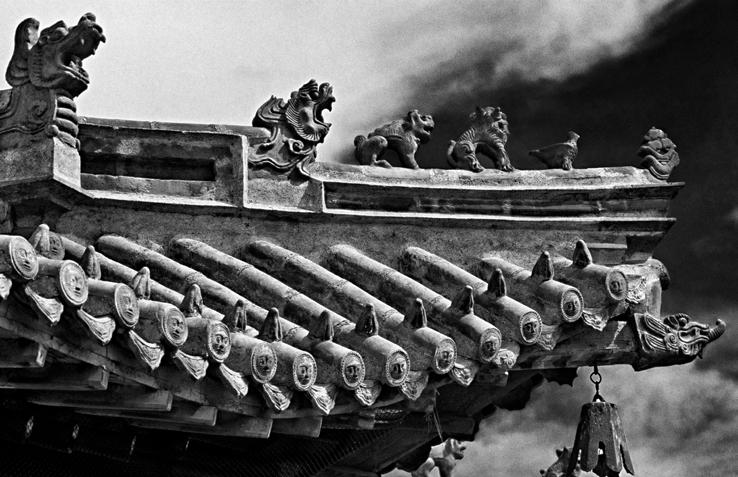
92
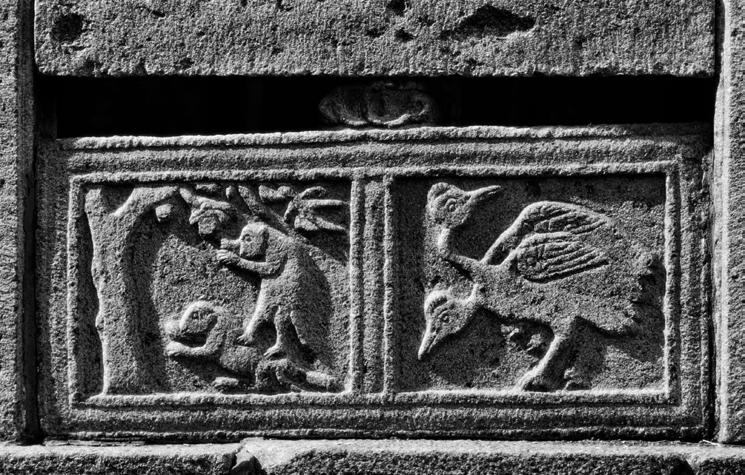
93
Cina, 1998
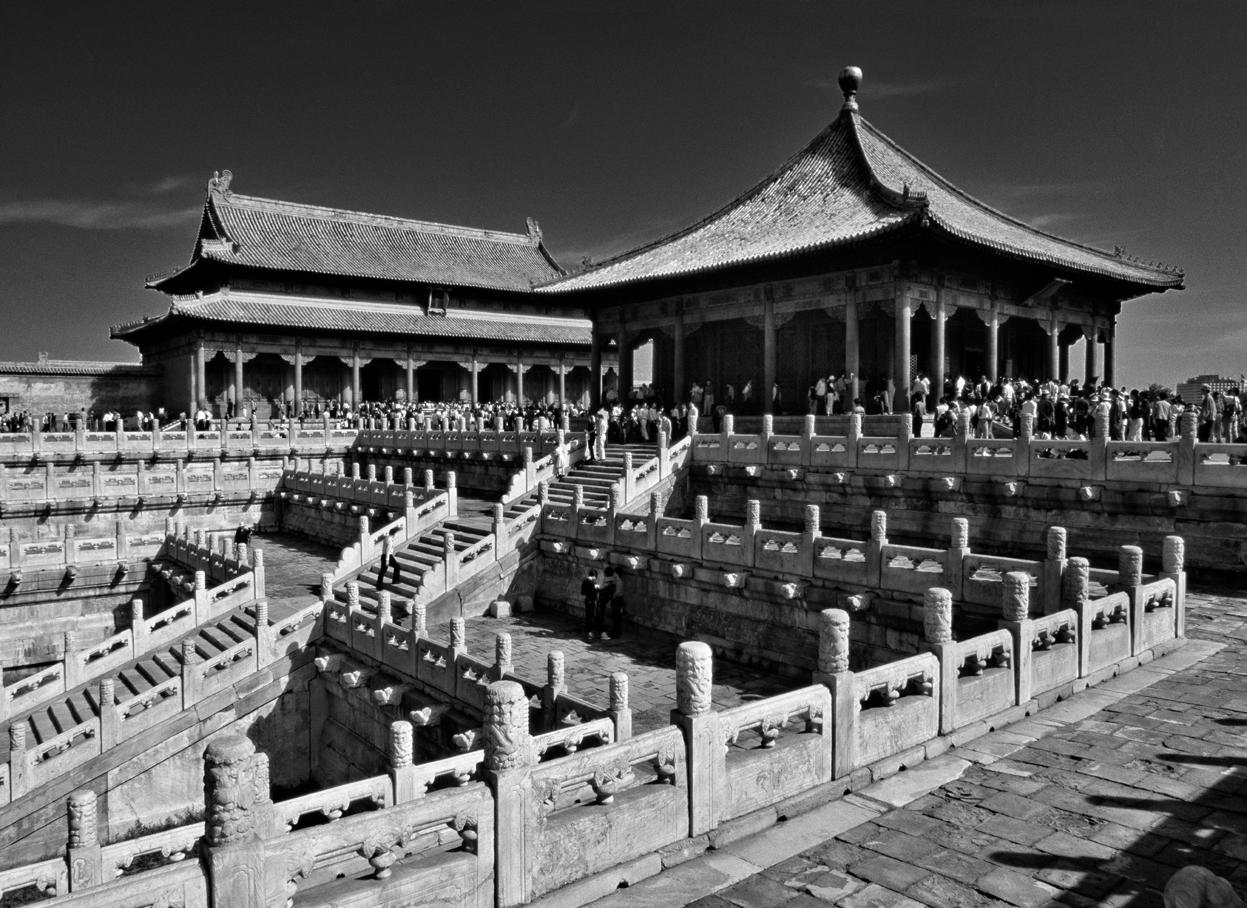
China, 1998
La Grande Muraglia si srotola fra le creste montuose con la serpeggiante, flessuosa eleganza della Running fence di Christo; filtrata dal bianco e nero decanta la sua forza oscura, monumentale madre di tutti i muri di confine con le sue migliaia di chilometri, costruiti a partire dal 215 a.C.. A custodire cosa? I grandi padiglioni della Città proibita imperiale a Pechino, pronti a curvare la luce e a farla scivolare giù per l’impuntura delle scalinate, o i rilievi scolpiti nella roccia della Collina Fubo a Guilin. Tutte immagini parziali, per quanto suggestive, dell’immensa vastità e molteplicità della Cina.
I soldati dell’Esercito di terracotta a Xian – smisurata moltitudine, anche cronologicamente sorella della Muraglia – sembrano contemplarla, fuori campo, dalla penombra dei solchi da cui germogliano, immagine perenne di un mistero collettivo.
The Great Wall snakes along the mountaintops with the same meandering, sinuous elegance of Christo’s Running Fence; the black and white photograph distils the dark power of the monumental mother of all walls erected for the purpose of marking out a border. Work on the thousands of miles of wall began in 215 BC, but what was it built to protect? The grand pavilions of the Forbidden City in Peking, ready to curve the light and make it slide down the ‘embossing’ on the staircases, or perhaps the rock sculptures carved into Fubo Hill in Guilin. All these images, mere fragments though they are, come together to convey something of the vastness and variety of China.
The soldiers of the Terracotta Army in Xian, that countless multitude created around the same time as the Wall, seem to contemplate the complexity of their motherland from the half-shadow of the furrows they seemingly sprout from, perennial symbols of a collective mystery.
94



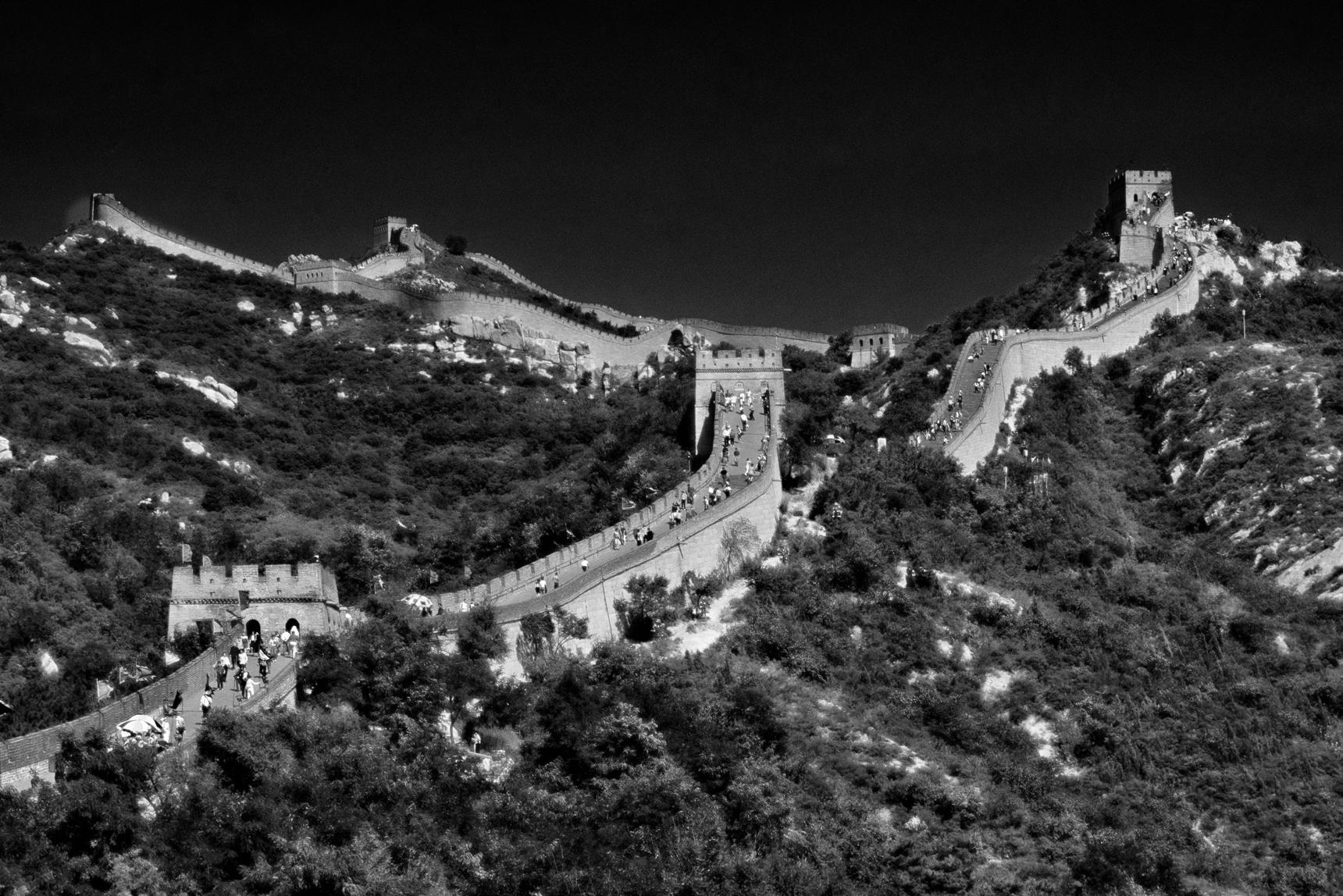

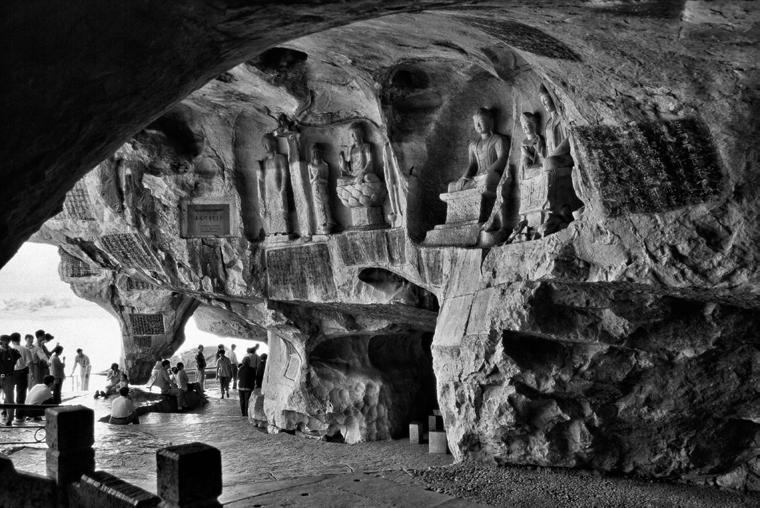
100
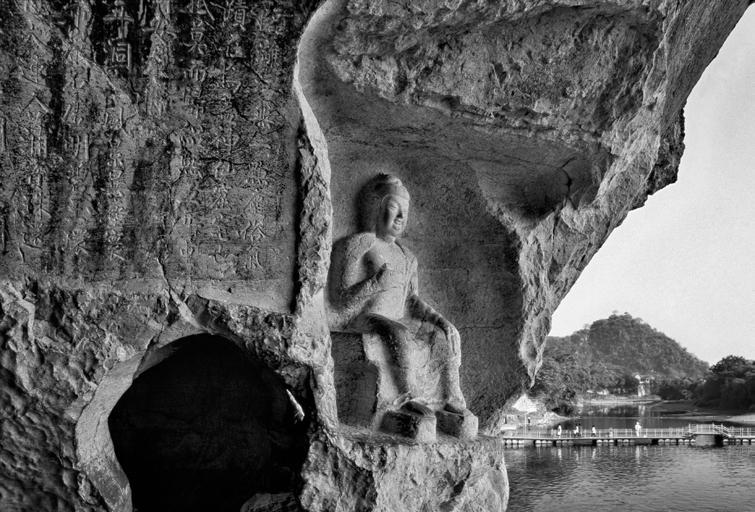
101
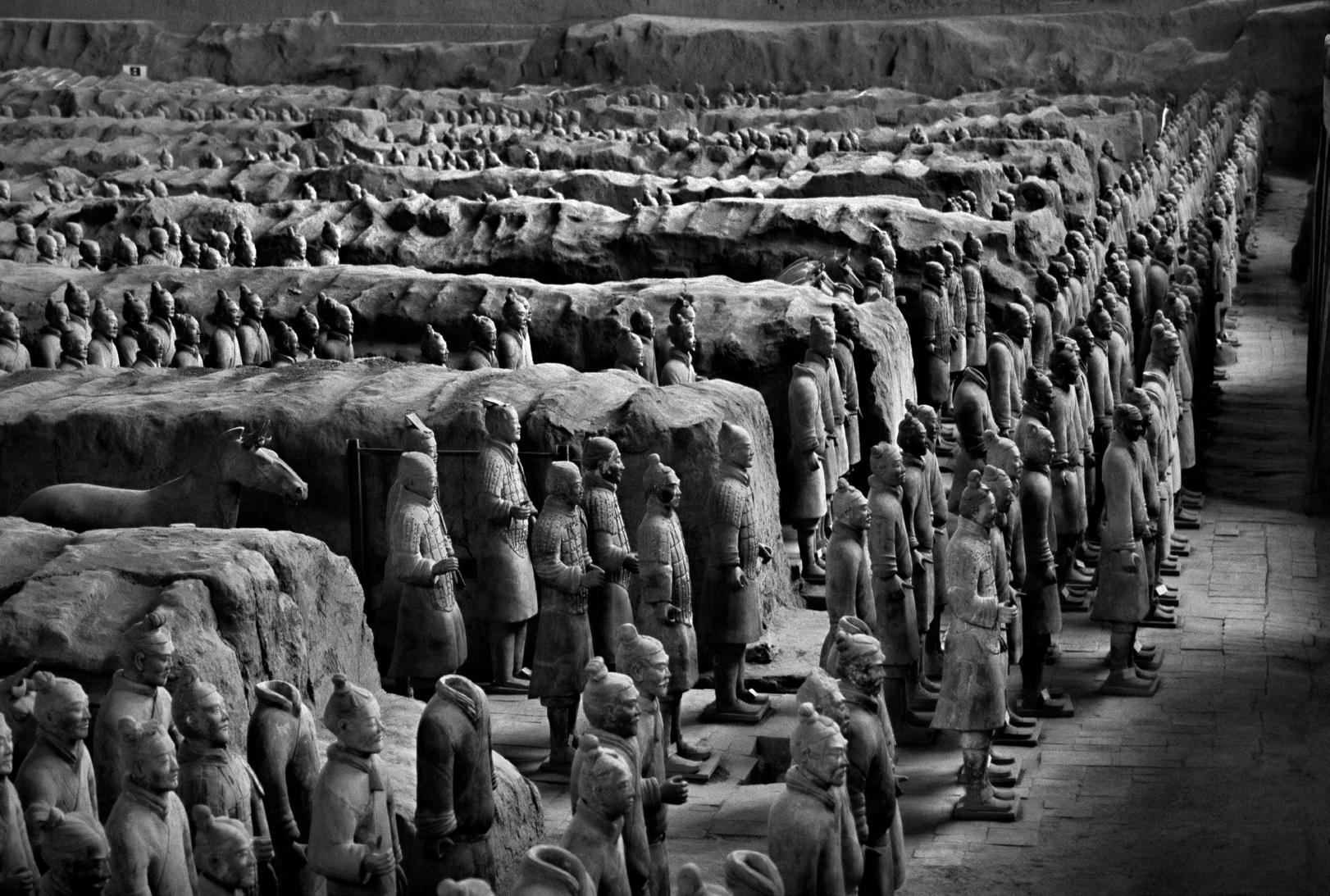

Le mura di Khiva, Uzbekistan, 2009
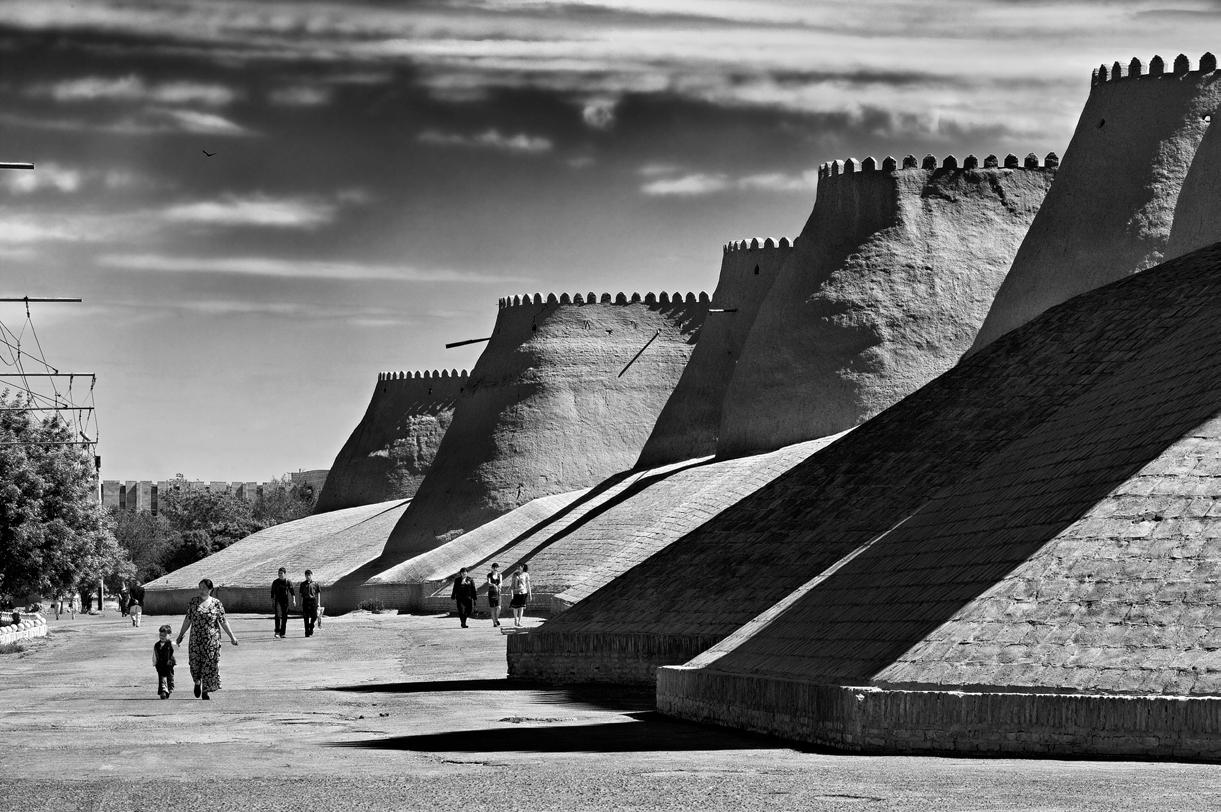
The walls of Khiva, Uzbekistan, 2009
I grandi bastioni sono davvero le poderose mura della città vecchia (Itchan Kala) di Khiva, erette nel XVII secolo. Ma come credere che questa fotografia sia un documento di viaggio, il frutto di una semplice sosta, del volgersi all’indietro dello sguardo mentre i compagni di spedizione procedono nel loro cammino?
Le figure paiono collocate sulla scena con la cura che Giorgio Morandi avrebbe dedicato alle bottiglie nelle sue Nature morte. Le ombre colano lungo le scarpate in primo piano nette e profonde come bitume. E le nuvole stanno per dissolversi in un’altra dimensione; forse la stessa da cui arriva l’uccello ad ali spiegate che, in alto a sinistra, se ne sta immobile – minuscolo eppure definitivo – come la firma di Van Eyck sul muro di fondo, dietro ai personaggi di un suo ritratto.
I merli delle torri, poi, addentano la luce con la stessa altera fragilità delle cappe di un velo bianco.
Dove l’ho visto? Avvolgeva il viso di Maria in una meravigliosa Deposizione dalla croce... Forse Rogier Van der Weyden.
These grand bastions are the mighty walls of the old city (Itchan Kala) of Khiva, built in the 17th century.
But how can we believe that this photograph is a souvenir from a journey, the fruit of simply stopping for a moment and looking back while one’s companions continue onwards?
The figures seem arranged with the same care with which Giorgio Morandi placed the bottles in his Still Lifes. The shadows fall on the slopes in the foreground, as dark and treacherous as tar, while the clouds above look like they’re about to fade away into another dimension –perhaps the same one the bird, frozen with its wings open in the top left, has come from. The bird is tiny, but defines the image, like the signature of Van Eyck on the back wall of a scene, behind the subjects of the portrait. The crenelations of the towers nibble the light with the same haughty fragility as the folds of a white headdress. Where have I seen that headdress? Around Mary’s face in a wonderful Descent from the Cross … Perhaps by Rogier van der Weyden.
104

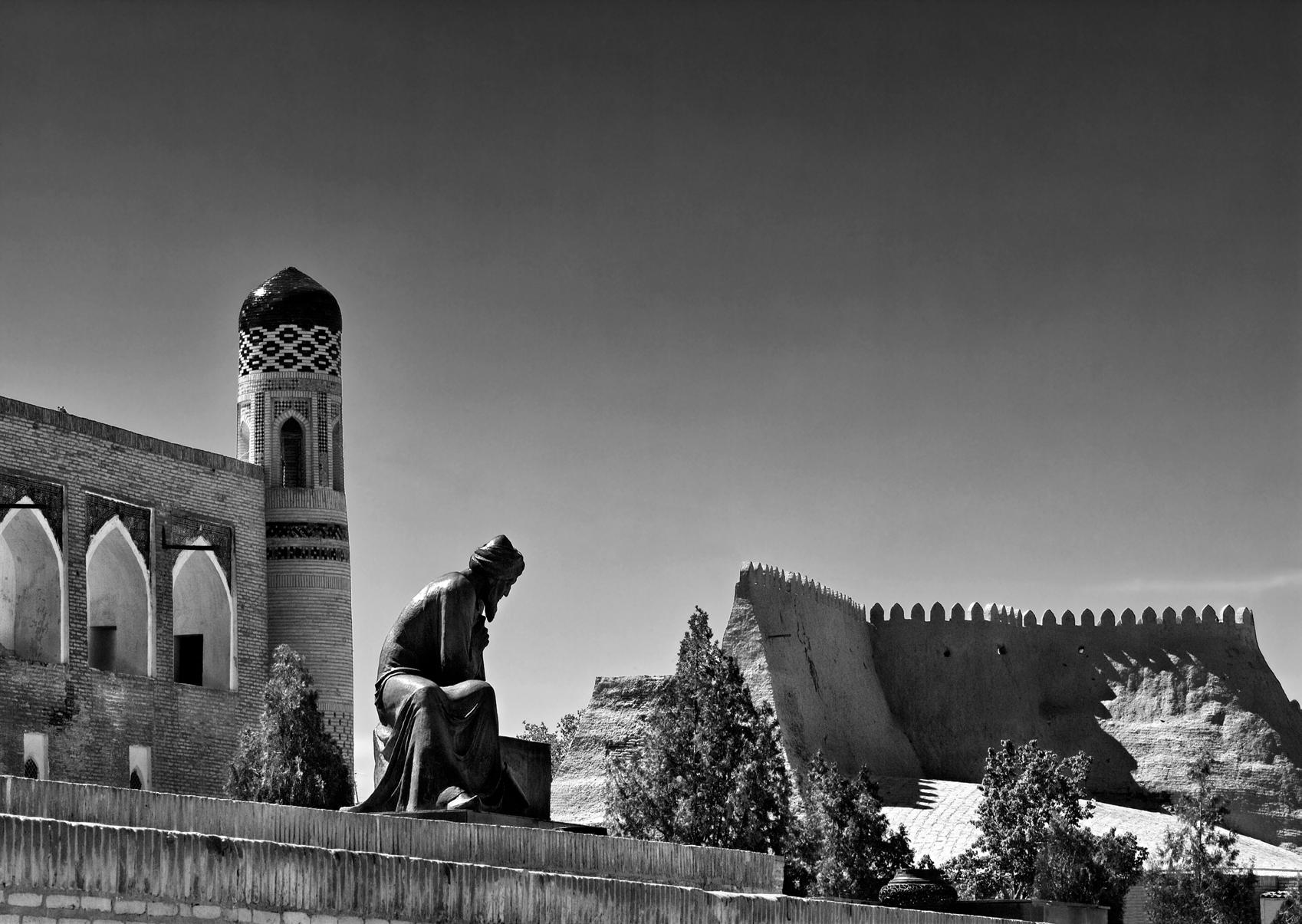

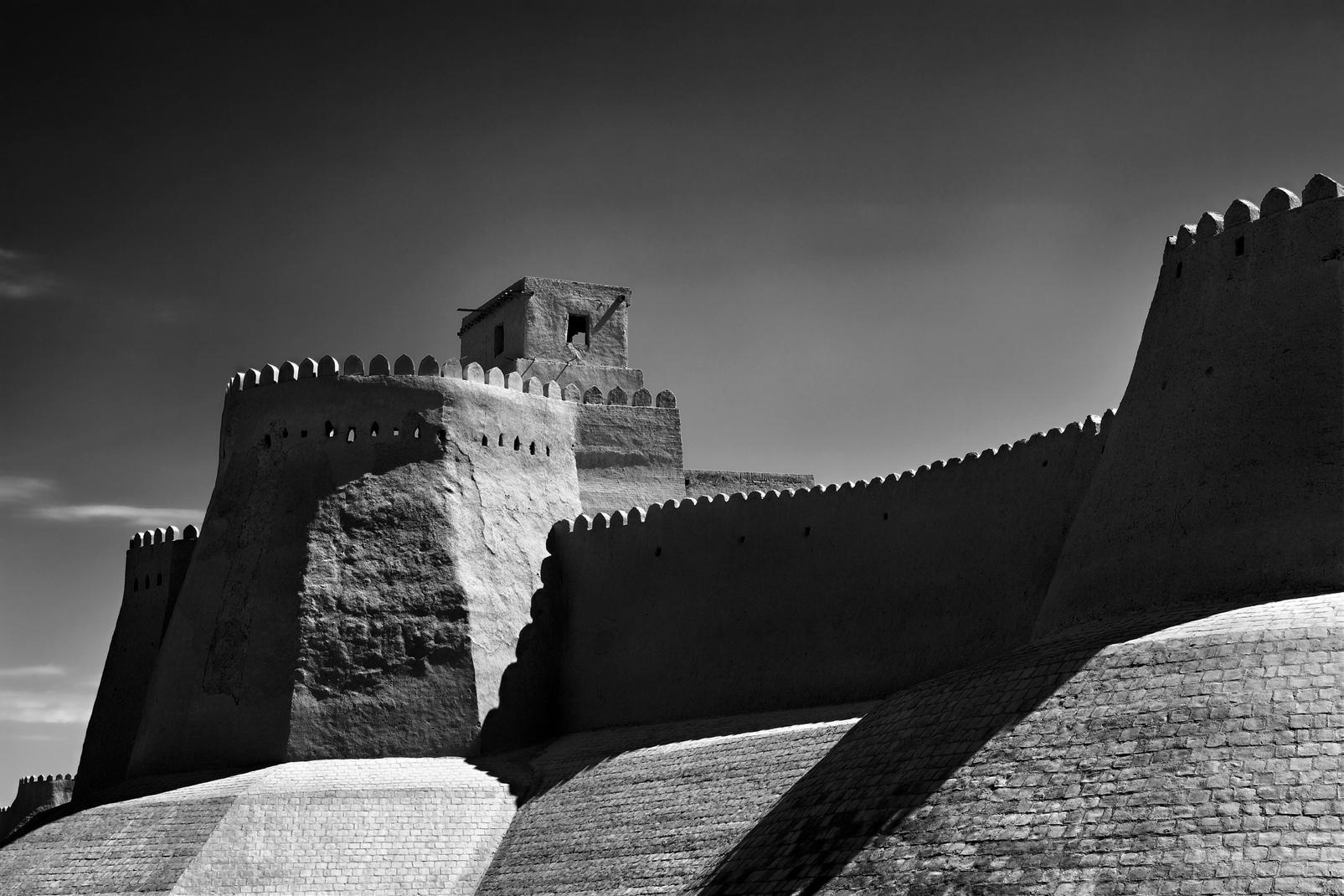

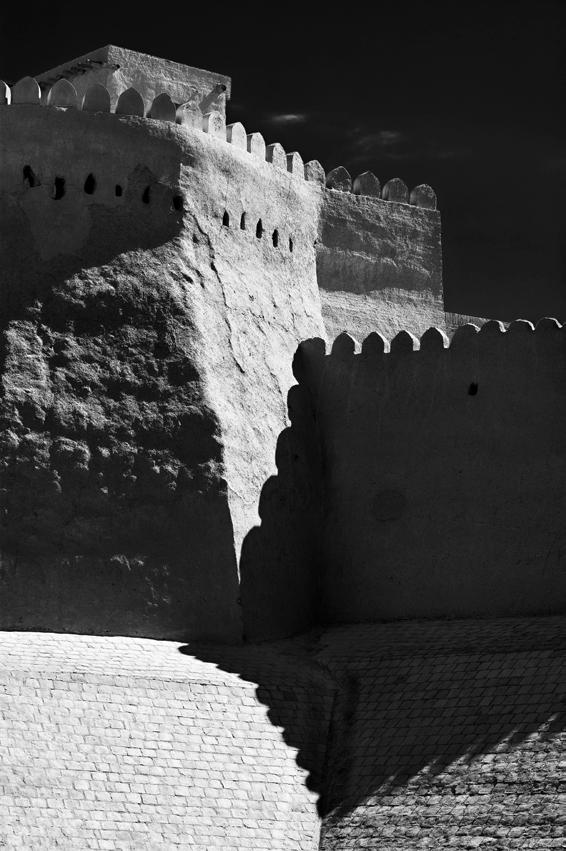
110

111
Tosh-Hovli
, Khiva (Uzbekistan), 2009
Tosh-Hovli, Khiva (Uzbekistan), 2009
Lo chiamano “Palazzo di pietra”, anche se si mostra a tutti con un volto di esaltata policromia, e nonostante la sua più celebre colonna sia di legno. Inquadrata dal basso, solcata da fenditure ma prospetticamente affidabile, più che sostenere la struttura sembra volerla animare, mantenendola precariamente sospesa.
Costruito nel secondo quarto dell’Ottocento per volontà di un committente dal pessimo carattere (di Alla Kuli Khan si racconta abbia efferatamente ucciso l’architetto del Tosh-hovli perché non stava rispettando i tempi previsti di realizzazione dell’edificio), il palazzo ha una quantità di stanze difficile da contare quasi quanto le svolte dei decori delle sue maioliche bianche e blu.
Dal cortile di ricevimento all’harem, un incessante ronzio decorativo rimbalza da una superficie all’altra, e quasi annulla i volumi.
They call it the “Stone Palace”, even though it’s adorned with a myriad of colours and patterns and its most famous column is carved from wood. Viewed from below, with seared with clefts but still providing a reliable perspective, it seems less of a structural support than a device to lift up the building and keep it hovering precariously. Built towards the end of the first half of the nineteenth century upon the orders of a patron with a nasty character (it is said of Alla Kuli Khan that he brutally murdered the architect of Tosh-Hovli when the building work fell behind schedule), there are so many rooms in the palace, they are almost as difficult to count as the swirls on its blue-and-white tiles. From the reception courtyard to the harem, the incessant buzz of swirling patterns bounces from one surface to another and almost blocks out our perception of the forms and spaces.
112
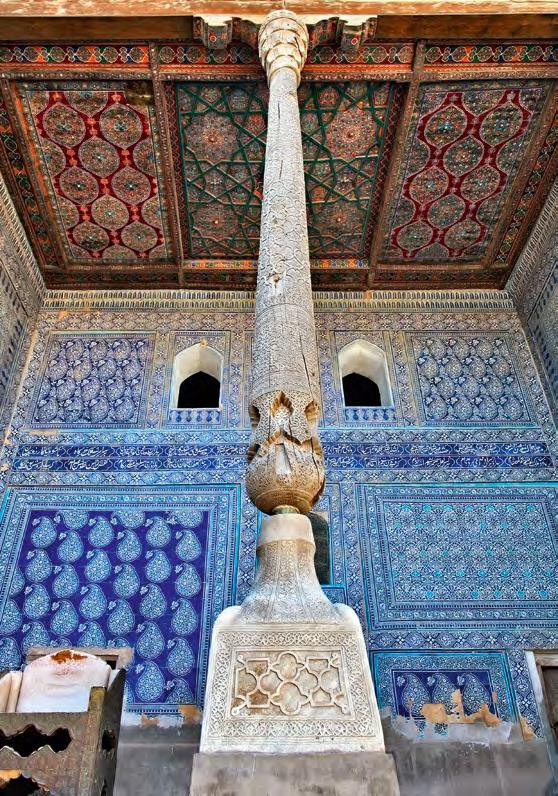
113
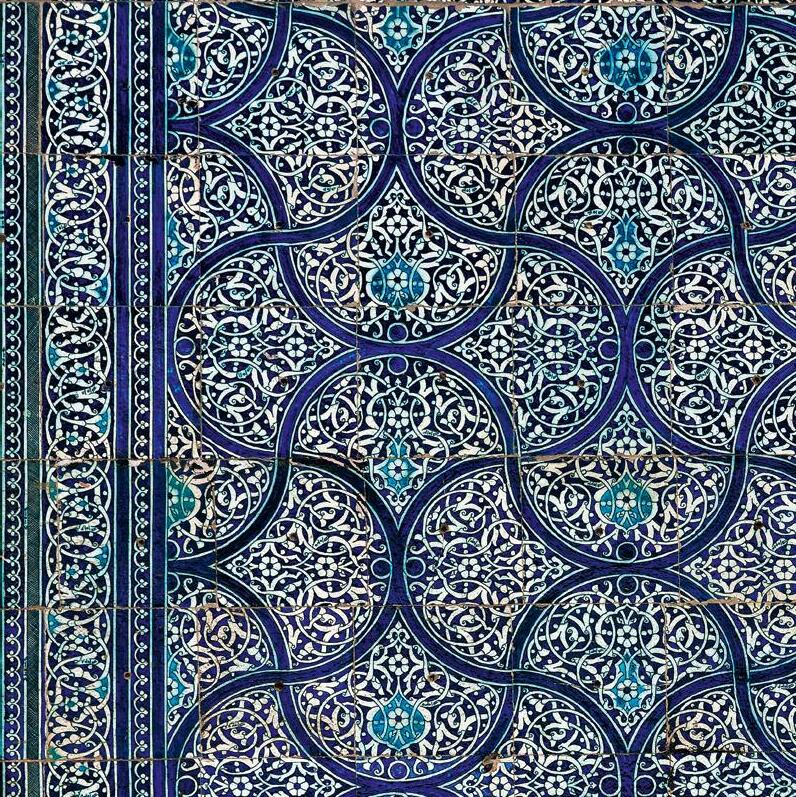
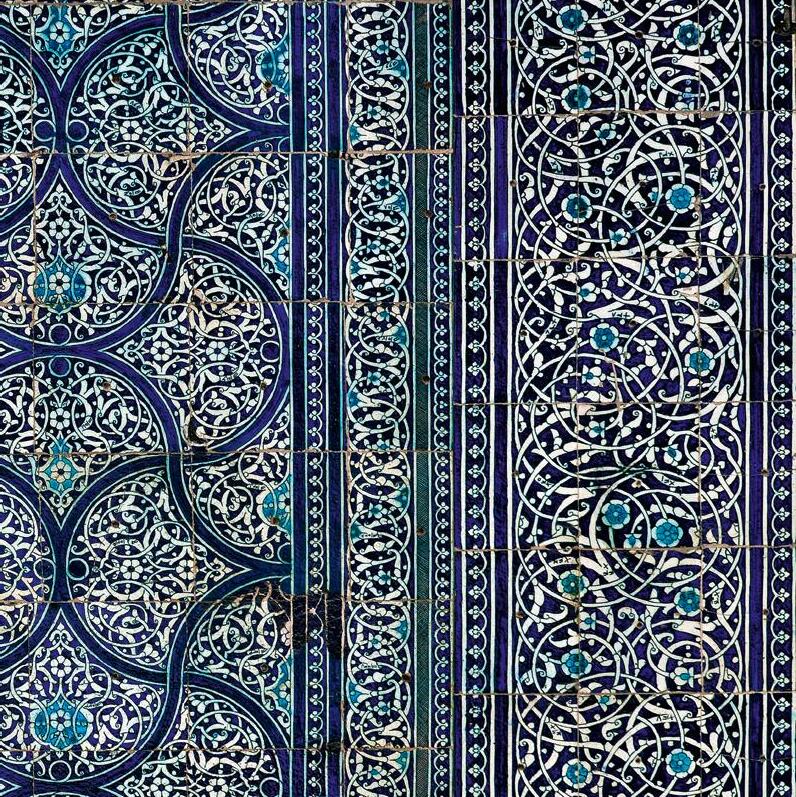
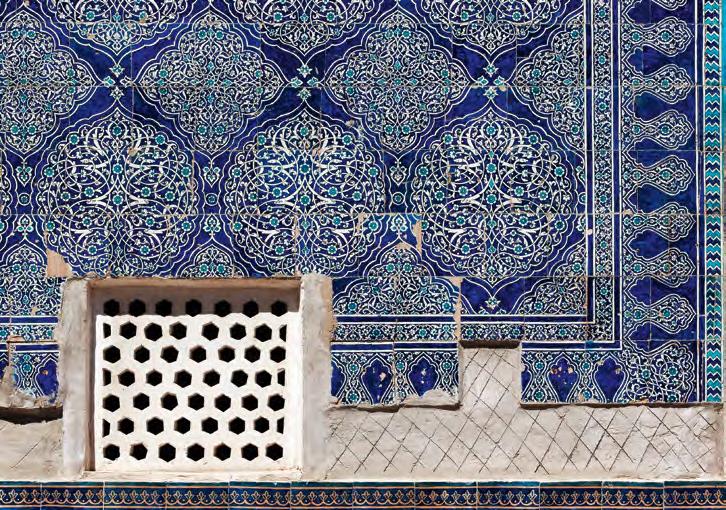
116
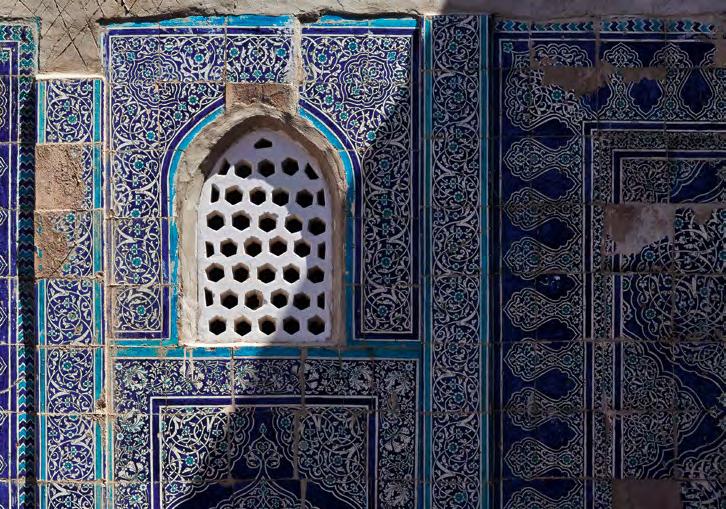
117
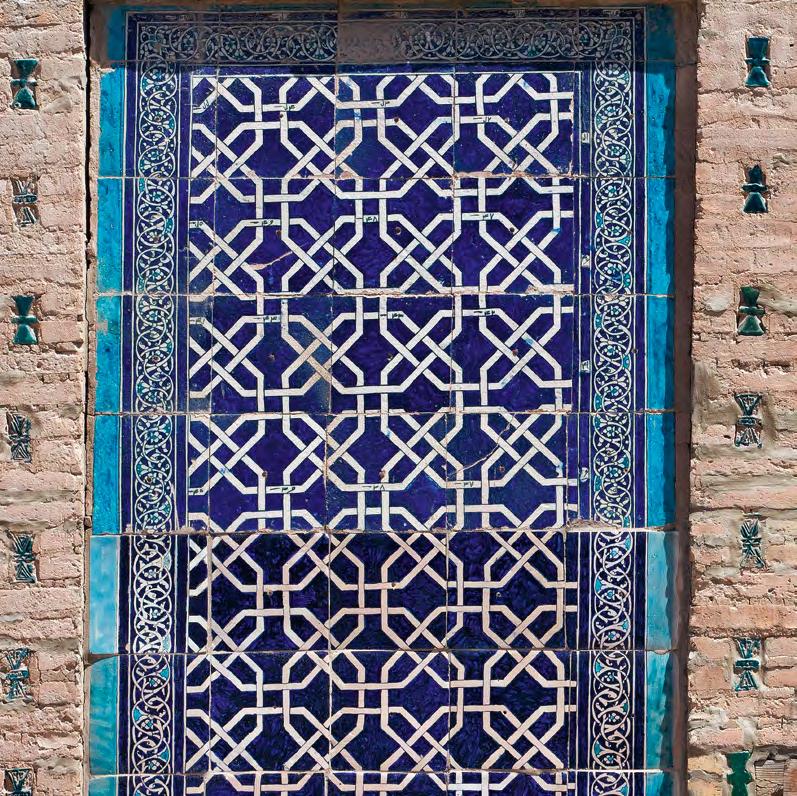
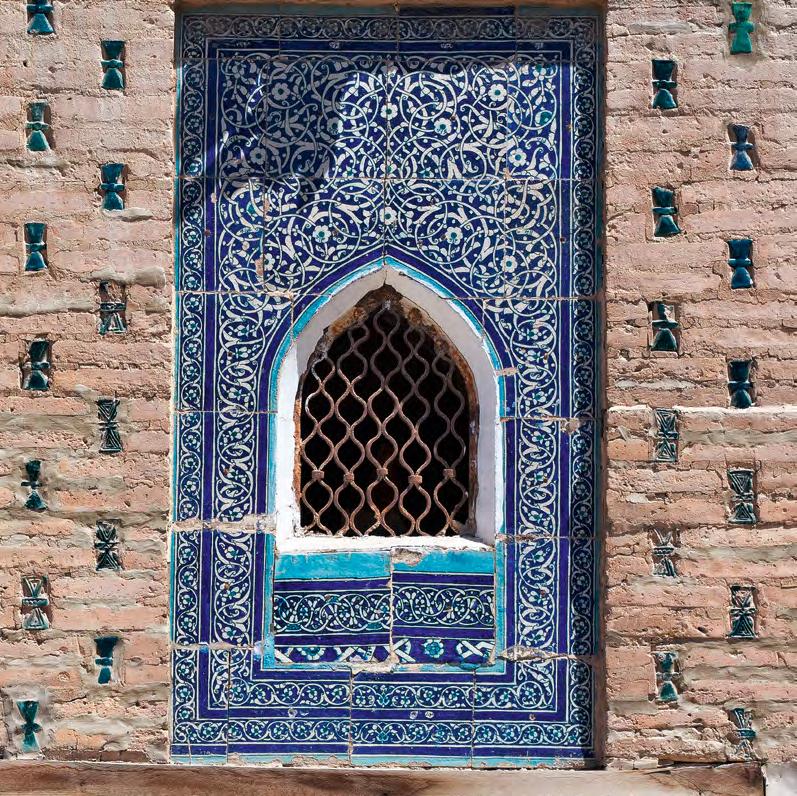
Casa dell’Ambasciatore, Tashkent (Uzbekistan), 2009
Polovtsev House, Tashkent (Uzbekistan), 2009
Il palazzo, definito Casa dell’ambasciatore, venne eretto alla fine dell’Ottocento in un tripudio di decori in stucco e legno intagliato. Che l’edificio ospiti oggi il Museo Nazionale di Arti applicate pare quasi una conseguenza necessaria: la sua struttura è decorazione in forma di architettura.
Nelle fotografie di Ciol, il reticolo dei motivi ornamentali si fa caleidoscopio tridimensionale negli elementi a cassettone, che ribaltano la normale gerarchia delle parti: il soffitto diventa più importante dell’ambiente a cui fa da coperchio incantato, e non occorre neppure socchiudere gli occhi perché lo sguardo, scivolando giù per le pareti, si smarrisca e fantastichi fra i racemi che galleggiano sull’intonaco come le cornici di interminabili, sgargianti cloisons.
This palace, known as Polovtsev House, is a triumph of stucco and carved-wood decorations built in the late 19th century. It seems almost inevitable that it was later chosen as the home of the State Museum of Applied Arts – the building is basically decorations added together to achieve a building. In Ciol’s photographs, the web of decorative motifs becomes a three-dimensional kaleidoscope through the lacunar elements that overturn the usual hierarchy of architectural components: the ceiling becomes more important than the room it acts as an enchanting lid to, and there’s no need to even half-close your eyes for your gaze to get lost as it scans downwards and you start fantasizing among the clusters of flowers floating on the plaster like the edges of a gaudy, never-ending cloisonné.
120
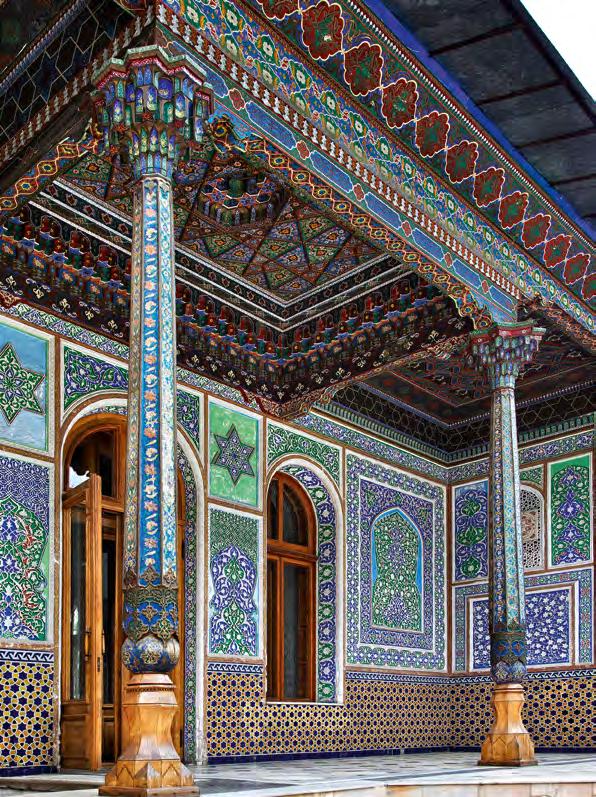
121
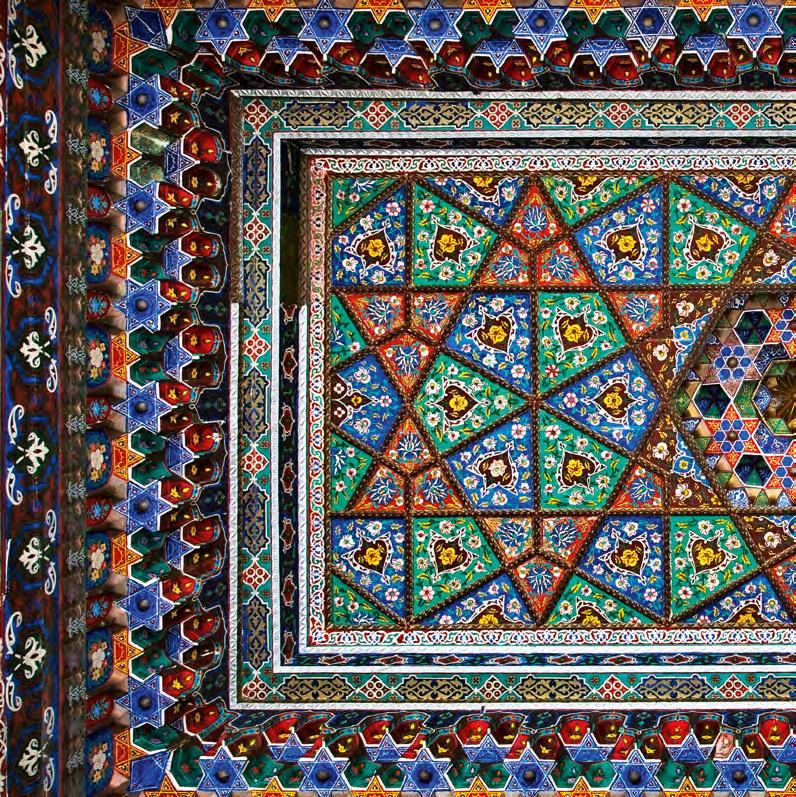
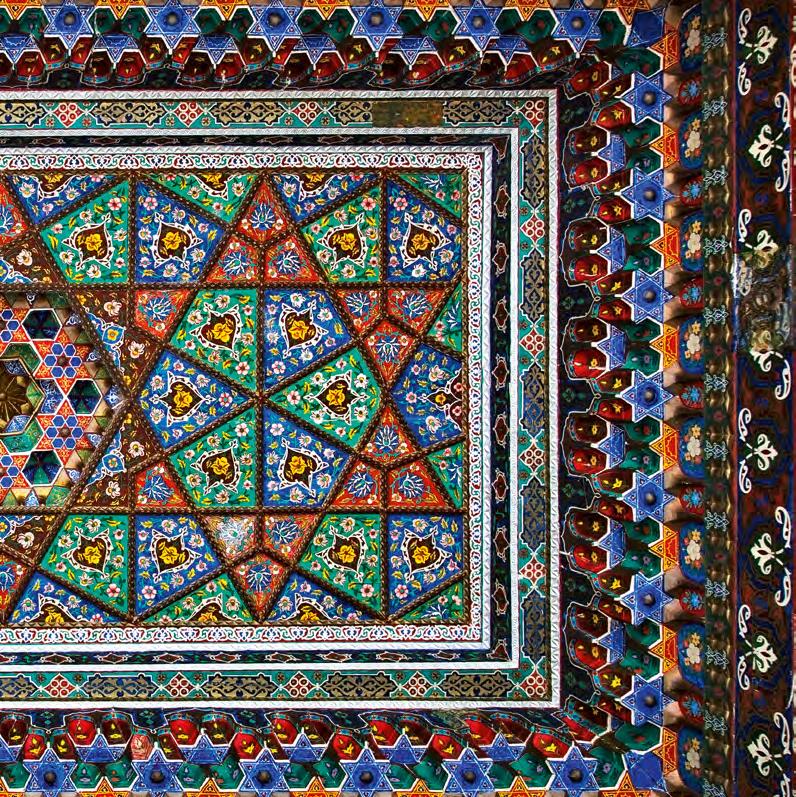
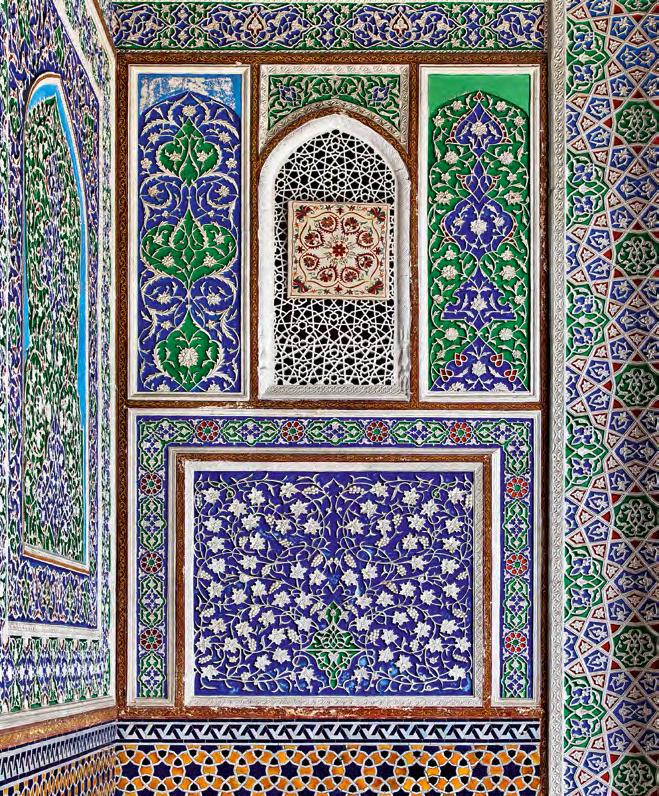
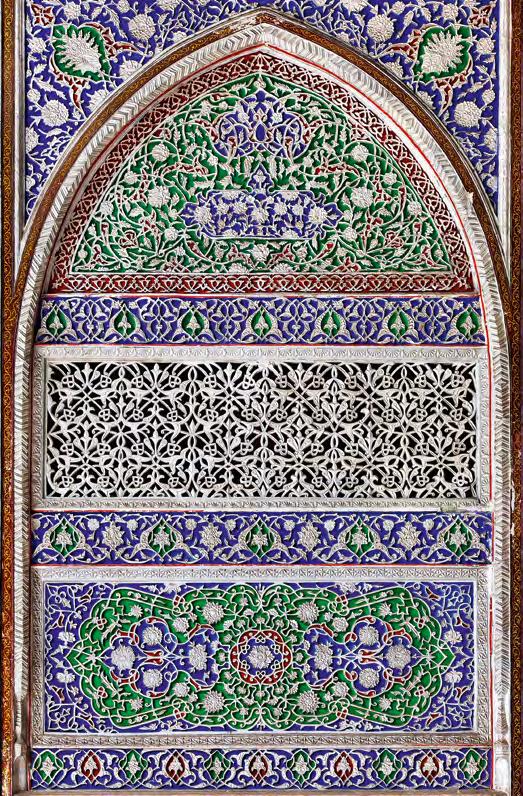
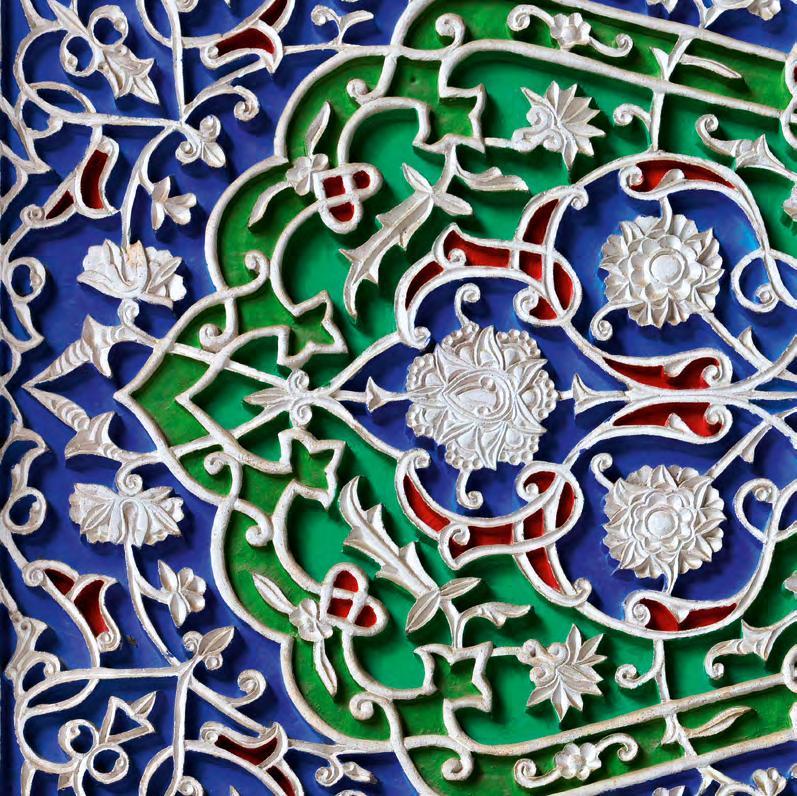
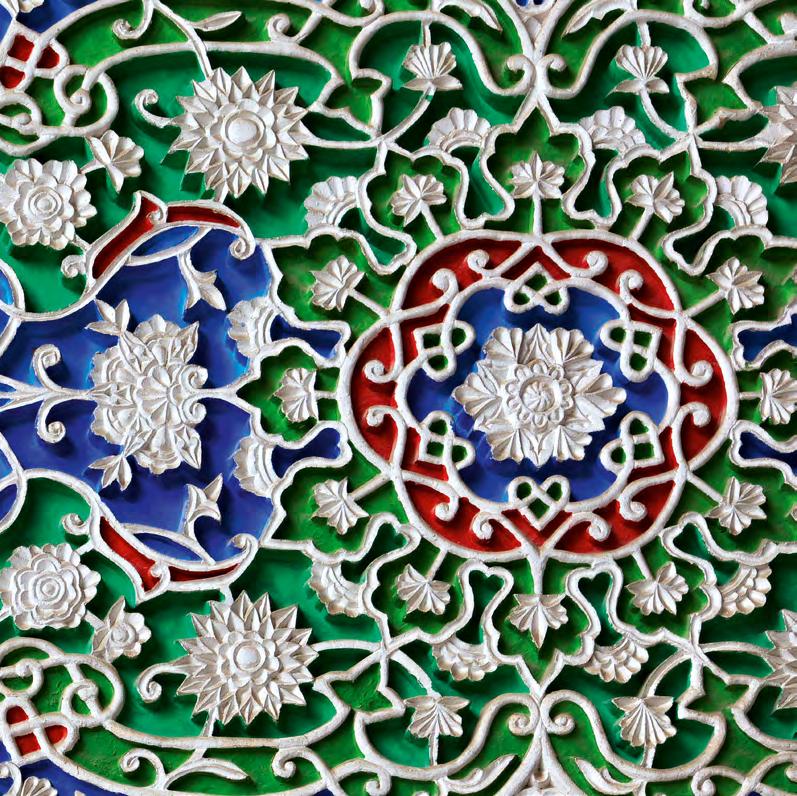
Madrasa di Mir-i-Arab, Bukhara (Uzbekistan), 2009
Mir-i-Arab Madrasa, Bukhara (Uzbekistan), 2009
Nel mondo arabo la madrasa era una istituzione educativa nella quale venivano insegnati i principi dell’Islam. Quella di Bukhara venne eretta nel XVI secolo e la sua facciata – affiancata dalle calotte turchesi delle due torri – rispecchia quella della prospiciente moschea con la compostezza di una partita a scacchi. Lo spazio intorno all’edificio pare obbedire alle regole lineari di un contesto occidentale, ma basta che noi – con il fotografo – solleviamo lo sguardo alle superfici in cui entrano in gioco le ceramiche policrome perché le trame geometriche del selciato e dei mattoni vadano a sfumare, all’orizzonte, in un fiorito brulichio di colori e scrittura: l’affascinante soglia di una differente forma mentis
In the Arab world, the madrasa was an educational institution where the principles of Islam were taught. The Madrasa in Bukhara was built in the 16th century and its façade – flanked by the turquoise domes of the two towers – reflects the façade of the Mosque opposite with all the composure of a game of chess between masters. The space around the building seems to obey the geometrical rules of Western architecture, but all we – and the photographer – have to do is lift our eyes to the surfaces covered with colourful tiles for the geometrical rigour of the paving and the lower brickwork to be replaced by a florid, teeming mass of patterns and writing. We’ve reached the threshold to a different forma mentis
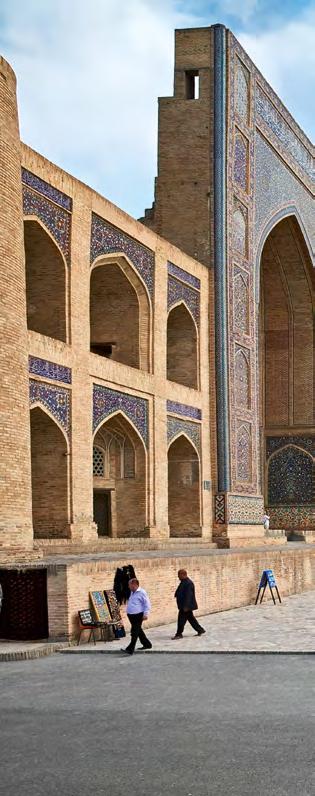
128
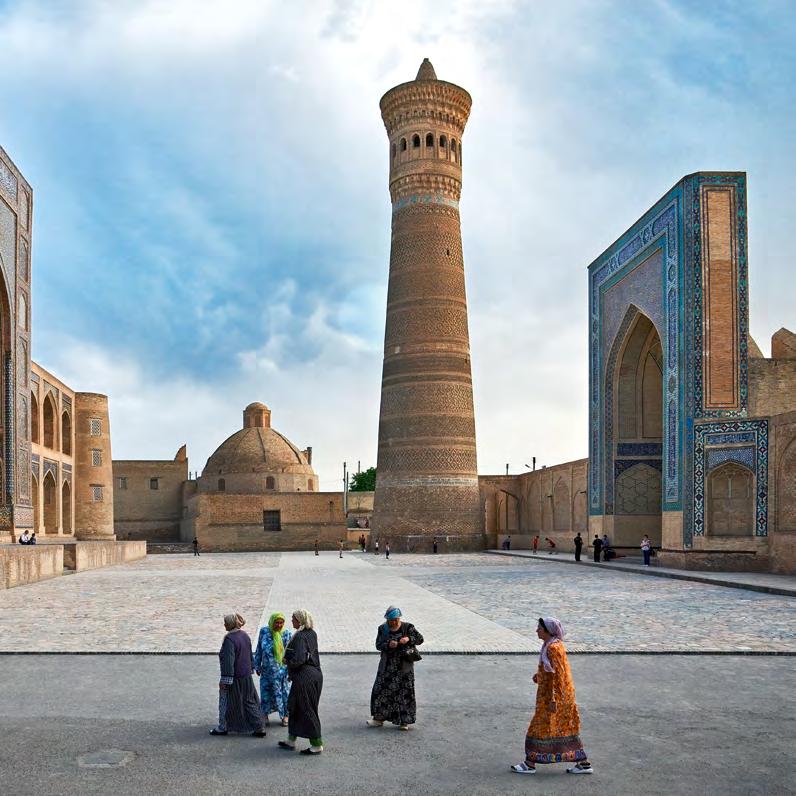
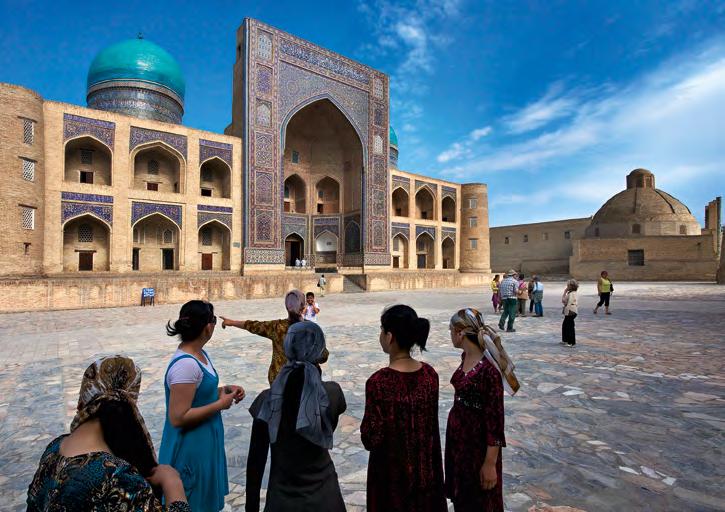
130
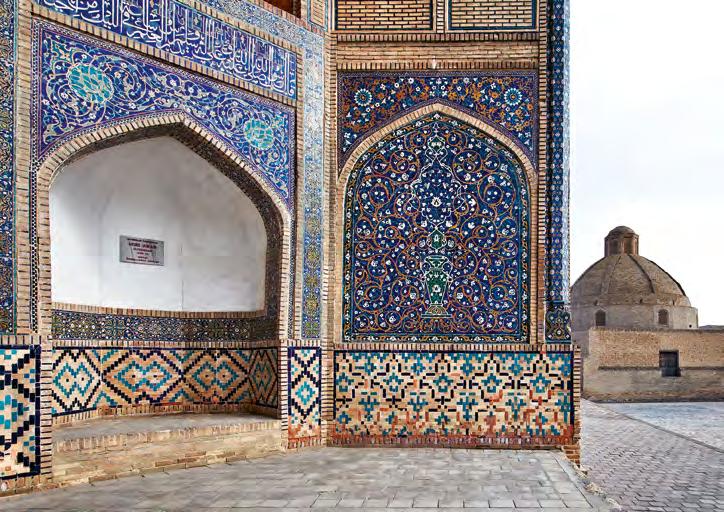
131
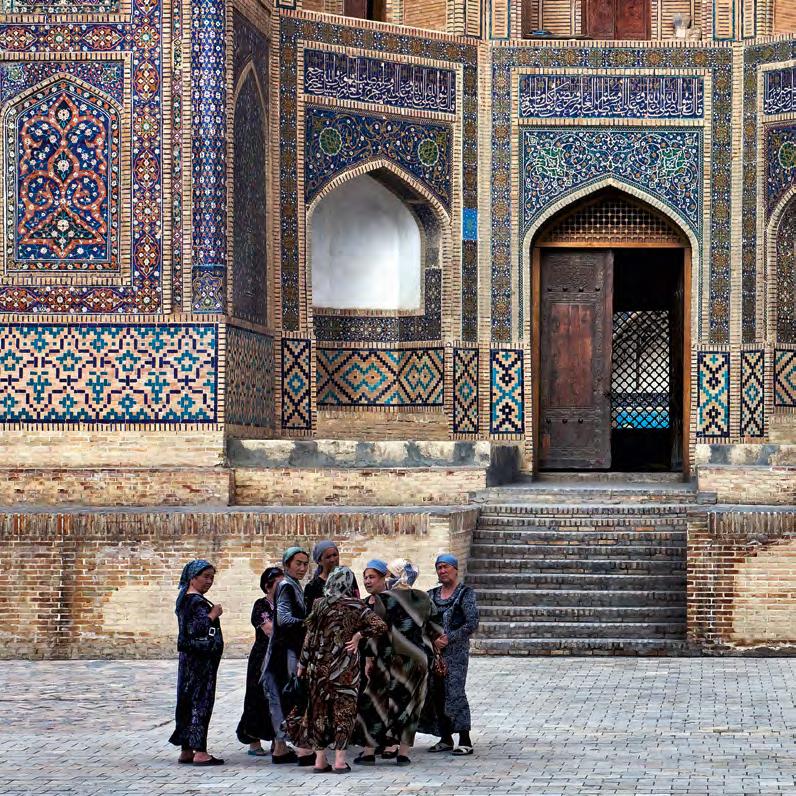
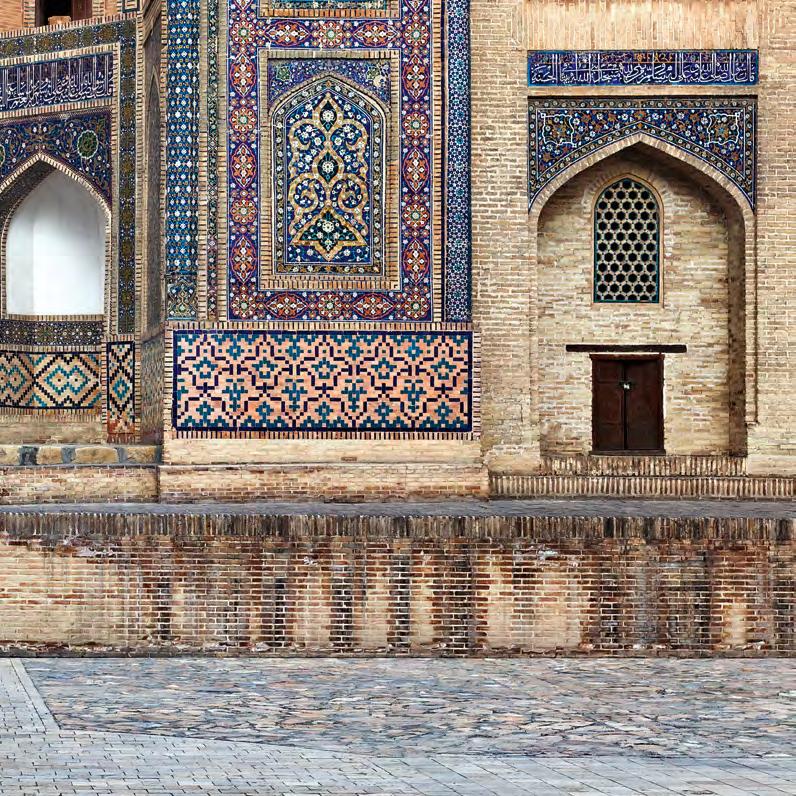
Shah-i-Zinda, Samarcanda (Uzbekistan), 2009
Shah-i-Zinda, Samarqand (Uzbekistan), 2009
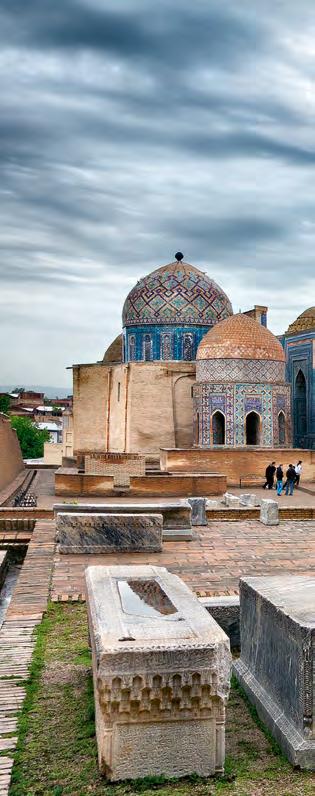
Basta sillabare il nome Samarcanda per sentirsi proiettati nell’idea un po’ fantasiosa che molti di noi coltivano dell’Asia, avventurosamente attraversata da Marco Polo e da mille carovane lungo la Via della seta. E difficile rimane scorporare il dato storico dalle suggestioni di un Oriente magico di fronte al complesso di Shah-i-Zinda.
I mausolei che compongono la necropoli furono in gran parte eretti fra IX e XIV secolo, ma a che epoca datare l’ammaliante stordimento visivo in cui ci fa precipitare il reticolo di grafia, pittura e rilievo che si adagia su ogni superficie indagata dall’obiettivo? Certi elementi verticali, poi, sfuggono alla competenza lessicale di un europeo: corrispondono alle paraste di una nostra architettura, ma invece di imitare pilastri proiettano la struttura in spirali blu e azzurre che alla parete rubano il peso.
All you have to do is pronounce the name ‘Samarqand’ to evoke the rather fanciful idea many of us have of Asia, so intrepidly traversed by Marco Polo and by countless caravans following the Silk Road over the centuries. It’s even more difficult to separate actual fact from the aura of magic surrounding the Orient when looking at the Shah-i-Zinda complex.
The mausoleums making up the necropolis were mostly built between the ninth and fourteenth centuries, but how can you date the bewitching feeling of stupefaction induced by the web of writing, painting and relief sculpture adorning every surface investigated by Ciol’s lens? Certain vertical elements escape definition by Europeans – they correspond to the square pilasters sometimes seen in our architecture, but instead of acting as structural supports, they seem to lift the building in spirals of blue that relieve the walls of their weight.
134
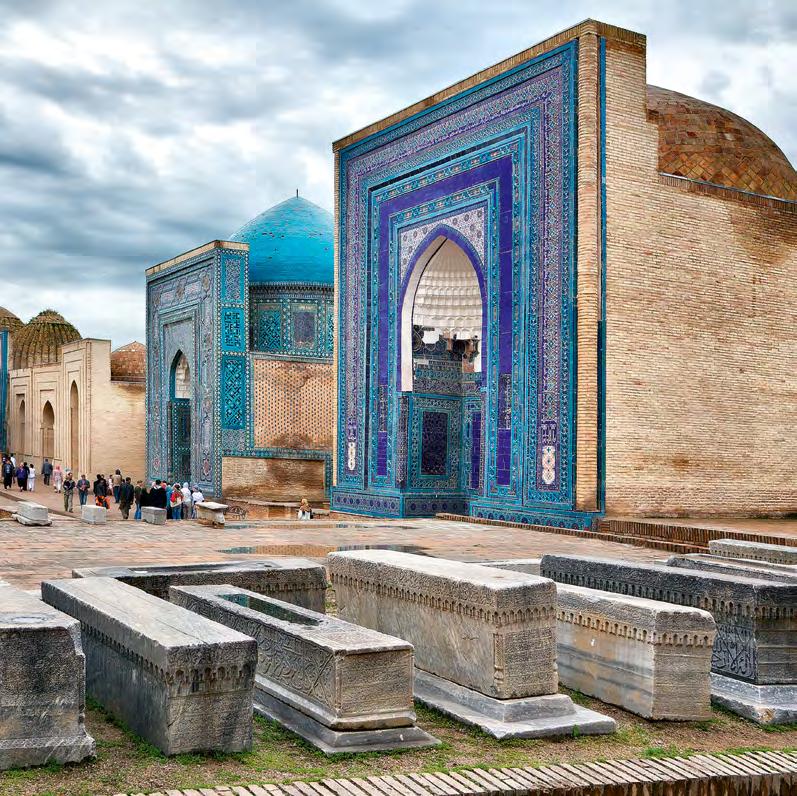
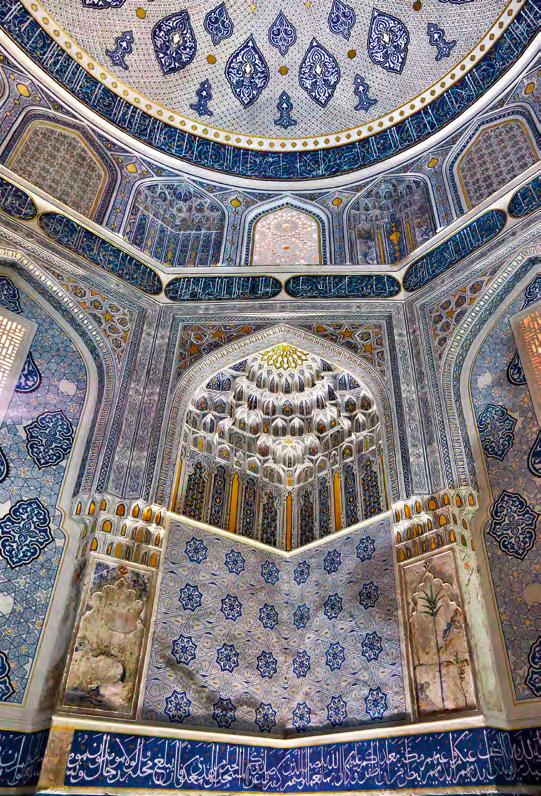
136
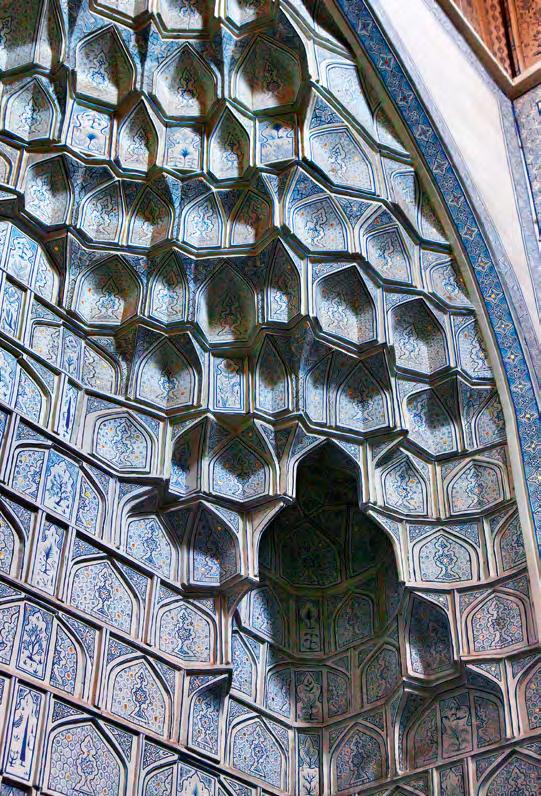
137
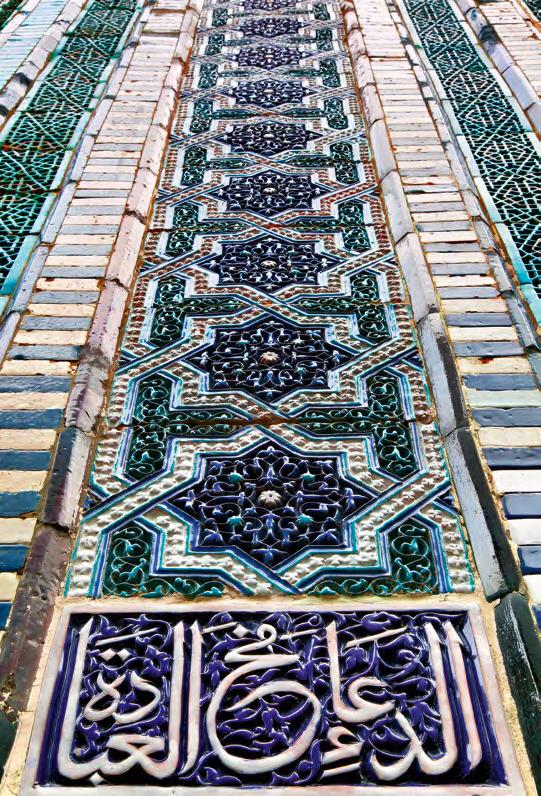
138
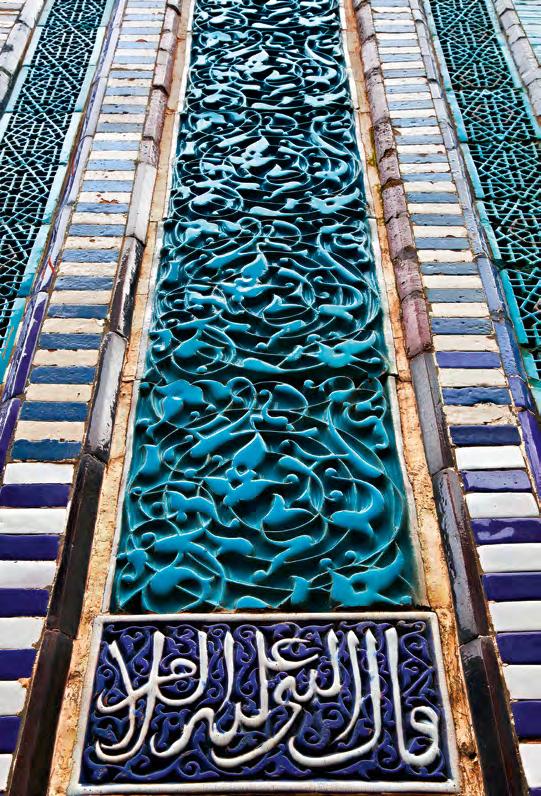
139
Monastero di Zagorsk, Russia, 1985
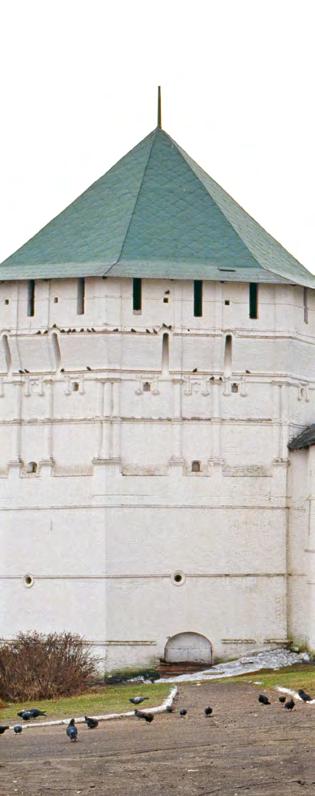
Zagorsk Monastery, Russia, 1985
Tre donne stanno per varcare la soglia del Santuario; mentre la mano di una di loro si alza nel segno della croce, noi già ci proiettiamo con il pensiero all’interno delle mura.
Gli appassionati d’arte e di cinema conoscono il Monastero della Trinità a Zagorsk, non lontano da Mosca, per la bellissima icona quattrocentesca dipinta da Andrej Rublëv, che decorava l’iconostasi di una delle sue chiese. Il fotografo, invece, si concentra sull’apparente contraddizione degli spazi esterni, dove all’eleganza somma dell’arte sacra corrispondono forme e colori più popolari: cupole luccicanti e murature policrome, chiassosi tempietti alla portata di un veloce disegno da strada, ma anche di uno sguardo che estrapoli un ritmo visivo dal frastuono dei decori di glassa.
Three women are about to cross the threshold to the Shrine; while one lifts her hand to make the sign of the cross, our thoughts are already inside the walls.
Lovers of art and cinema already know the Trinity Lavra of St Sergius in Zagorsk, not far from Moscow, thanks to the stunning fifteenth-century icon painted by Andrej Rublëv hung in the iconostasis of one the chapels. Our photographer, on the other hand, prefers to concentrate on the apparent contradiction of the exterior spaces, where the consummate beauty of the sacred artworks is complemented by more earthly forms and colours: shining domes, colourful walls and gaudy temples could be the product of a swiftly-producing street drawing, but also within the reach of a gaze intent on finding the visual rhythm behind the tumult of cake decorations.
140
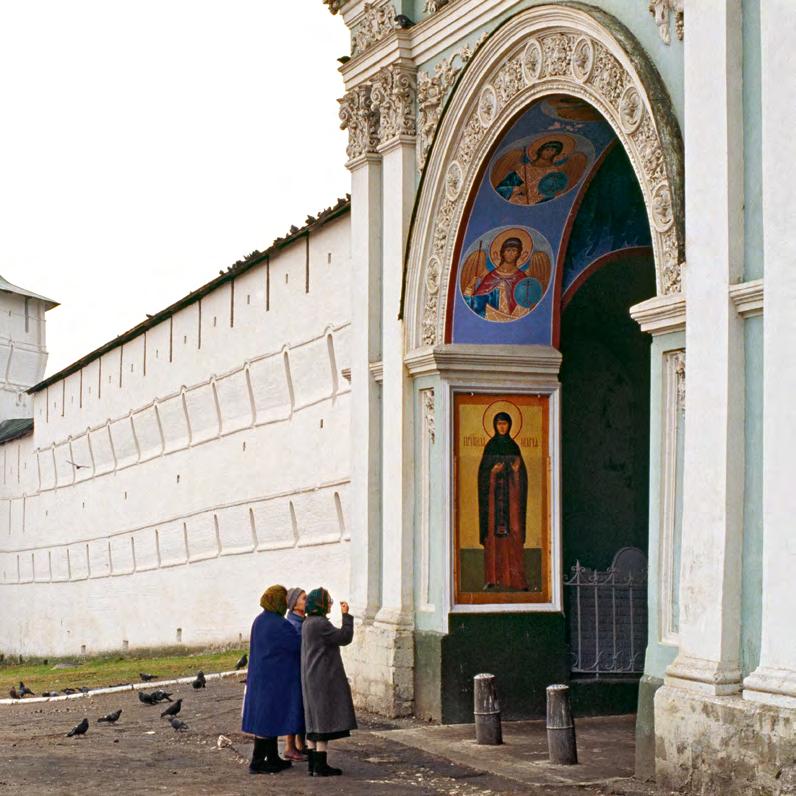
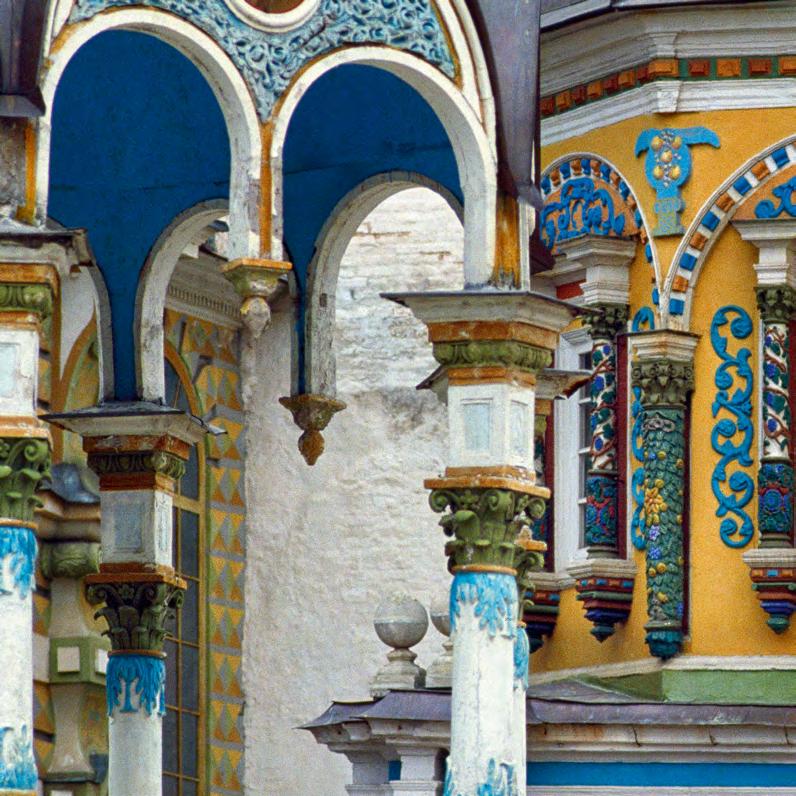
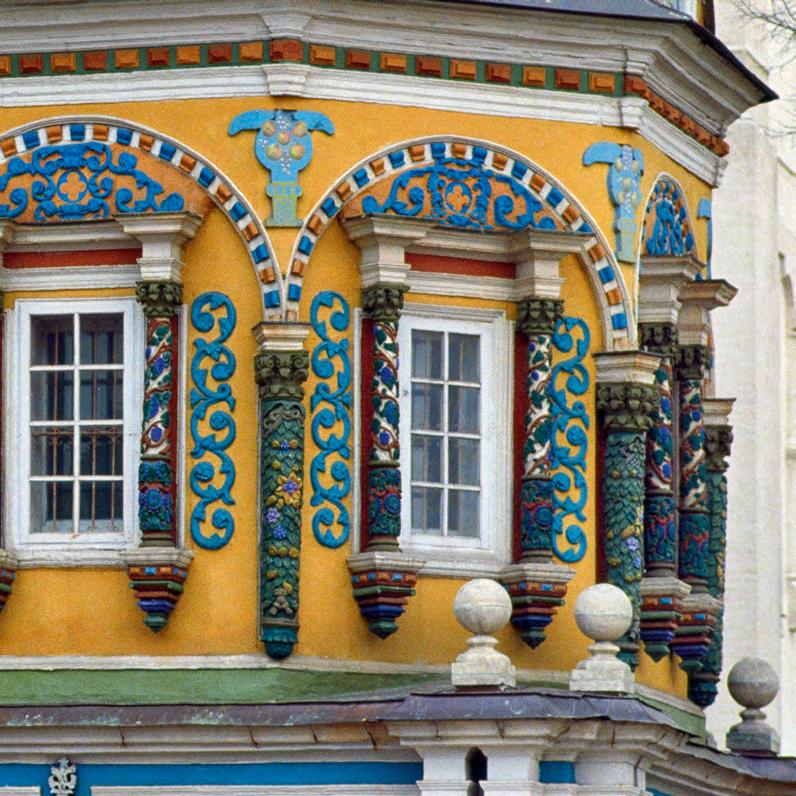
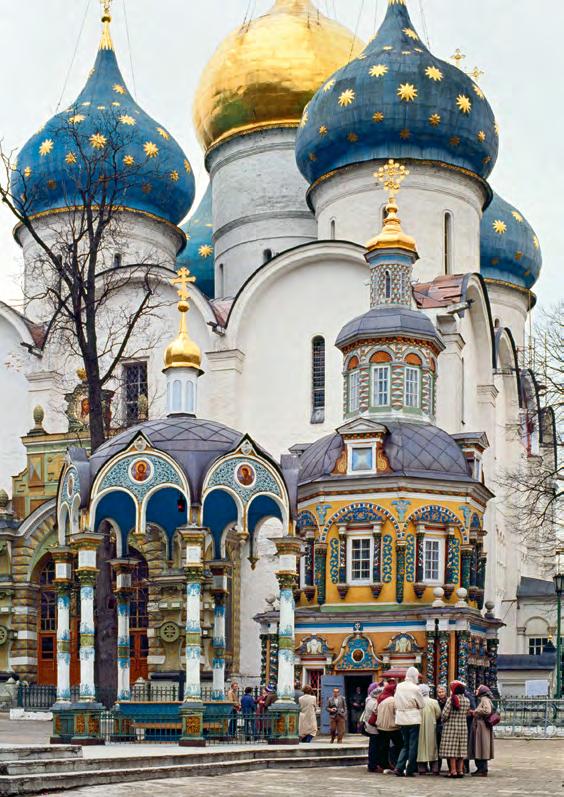
144
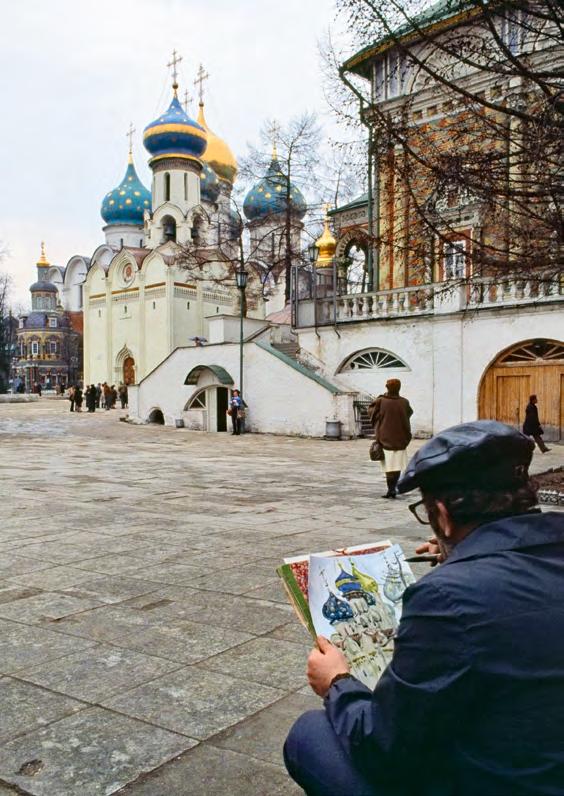
145
San Pietroburgo, Russia, 1985
Saint Petersburg, Russia, 1985
Quando Elio Ciol la fotografa, nel 1985, San Pietroburgo si chiama ancora Leningrado (la faccenda durava dal 1924, per evidenti legami con la rivoluzione bolscevica) e fa parte dell’Unione Sovietica.
Pochi anni e, almeno politicamente, il mondo cambierà.
Fondata nel 1703 dallo zar Pietro il grande, la città ha prestato i suoi spazi alle pagine di Puškin, Gogol e Dostoevskij; è cresciuta grazie alla maestria di architetti italiani quali Carlo Rossi, che nel primo ‘800 ha progettato il complesso di Piazza del Palazzo.
Delle proporzioni neoclassiche dei suoi edifici qualcosa rimane in queste immagini, ma a fare da sfondo al rosso linguaggio di una propaganda prepotente, e proprio per questo condannata a non sopravvivere alla sua enfasi coreograficamente fuori scala.
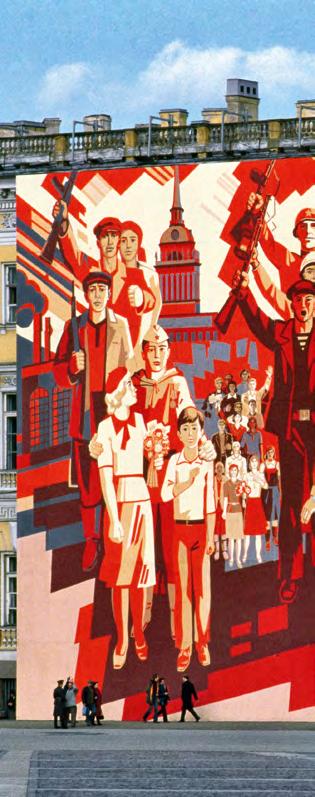
When Elio Ciol photographed it in 1985, Saint Petersburg was still called Leningrad (having been given this name in 1924 following the Bolshevik revolution) and was under the Soviet Union. Just a few years later, the world would be transformed, at least politically.
Founded in 1703 by Tsar Peter the Great, the city features in the works of Pushkin, Gogol and Dostoevsky; its glory comes in part from the talents of Italian architects, such as Carlo Rossi, who designed the Mikhailovksy Palace and Art Square complex in the early 19th century. The images reveal something of the neoclassical proportions of the buildings, but only as the backdrop to the red language of propaganda too arrogant and bullying, too completely out of step and scale with its surroundings, to survive.
146
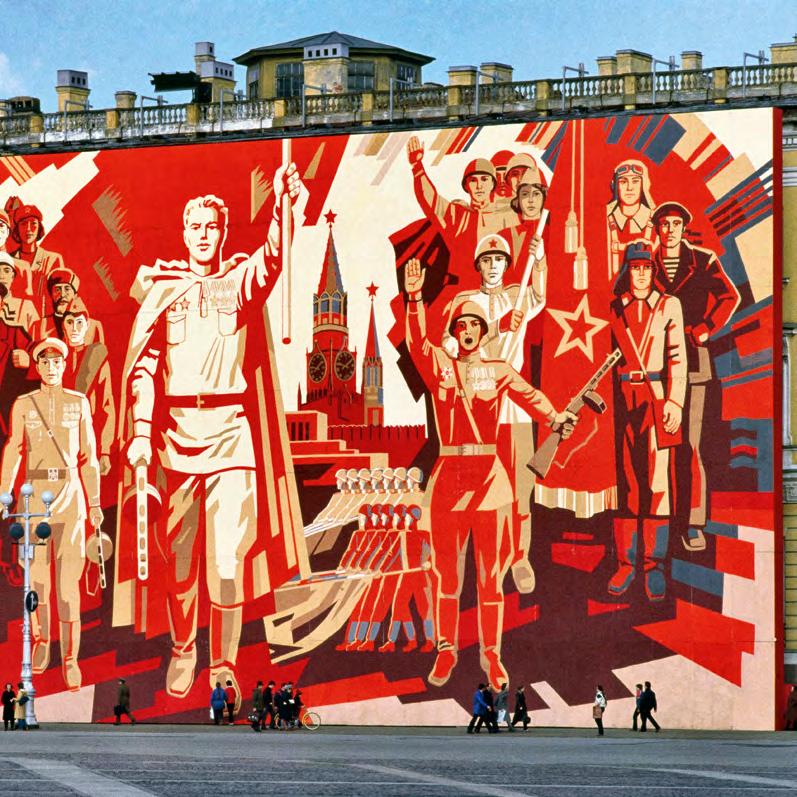
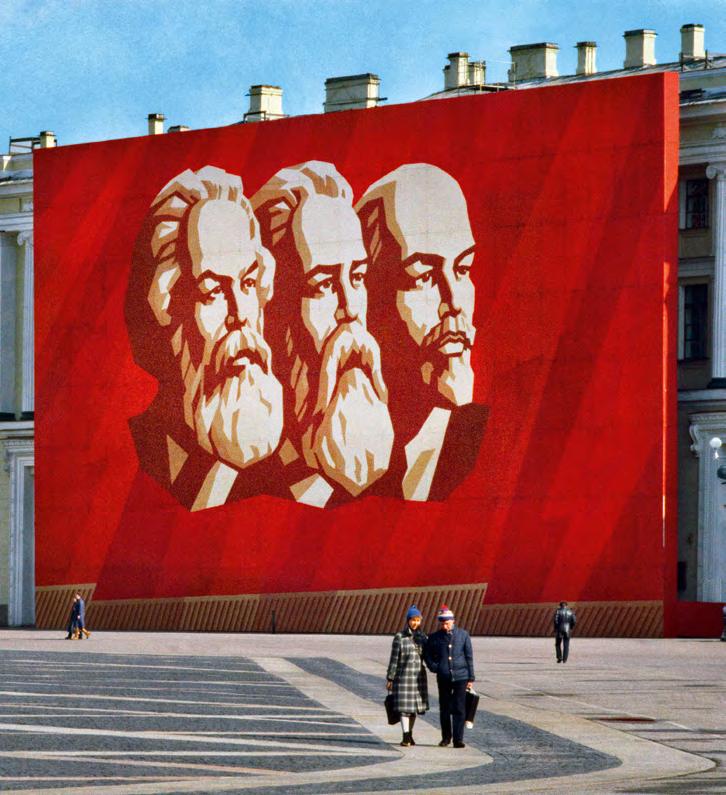
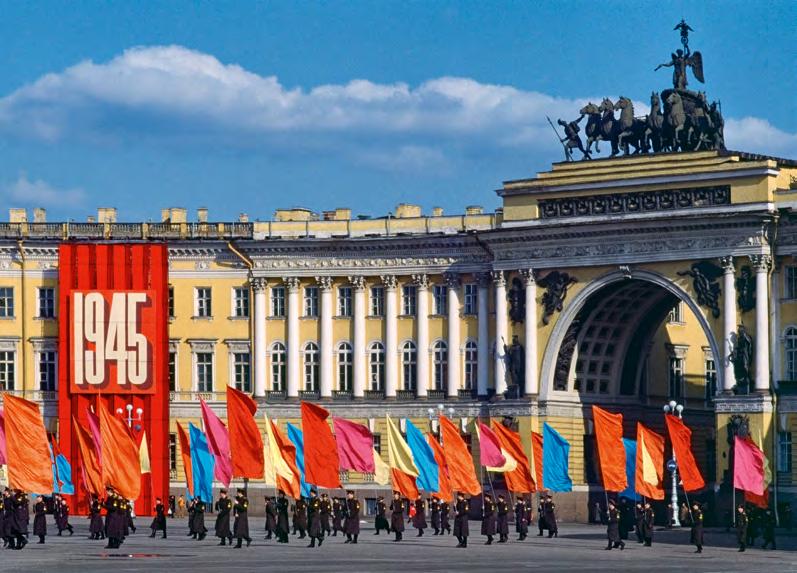
149
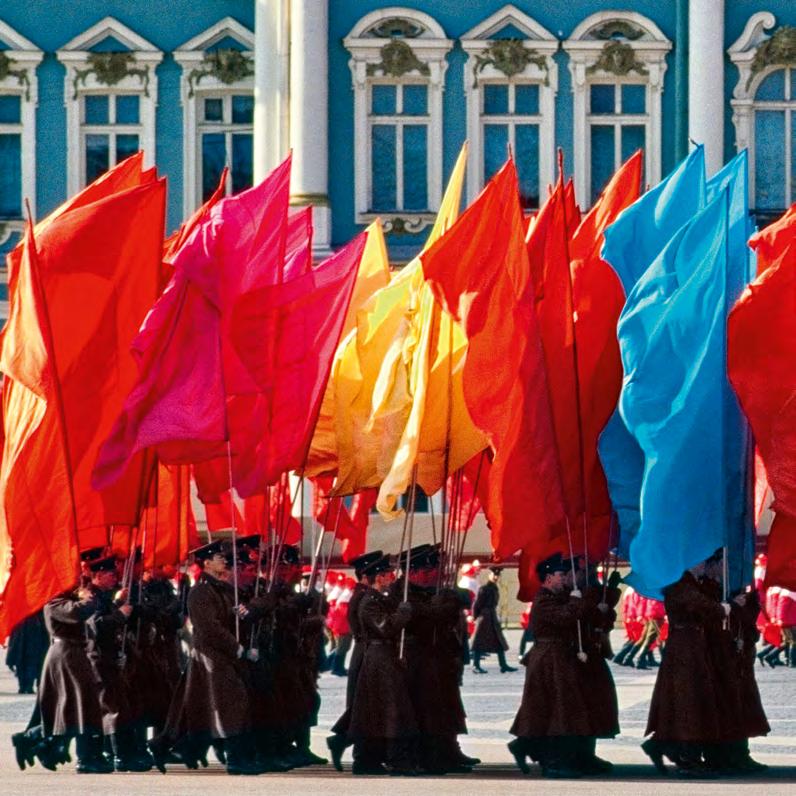
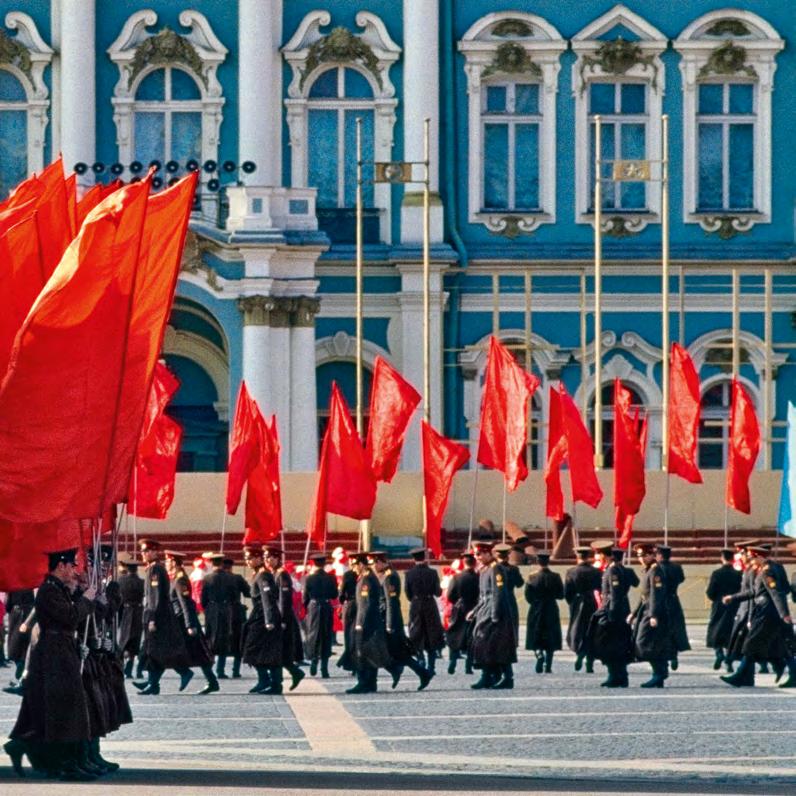
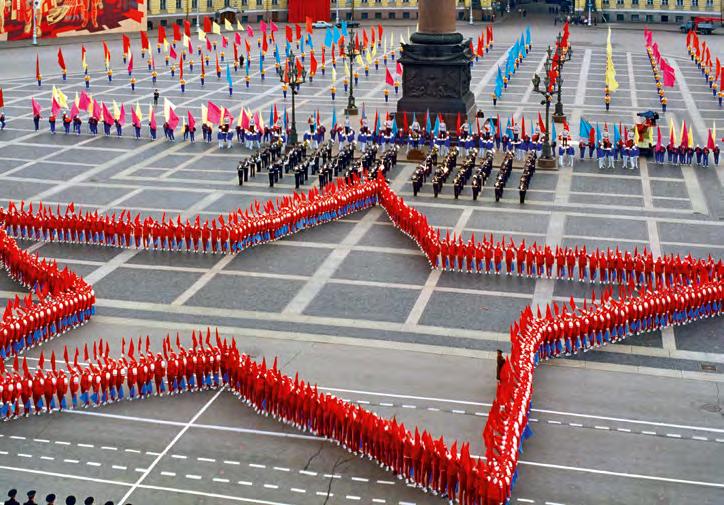
152
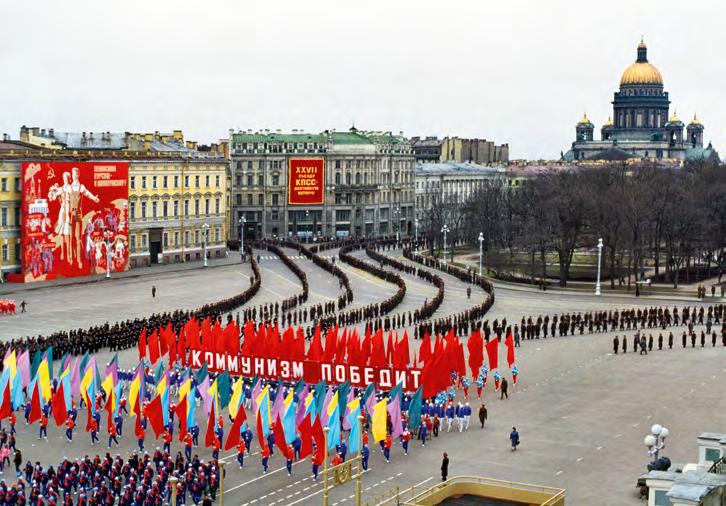
153
Nepal, 1982
Nepal, 1982
Queste immagini narrano la storia di due differenti precarietà. Una, elegantissima nel suo tentativo di indirizzare il divenire della natura, è quella dei terrazzamenti che disegnano il territorio sulla strada per Dhulikhel, a est di Katmandu: rughe suscitate nel terreno per accogliere coltivazioni, che nel loro reticolo sembrano esteticamente concepite come un paesaggio di Music.
L’altra, malamente arrangiata ma profondamente umana, è quella dei “laghetti tuttofare” a Chapgaun. Qui l’idea di esistenza urbana mostra di sapersi declinare, con le miserie e le risorse che le sono proprie, a qualsiasi altitudine; anche intorno a uno specchio d’acqua nel quale si riflettono le movenze quotidiane di una comunità, della quale il fotografo racconta – alla distanza di un profondo rispetto – le piccole destrezze nel sopravvivere.
These images tell the story of two different fragilities. One, so elegant in its attempt to shape the future of nature, is the construction of terraces in the land along the road to Dhulikhel, east of Kathmandu: these manmade wrinkles were designed to encourage the growth of crops but their lines seem to have been by Music. The other, less deliberately composed but intensely human, is represented by the “multi-use” ponds in Chapagaun. Here, the idea of urban living has many inflections and communicates its unique deficiencies and resources – at any altitude. Little acts of survival and the daily movements of a community are seen reflected in a pool of water, photographed from a profoundly respectful distance.
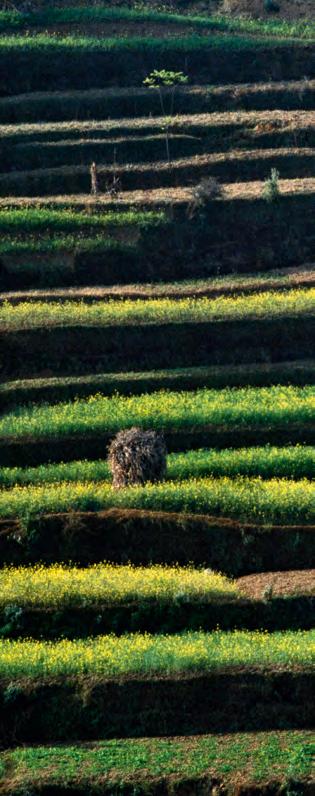
154
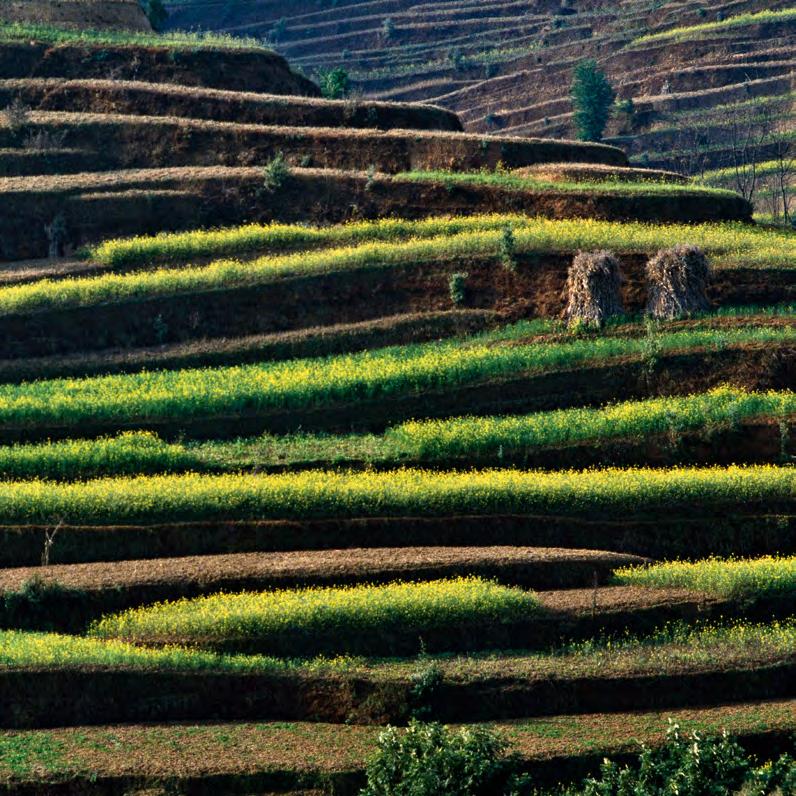

156

157
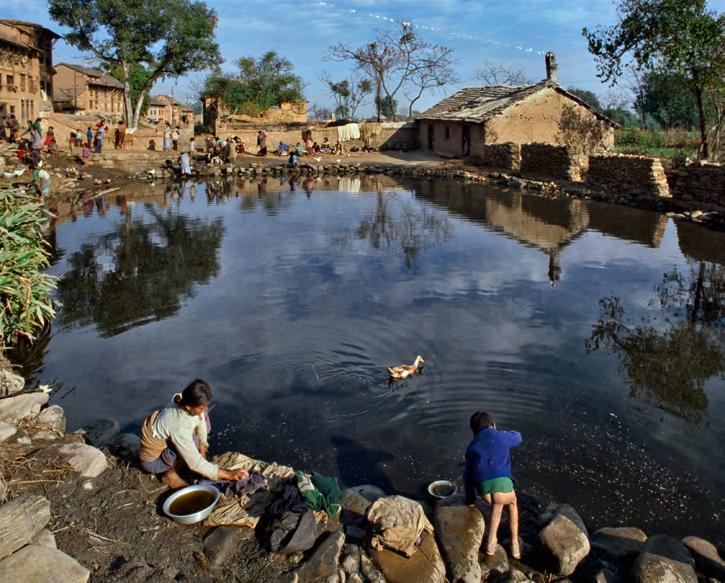
158
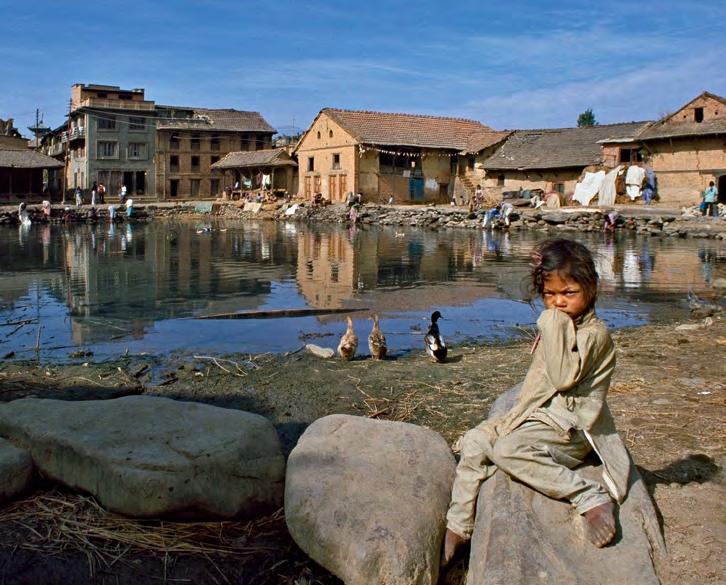
159
Varanasi, India, 1981
Varanasi, India, 1981
Varanasi (Benares), nel Nord-Est dell’India, è un centro urbano con più di tre milioni di abitanti; un agglomerato fittissimo di edifici e di strade congestionate, rumorose, inospitali.

Ciol sceglie però di inquadrare le gradinate (i ghat) che scendono verso il Gange, dove il caotico flusso umano della città si fa processione.
Lungo il fiume l’orizzonte si allarga, ma le fotografie si concentrano sulle persone e le loro abluzioni. Scopriamo le figure distribuite in equilibri compositivi à la Poussin, e ciò nonostante vivissime nella loro partecipazione al rito collettivo di purificazione nel fiume sacro dell’Induismo; qui il ciclo della morte e della rinascita si misura anche nelle minime increspature che, vicino a riva, frantumano a pelo d’acqua il riflesso di una persona.
Varanasi (Benares) is a city with a population of over three million inhabitants located in the north-east of India, a tightly packed hive of buildings and busy, noisy, inhospitable streets.
Ciol, however, turns his back on the city streets to focus on the steps (ghat) leading down to the Ganges, where the tumult of human movement becomes a procession. The river opens up the horizon, but his photographs concentrate on the people as they perform their ablutions. The figures naturally form balanced compositions à la Poussin, but this static grace is counteracted by the vital energy expressed through the collective rite of purification in the sacred river of Hinduism. Here, the cycle of death and rebirth can be felt even in the tiny ripples near the bank that fracture the reflections of the faithful on the surface of the water.
160
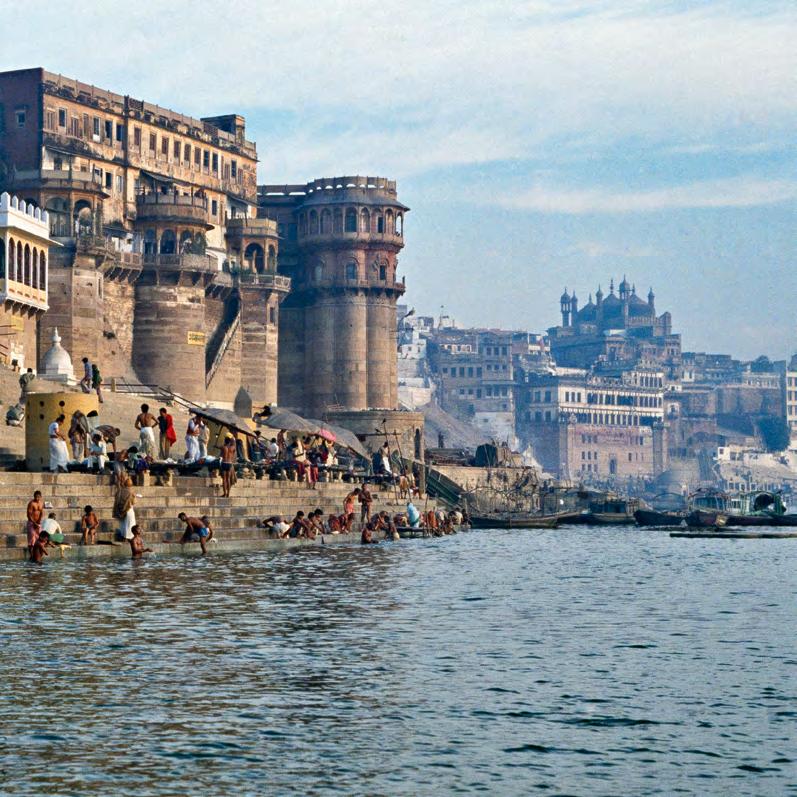
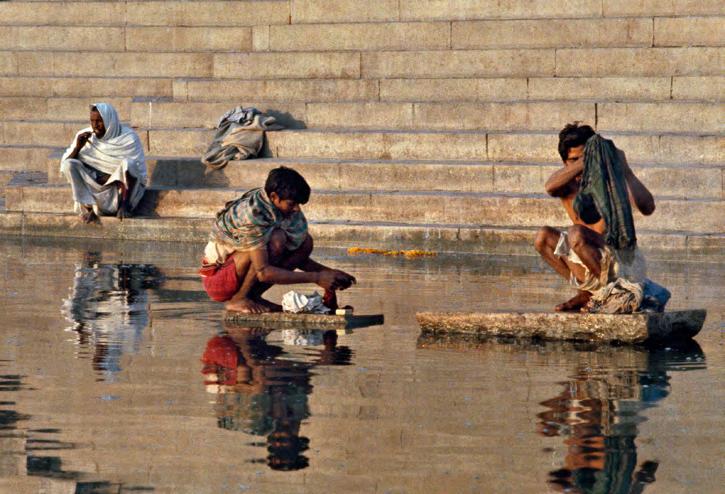
162
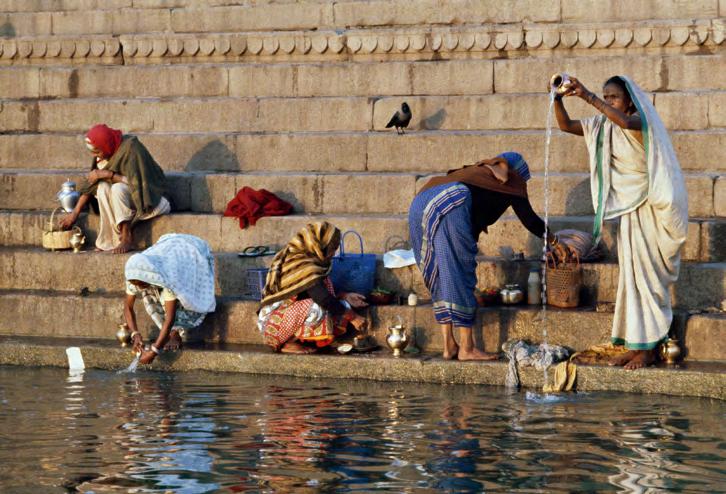
163
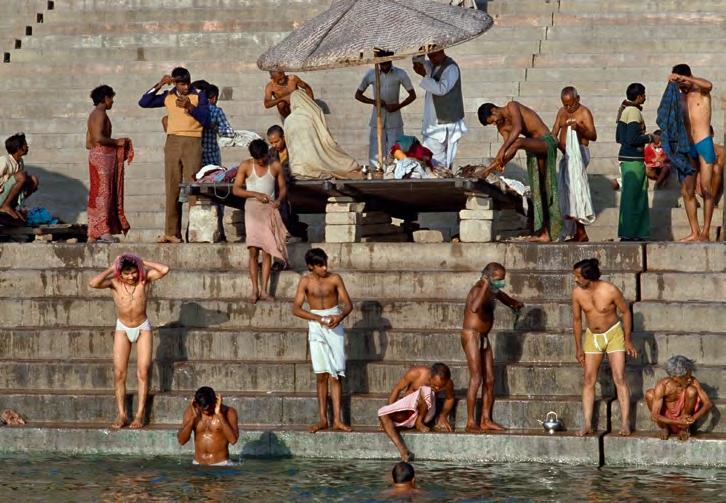
164
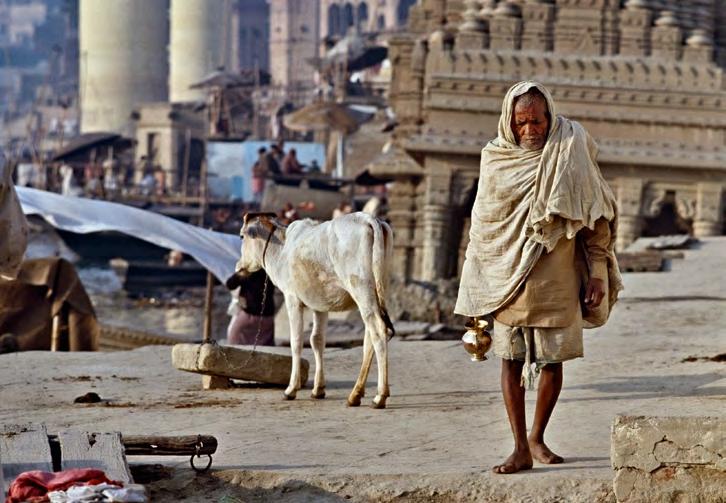
165
Monastero di Rila, Bulgaria, 2007
Rila
Monastery, Bulgaria, 2007
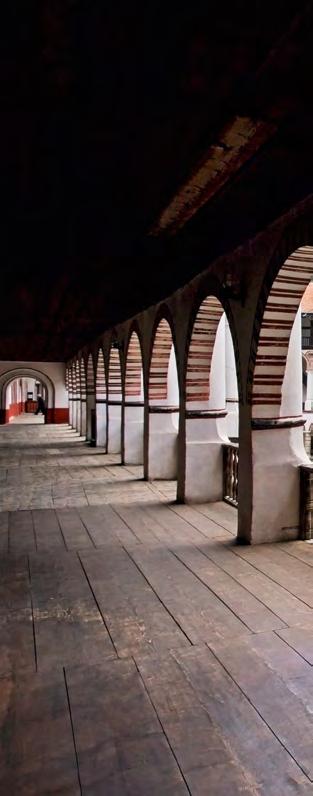
Fondato nel X secolo da San Giovanni di Rila, il monastero venne distrutto nel ‘300 durante l’occupazione ottomana e ricostruito fra XVIII e XIX secolo.
Al suo interno, il portico della chiesa della Natività della Vergine offre un tipo di immagine sacra diverso da quello che, nella nostra tradizione, accompagna solitamente la meditazione spirituale. Questo è un progetto di forme e colori visibilmente in eccesso, che la fotografia decide di assecondare nel suo schema di contrapposizione fra santità e dimensione demoniaca: ori ed azzurri abitati dagli angeli, penombre rugginose che stridono del digrignare di fauci luciferine, sfogliabili come le pagine tridimensionali di un libro pop-up.
Founded in the 10th century by Saint Ivan of Rila, the monastery was destroyed in the 14th century during the Ottoman occupation and rebuilt between the 18th and 19th centuries.
Inside the compound, the portico of the main church, dedicated to the Nativity of the Virgin Mother, gives us a kind of sacred image which is different from the kind which usually accompanies spiritual meditation in the Western tradition. Colours and patterns abound in excess, and the photograph echoes this in its contrasting of holiness and evil: the angels live in a sphere of gold and blue, while rusty shadows wail with the gnashing of a bevy of demoniacal jaws, which jump out at the viewer like the pages of a pop-up book.
166
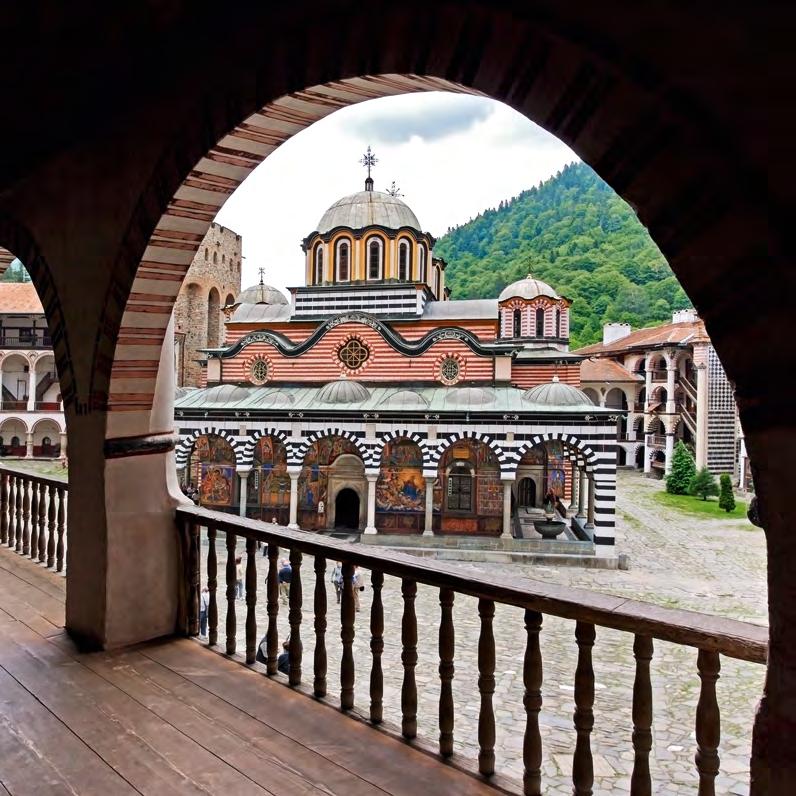
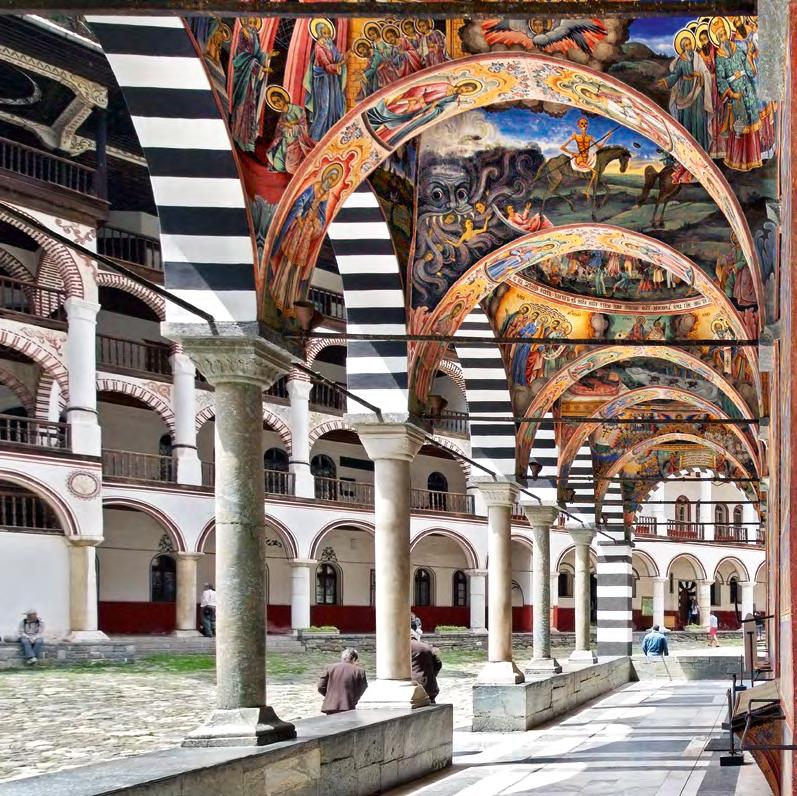
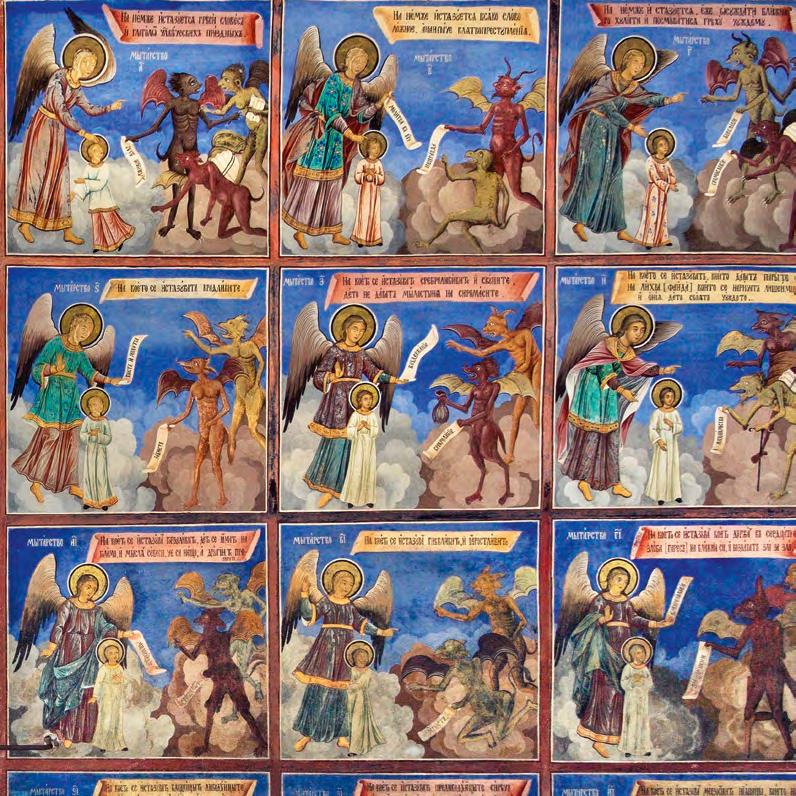
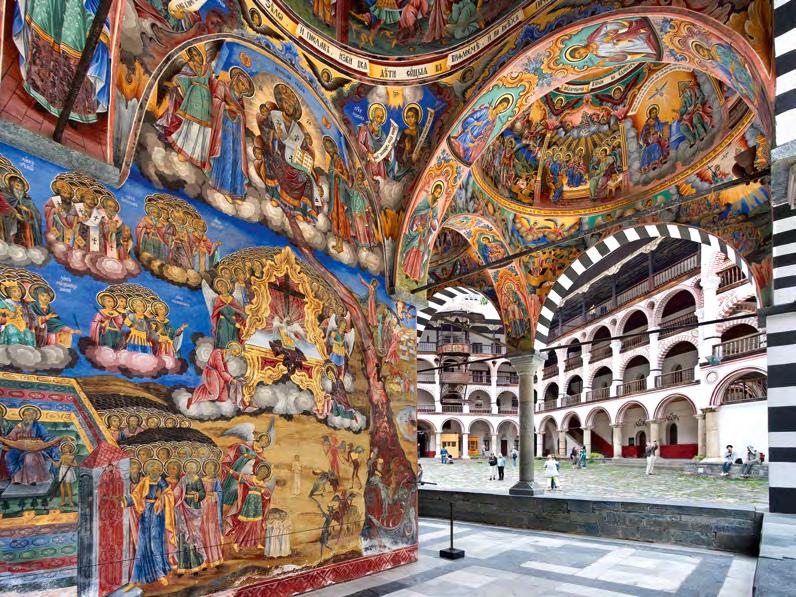
170
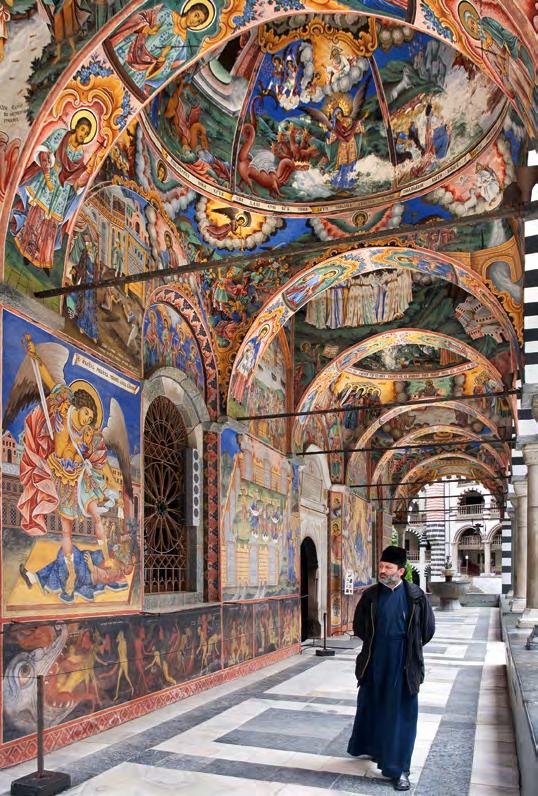
171
Cappadocia, Turchia, 1983
Cappadocia, Turkey, 1983
Di fronte a queste immagini c’è quasi imbarazzo nel determinare la dimensione di quanto si vede.
Casette di Puffi o di Hobbit? Sassi piantati in un brullo giardino orientale?
Invece i “Camini delle fate” sono pinnacoli di tufo alti decine di metri, presenti sugli altipiani dell’Anatolia; strutture modellate nei millenni dagli agenti atmosferici, a volte risparmiate dall’erosione grazie alla presenza di blocchi di pietra più consistente alla loro sommità – che oggi recitano la parte di surreali coronamenti – e poi scavate dagli uomini per ricavarne un rifugio, intagliato nel geologico pan di zucchero.
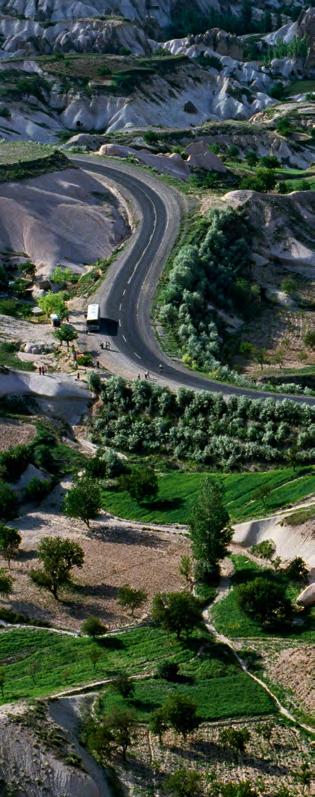
Alla fotografia non sfugge l’occasione di giocare con le forme improbabili, con le sproporzioni, e di ritessere il legame delle rocce con il cielo che le ha lentamente plasmate.
Looking at this photograph, it’s hard to get a grip on the size of what we’re looking at. Are these Smurf cottages? The homes of Hobbits?
Stones placed symbolically in an East-Asian garden?
The answer is one of these; the ‘fairy chimneys’ are cones of tuff rock stretching dozens of metres up towards the sky from the plains of Anatolia. These unique formations are the result of thousands of years of sculpting by wind and rain; some have been saved from erosion thanks to having blocks of harder rock at the top (which now look like surreal crowns), while others have been hollowed out by men seeking shelter in this geological sugarloaf.
The photograph jumps at the chance to play with these unlikely forms and their disproportions, and to reweave the bond with the sky that slowly shaped them.
172
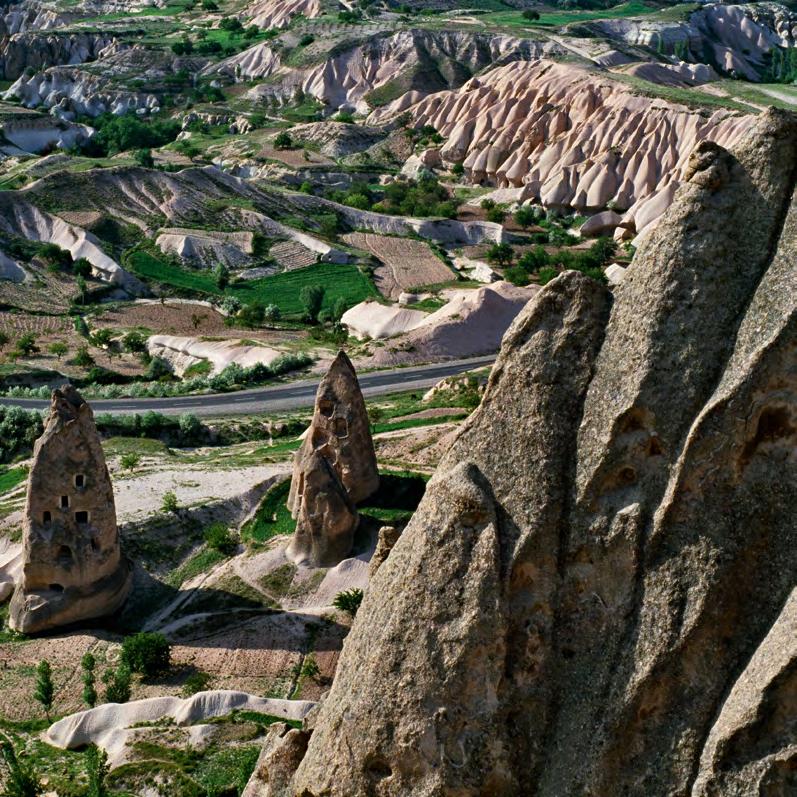
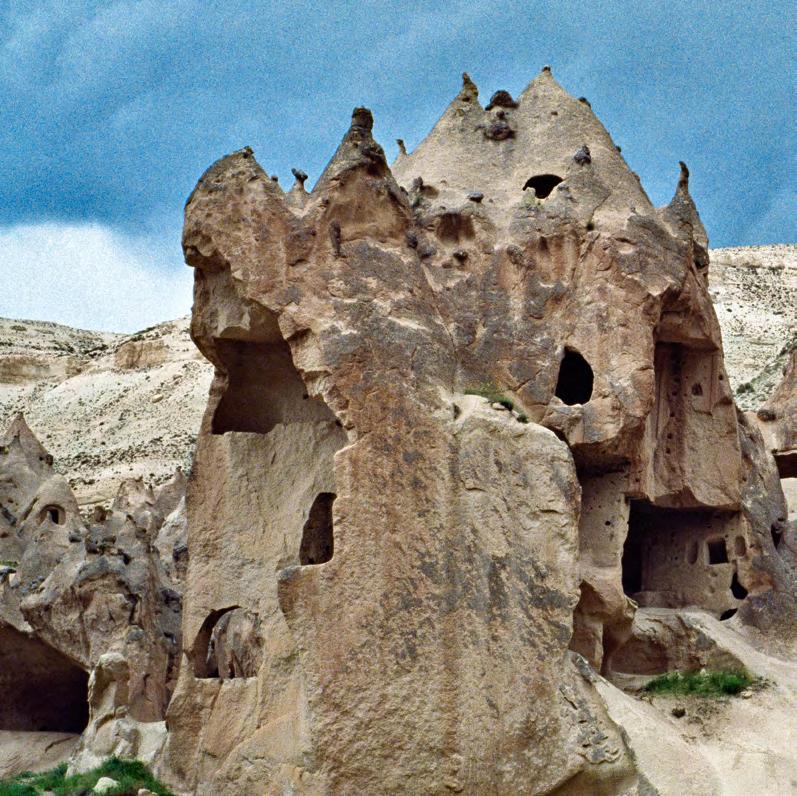
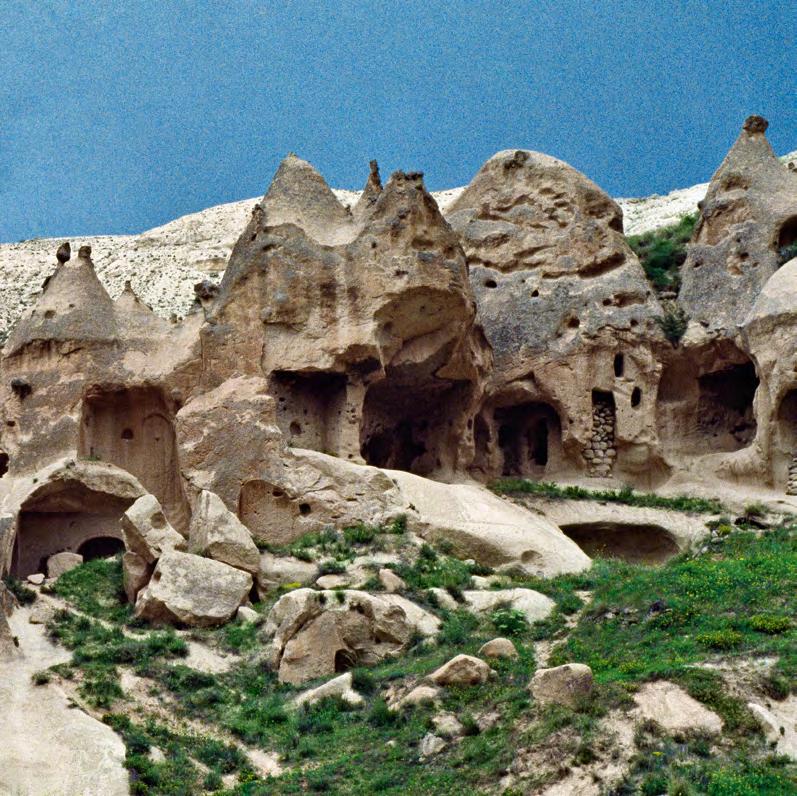

176
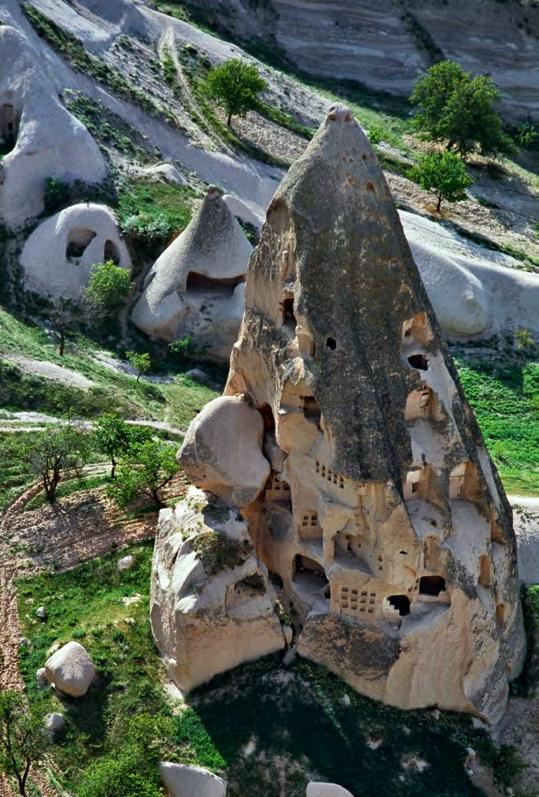
Gerasa, Giordania, 1989
Jerash, Jordan, 1989
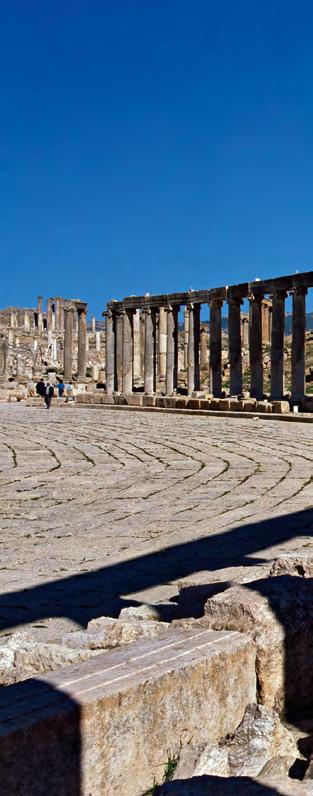
Le immagini di Gerasa vivono nella densità di blu e azzurri quasi astratti, non atmosferici, che accentuano la componente metafisica della scena. D’altronde che bisogno ci sarebbe, nel cielo della Giordania, di una nube, d’uno sbuffo di concreto vapore acqueo, al cospetto di colonne che si ergono in ellisse con la tacita sicurezza di un’orbita astrale?
È evidente che la storia, con i quasi duemila anni trascorsi dal massimo sviluppo della città sotto l’impero romano, e con le tracce lasciate sulla carta geografica di un Medio Oriente imputridito in conflitti solo apparentemente a sfondo religioso, scivola sulla pietra quale mero accidente.
La soggezione nei confronti dell’eleganza di fusti e capitelli corinzi avrebbe potuto spingere qualcuno a distruggerli come i monumenti di Palmira. Ma la loro bellezza avrebbe scrollato le spalle di fronte alla piccineria degli uomini, che forse si illudono di averli davvero a suo tempo creati.
These images of Jerash are immersed in a thick soup of blues that move away from the plane of the atmospheric phenomenon towards abstraction and the metaphysical element of the scene. After all, in the sky above Jordan, why would we need clouds, puffs of water vapour, when, down below, we have columns forming an ellipse with the silent certainty of an astral orbit?
It’s clear that history – nearly two thousand years having passed since the city’s period of maximum expansion under the Romans and maps of the Middle East changing with the tides of conflicts which are only apparently based on religious differences – slides off the stone like the slightest of accidents.
The majestic elegance of the Corinthian shafts and capitals could have riled people into destroying them as they did with the great monuments of Palmira, but their beauty would have shrugged its shoulders at the smallness of men, who shouldn’t think they were actually the creators of these monuments.
178
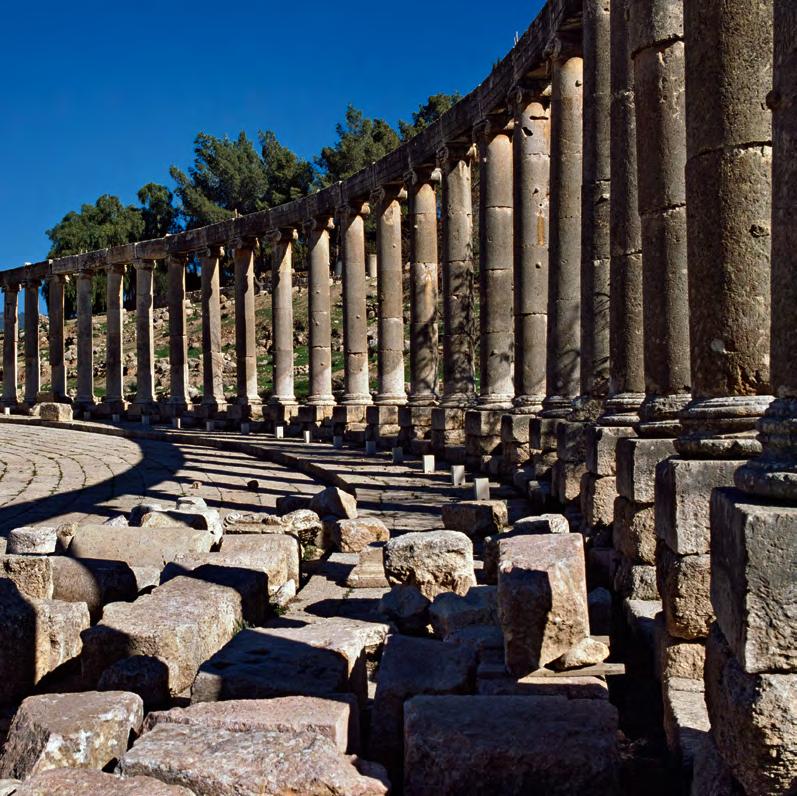
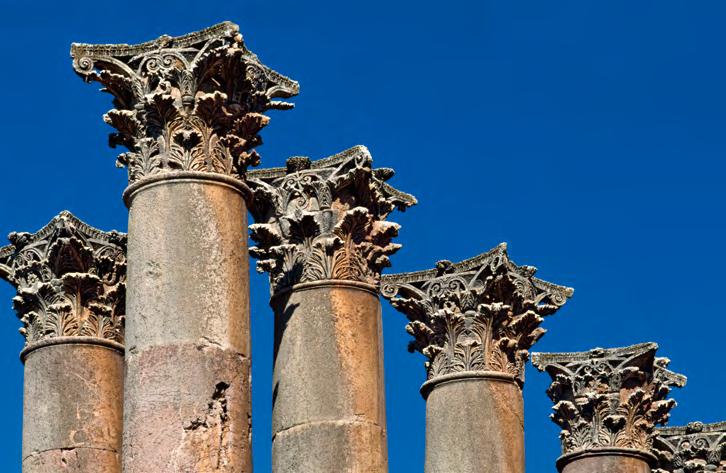
180
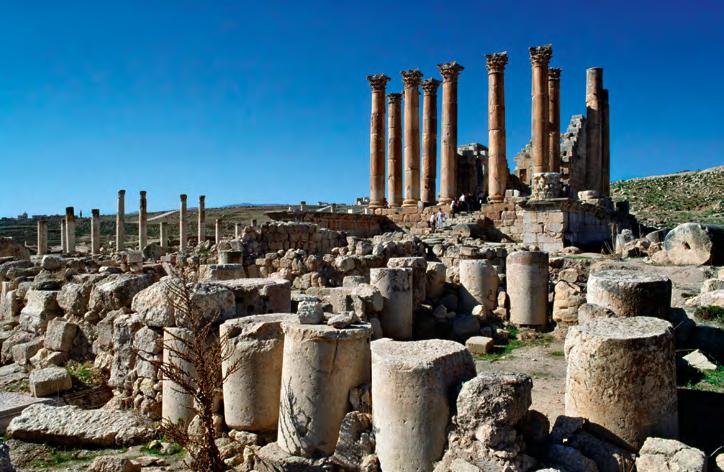
181
Petra, Giordania, 1989
Petra, Jordan, 1989
I monumenti funerari di Petra vennero scavati nell’arenaria durante il regno nabateo; ad esempio, il celebre El Khasneh (Tempio del Faraone) risale probabilmente al I secolo a.C., come il cosiddetto Monastero (in origine destinato ala sepoltura del re Obodas). E gli strati policromi della roccia che li accoglie derivano dagli ossidi variamente concentrati nelle fasi di sedimentazione, a partire dall’età paleozoica.
Ma queste fotografie parlano solo incidentalmente di geologia o di archeologia: sembrano piuttosto insistere sull’idea di indissolubile coesione fra natura e civiltà, come se la pietra restituisse all’esercizio dello sguardo forme e colori che vi giacevano, scientemente concepiti, fin dall’inizio dei tempi.
The funerary monuments of Petra were carved from their sandstone surroundings during the time of the Nabataean Kingdom. The renowned Al Khazneh (the Treasury of the Pharoah) probably dates back to the 1st century BC, just as the so-called Monastery (originally intended as the tomb for King Obodas). The coloured ripples in the rock they were carved from come from the varying concentrations of oxides at different stages of the sedimentation of the sand, from the Paleozoic era onwards.
However, these photographs barely touch on the subjects of geology or archaeology: their intention seems more to be to investigate the idea of the unbreakable bond between nature and civilization, as though the stone was reacting to man’s gaze by giving it back knowingly created forms and colours that have been lying there since the dawn of time.
182
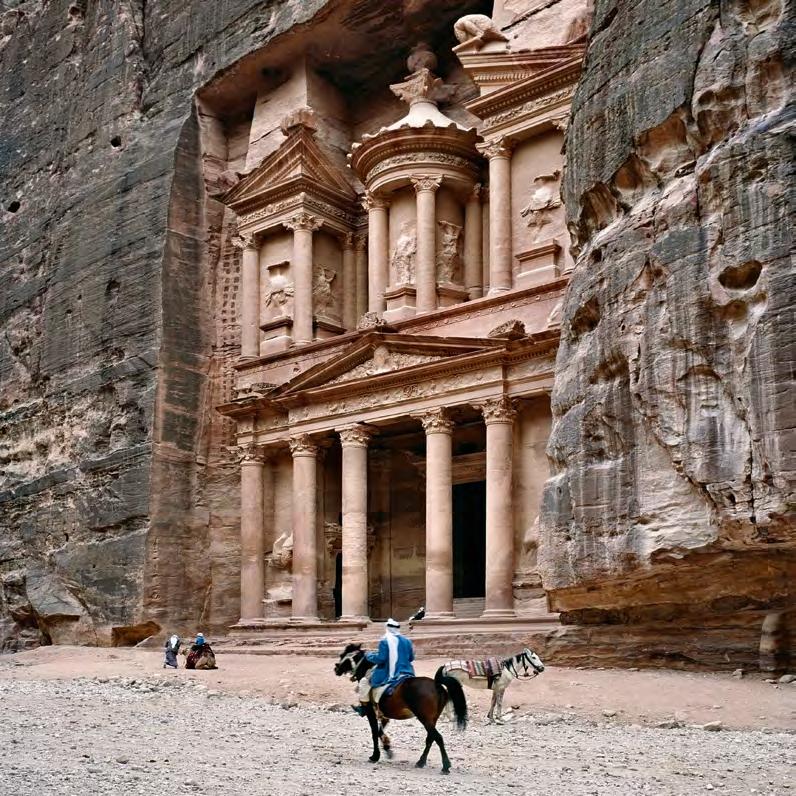
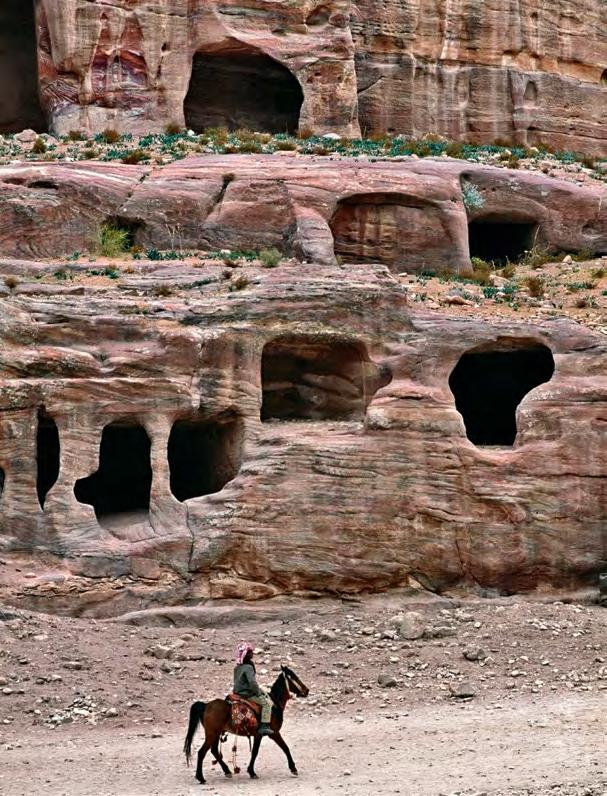
184

185
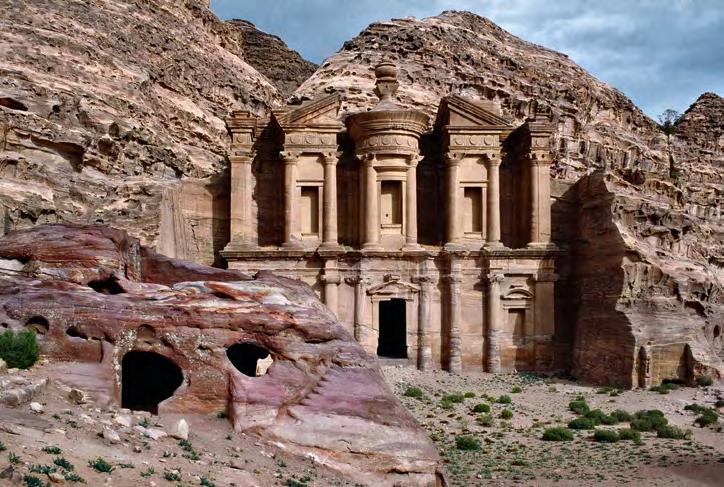
186
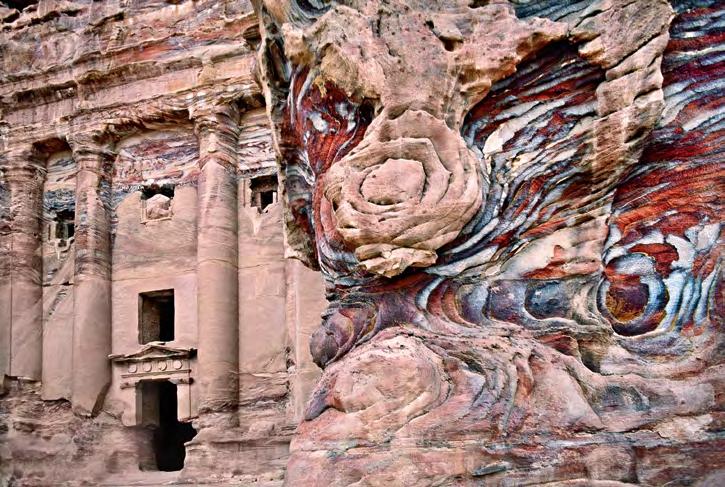
187
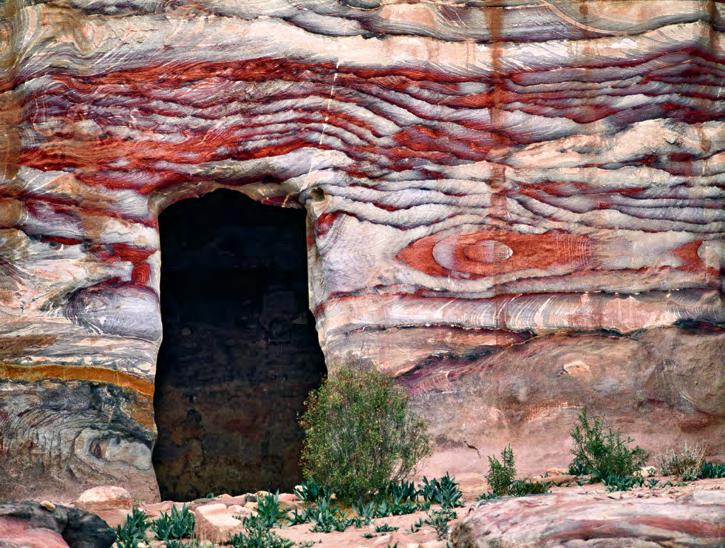
188

189
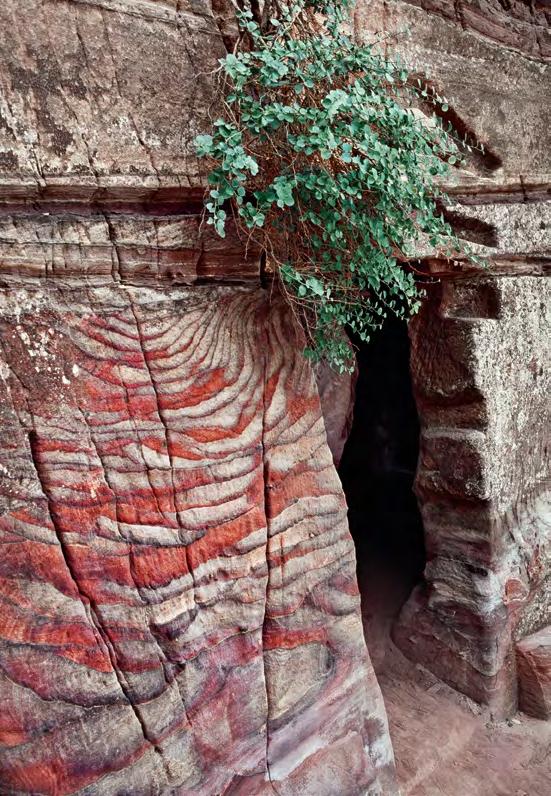
190
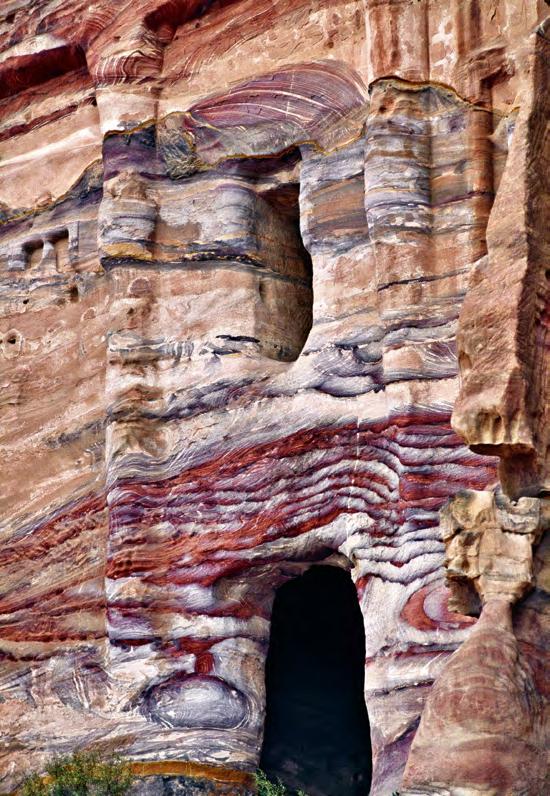
191
Isola di Santorini, Grecia, 1986
The Island of Santorini, Greece, 1986
Mare e cielo, intorno, sono di un azzurro così saturo come solo in Grecia si incontra, e viene quasi il dubbio che i candidi intonaci degli edifici siano stampati nel sale.
Santorini, la più meridionale delle isole Cicladi, ha un’anima di vulcano; eppure come si fa ad immaginare, fra queste architetture che respirano sonnacchiose nella luce, che qui una colossale eruzione abbia distrutto Atlantide e ne abbia suscitato il mito?
I volumi di case e chiese si innestano come fossero i gradini di una sola, labirintica scala, che sale dal blu verso il blu. Intorno, neppure una voce; nessuno a cui chiedere una limonata allo zenzero, parakalò…
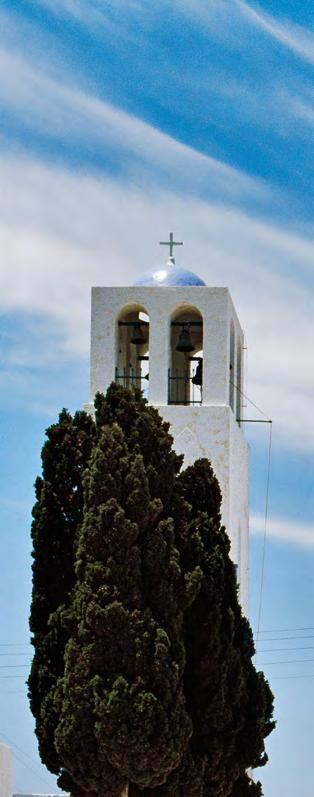
The sea and the sky are a deep blue that can be found only in Greece and the shimmering white of the buildings makes them look as though they’ve been rolled in salt.
Santorini, the southernmost of the Cyclades Islands, has the soul of a volcano, but when we look at these stolid buildings dozing in the sun, it seems impossible that an enormous eruption here sent Atlantis to the bottom of the sea, leaving only a legend behind.
The forms of the homes and churches fit together as if they were the steps of a single, maze-like stairway from the blue of the sea to the blue of the sky. All around is silent; there’s not a soul we can ask for a ginger beer, parakaló…
192

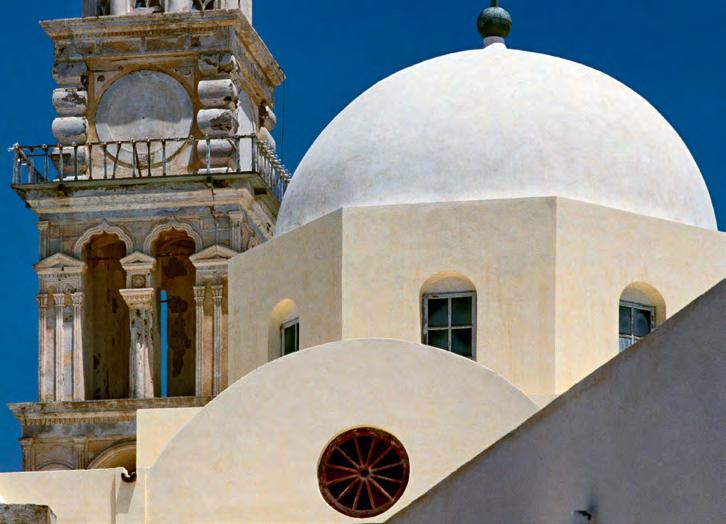
194
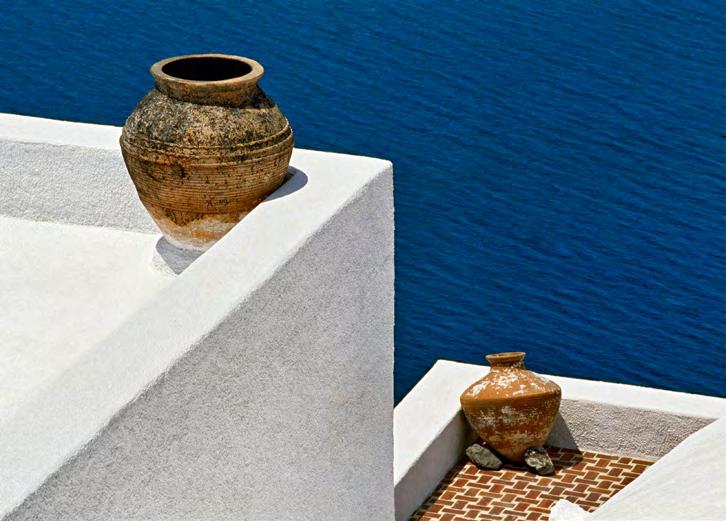
195


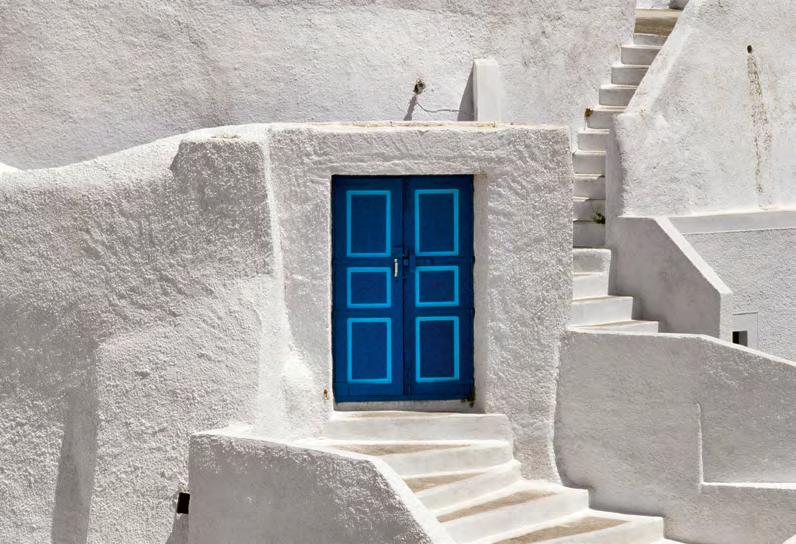
198
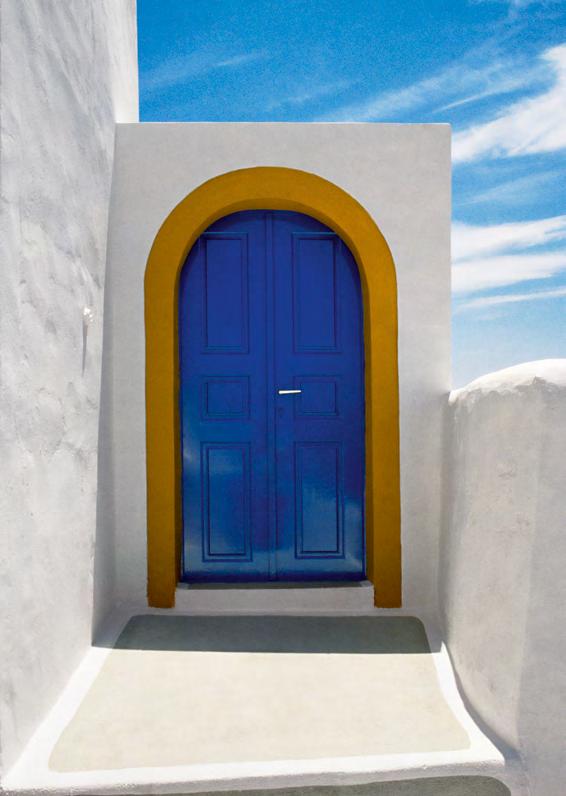
RESPIRI DI VIAGGIO ELENCO DELLE FOTOGRAFIE IN MOSTRA
Spagna
pag. 35 Alhambra B, Granada 1994
pag. 36 Alhambra A, Granada 1994
pag. 37 Alhambra C, Granada 1994
pag. 38 Alhambra E, Granada 1994
pag. 39 Alhambra F, Granada 1994
pag. 41 La Giralda E, Siviglia 1994
pag. 43 Cattedrale di Siviglia A, 1994
pag. 44 Cattedrale di Siviglia D, 1994
pag. 45 Cattedrale di Siviglia B, 1994
pag. 47 Casa di Pilato A, Siviglia 1994
pag. 48 Casa di Pilato B, Siviglia 1994
pag. 49 Casa di Pilato D, Siviglia 1994
pag. 51 Moschea di Cordova G, 1994
pag. 52 Moschea di Cordova B, 1994
pag. 53 Moschea di Cordova C, 1994
pag. 55 Museo Guggenheim L, Bilbao 2007
pag. 56 Museo Guggenheim B, Bilbao 2007
pag. 57 Museo Guggenheim F, Bilbao 2007
pag. 58 Museo Guggenheim I, Bilbao 2007
Egitto
pag. 61 Kôm Ombo A, 1980
pag. 62 Sfinge, necropoli di Giza 1980
pag. 64 Kôm Ombo B, 1980
pag. 65 Tempio Funerario della Regina Hatshepsut, Valle dei Re 1980
Libia
pag. 67 Mercato delle stoffe A, Leptis Magna 2002
pag. 68 Nuovo Foro Severiano E, Leptis Magna 2002
pag. 69 Nuovo Foro Severiano D, Leptis Magna 2002
pag. 70 Particolare Arco di Settimio Severo, Leptis Magna 2002
pag. 71 Nuovo Foro Severiano A, Leptis Magna 2002
pag. 73 Graffiti rupestri G, Wadi Mathendush 2001
pag. 74 Graffiti rupestri F, Wadi Mathendush 2001
pag. 75 Graffiti rupestri H, Wadi Mathendush 2001
pag. 76 Graffiti rupestri I, Wadi Mathendush 2001
Armenia
pag. 79 Megaliti E, Zorats Karer 2005
pag. 80 Megaliti D, Zorats Karer 2005
pag. 81 Megaliti A, Zorats Karer 2005
pag. 82 Chiesa di S. Hirpsimé, Edjmiatzin 2005
pag. 83 Khatchkar e Cappella di S. Astvatzatzin, Noravank 2005
Mongolia
pag. 85 Karakorum G, 1987
pag. 86 Karakorum A, 1987
pag. 87 Karakorum C, 1987
pag. 88 Karakorum D, 1987
pag. 89 Karakorum F, 1987
pag. 91 Monastero 1904 A/G, Ulan Bator 1987
pag. 92 Monastero 1904 B/G, Ulan Bator 1987
pag. 93 Monastero 1904 E/G, Ulan Bator 1987
pag. 94 Monastero 1904 D/G, Ulan Bator 1987
pag. 95 Monastero 1904 G/G, Ulan Bator 1987
Cina
pag. 97 La Città Proibita, Pechino 1998
pag. 98 La Grande Muraglia A, 1998
pag. 100 La Grande Muraglia B, 1998
pag. 102 Collina Fubo A, Guilin 1998
pag. 103 Collina Fubo B, Guilin 1998
pag. 104 Esercito di terracotta, Xian 1998
Uzbekistan
pag. 107 Le Mura di Khiva B, 2009
pag. 108 Le Mura di Khiva A, 2009
pag. 110 Le Mura di Khiva C, 2009
pag. 112 Le Mura di Khiva D, 2009
pag. 113 Le Mura di Khiva E, 2009
pag. 115 Palazzo Tosh-Hovli B, Khiva 2009
pag. 116 Palazzo Tosh-Hovli F, Khiva 2009
pag. 118 Palazzo Tosh-Hovli C, Khiva 2009
pag. 119 Palazzo Tosh-Hovli E, Khiva 2009
pag. 121 Palazzo Tosh-Hovli G, Kiwa 2009
200
pag. 123 Casa dell’ Ambasciatore A, Tashkent 2009
pag. 124 Casa dell’ Ambasciatore C, Tashkent 2009
pag. 126 Casa dell’ Ambasciatore D, Tashkent 2009
pag. 127 Casa dell’ Ambasciatore B, Tashkent 2009
pag. 128 Casa dell’ Ambasciatore F, Tashkent 2009
pag. 131 Madrasa di Mir-I-Arab e Minareto Kalon, Bukhara 2009
pag. 132 Madrasa di Mir-I-Arab, Bukhara 2009
pag. 133 Madrasa di Mir-I-Arab– part. A, Bukhara 2009
pag. 134 Madrasa di Mir-I-Arab –part. B, Bukhara 2009
pag. 137 Shah-I-Zinda A, Samarcanda 2009
pag. 138 Shah-I-Zinda C, Samarcanda 2009
pag. 139 Shah-I-Zinda D, Samarcanda 2009
pag. 140 Shah-I-Zinda G. Samarcanda 2009
pag. 141 Shah-I-Zinda F, Samarcanda 2009
Russia
pag. 143 Monastero di Zagorsk A, 1985
pag. 144 Monastero di Zagorsk D, 1985
pag. 146 Monastero di Zagorsk E, 1985
pag. 147 Monastero di Zagorsk G, 1985
pag. 149 Per il 40° della vittoria B, Leningrado 27/04/1985
pag. 150 Per il 40° della vittoria A, Leningrado 27/04/1985
pag. 151 Per il 40° della vittoria C, Leningrado 27/04/1985
pag. 152 Per il 40° della vittoria F, Leningrado 27/04/1985
pag. 154 Per il 40° della vittoria I, Leningrado 27/04/1985
pag. 155 Per il 40° della vittoria M, Leningrado 27/04/1985
Nepal
pag. 157 Verso Dhulikhel A, 1982
pag. 158 Verso Dhulikhel B, 1982
pag. 159 Verso Dhulikhel C, 1982
pag. 160 Chapgaun B, 1982
pag. 161 Chapgaun C, 1982
India
pag. 163 Varanasi A, 1981
pag. 164 Varanasi B, 1981
pag. 165 Varanasi C, 1981
pag. 166 Varanasi D, 1981
pag. 167 Varanasi E, 1981
Bulgaria
pag. 169 Monastero di Rila A, 2007
pag. 170 Monastero di Rila C, 2007
pag. 172 Monastero di Rila B, 2007
pag. 173 Monastero di Rila G, 2007
Turchia
pag. 175 Orthaisar, Göreme, Cappadocia 1983
pag. 176 Zelve A,Valle di Göreme, Cappadocia 1983
pag. 178 Zelve, Cappadocia 1983
pag. 179 Orthaisar, Cappadocia 1983
Giordania
pag. 181 Gerasa C, 1989
pag. 182 Gerasa F, 1989
pag. 183 Gerasa B, 1989
pag. 185 Petra A, 1989
pag. 186 Petra B, 1989
pag. 187 Petra C, 1989
pag. 188 Petra D, 1989
pag. 189 Petra E, 1989
pag. 190 Petra F, 1989
pag. 191 Petra G, 1989
pag. 192 Petra H, 1989
pag. 193 Petra I, 1989
Grecia
pag. 195 Santorini B, 1986
pag. 196 Santorini C, 1986
pag. 197 Santorini D, 1986
pag. 198 Santorini A, 1986
pag. 200 Santorini F, 1986
pag. 201 Porta sul cielo G, Santorini 1986
201
ELIO CIOL BIOGRAFIA
Elio Ciol è nato nel 1929 a Casarsa della Delizia (Pordenone) dove tuttora vive e lavora.
Ha iniziato a lavorare da giovane nel laboratorio fotografico del padre, dove ha acquisito una vasta esperienza tecnica e ha maturato un proprio modo di leggere il paesaggio e le opere d’arte.
Tra il 1955 e il 1965 ha fatto parte del cineclub di Udine. Ha realizzato in questo periodo vari documentari a passo ridotto, premiati ai concorsi di Montecatini e Salerno.
Dal 1955 al 1960 ha fatto parte del circolo fotografico “La Gondola” di Venezia.
Nel 1962 ha partecipato come fotografo di scena al film Gli Ultimi di Vito Pandolfi e padre David Maria Turoldo.
Nel 1963, a Milano, ha collaborato con Luigi Crocenzi alla realizzazione della “Fondazione Arnaldo e Fernando Altimani per lo studio e la sperimentazione sul linguaggio per immagini”.
Nello stesso anno ha esposto all’Ambrosianeum di Milano le foto di un suo servizio sull’attività di Gioventù Studentesca nella Bassa Milanese. A partire dagli anni Cinquanta ha elaborato un linguaggio personale nel settore della fotografia di paesaggio, che è andato costantemente evolvendosi fino ai tempi più recenti e che ha portato alla realizzazione di una lunga serie di libri fotografici e cataloghi di mostre.
Nello stesso periodo l’attività professionale del suo studio è stata dedicata prevalentemente alla produzione di campagne di documentazione di opere d’arte in Italia e in Europa che hanno portato Elio Ciol a collaborare a un imponente numero di pubblicazioni nel settore della storia dell’arte.
Tra le sue mostre più significative, la personale del 1999 promossa dai Civici Musei e dal Comune di Udine nella chiesa di San Francesco e quella promossa dal Comune di Padova nel 2002 nel palazzo del Monte di Pietà.
Nel 2000, contemporaneamente, ha esposto a New York Immagini d’Italia e a Parigi L’incanto della visione.
Nel 2004 la Provincia di Pordenone e il Comune di Casarsa della Delizia hanno promosso una mostra delle sue opere più recenti composta da dittici e trittici: Il fascino del vero
Nel 2007 è stato invitato per un’antologica al “Meeting per l’amicizia tra i popoli” a Rimini.
Nel 2009 una retrospettiva personale della sua intera opera è stata ospitata dal Centro Candiani di Mestre: Terre di poesia.
Nello stesso anno la Regione Friuli-Venezia Giulia, la Provincia di Pordenone, il Comune di Pordenone e il Comune di Casarsa, in occasione dei suoi 80 anni e 60 di attività professionale, hanno promosso tre mostre: a Villa Manin di Passariano Elio Ciol. Gli anni del Neorealismo, al Centro Studi Pier Paolo Pasolini di Casarsa La luce incisa, nella chiesa di San Francesco a Pordenone Il volto e la parola.
Nel 2011 la sua mostra Assisi: la densità del silenzio è stata inaugurata a Mosca, all’Accademia Russa di Belle Arti, dall’Ambasciatore italiano Antonio Zanardi Landi in occasione dell’anno Italia-Russia. La mostra è poi divenuta itinerante ed è stata esposta alla RosPhoto di San Pietroburgo, a Ekaterinburg, Novosibirsk, Omsk e Salekhard.
È quindi approdata a Tokyo e ad Assisi. Successivamente è stata richiesta ad Arezzo per la manifestazione Arezzo&Fotografia 2011.
Sempre nel 2011 è stato invitato a esporre sue foto alla 54° Biennale di Venezia, Padiglione Italia, a Trieste.
Dal 1° dicembre 2011 al 22 gennaio 2012 una sua antologica è stata esposta alla Classic Gallery di Mosca.
Nel febbraio 2012 è stato invitato a partecipare alla grande mostra “Il fuoco della natura” nel Salone degli Incanti a Trieste con due gigantografie lunghe 5 metri: Concrete astrazioni e nell’aprile 2012 alla collettiva Glocal3 al Centro Culturale Candiani di Mestre.
Ancora nel 2012 l’Istituto Italiano di Cultura di Mosca ha promosso, assieme alla Fondazione della Biennale d’Arte di Mosca, un tour della mostra Il volto e la parola nelle città di Irkustk, Novosibirsk e Mosca.
A dicembre 2012 Cinema Zero, per i 50 anni del film Gli ultimi, ha curato la mostra: “Turoldo e gli ultimi” a 50 anni dalla sua prima uscita nelle foto di Elio e Stefano Ciol, a Trieste nel Palazzo del Consiglio Regionale, a Pordenone nella sede di Cinema Zero e a Casarsa della Delizia nel Teatro Pasolini.
A marzo del 2013 ha esposto nell’Esedra di Levante di Villa Manin di Passariano (UD) la mostra Conoscersi per Riconoscersi promossa dai 5 Rotary della Provincia di Pordenone; a luglio è stato invitato a esporre a Ptui (Slovenia), in occasione dell’ 11° Festival di Art Stays, una selezione di foto di Gli anni del Neorealismo e La luce incisa. Ancora nel 2013 ha esposto ad Arles la mostra La luce incisa nel palazzo dell’Arcivescovado.
Dal 6 dicembre 2013 al 12 gennaio 2014 è stato invitato a esporre nella Galleria La Loggia di Capodistria una mostra dal titolo Anima Mundi. Dal 18 ottobre al 30 novembre ha partecipato con la sua mostra Gli anni del Neorealismo esposta a Legnano/Milano – Palazzo Leone da Peregoall’Europhotofestival organizzato dall’Archivio Fotografico Italiano. Nel 2015, dal 6 febbraio al 12 aprile, la Galleria Salizada di Venezia ha esposto ai Tre Oci, e nella propria Galleria, una serie di sue foto di paesaggi; mentre a Lugano, al Museo delle Culture, il 3 marzo è stata inaugurata la mostra Gli Adoratori della Croce. Armenia 2005; dal 20 marzo al 23 maggio una selezione delle immagini di Gli anni del Neorealismo e La luce incisa è stata esposta nella Pavelhaus Laafeld – Bad Radkesburg Austria. Dal 28 ottobre al 14 novembre, per il 40° anniversario della morte di Pier Paolo Pasolini, sue fotografie sono state esposte alla Galleria Giovanni Bonelli, Milano nella mostra “Pasolini, il poeta che sfidò il nulla” curata dal Centro Culturale di Milano. Dal 7 novembre 2015 al 28 febbraio 2016 alla Galleria Sagittaria del Centro Iniziative Culturali di Pordenone è stata
esposta la mostra Assisi. La densità del silenzio, poi nell’ambito del XXV Festival Internazionale di Musica Sacra, dall’ 1 ottobre al 13 novembre nell’Abbazia di Santa Maria in Sylvis di Sesto al Reghena Il canto della pietra, Armenia 2005
Il 28 dicembre a Casarsa durante il Consiglio Comunale, nella Sala Consiliare della residenza municipale di Palazzo Burovich de Zmajevich è stata resa pubblica la sua donazione di 739 opere fotografiche incorniciate che saranno l’inizio di una collezione fotografica della città.
Nel 2017 ad Aquileia è stata esposta la mostra Sguardi su Palmira e a Casarsa, da maggio a ottobre, Elio Ciol nei Musei e nelle Collezioni Fotografiche Internazionali. In quell’occasione RAI 3 gli ha dedicato un filmato di 22 minuti.
Nel 2018 –dal 20 aprile al 17 giugno- è stato invitato a esporre a Reggio Emilia nell’ambito di “fotografia Europea 2018”, nel Palazzo Vescovile e nel Battistero, una rassegna del suo lavoro dal titolo “Nel soffio della storia” che ha avuto una eccezionale partecipazione di visitatori (15000), ed è stato edito il catalogo di tutte le foto esposte.
Nel 2019 il MAMM (Multimedia Art Museum) di Mosca diretto da Olga Sviblova gli dedica una sontuosa retrospettiva: 161 lavori scattati tra il 1950 e il 1990.
Sempre nel 2019 partecipa a Grosseto (19 ottobre - 24 novembre) alla “Settimana della bellezza” con la mostra Orizzonti di luce (catalogo Elio Ciol a cura di Giovanni Gazzaneo) e a Roma al Museo dell’Ara Pacis alla mostra “Aquileia 2200 Porta di Roma verso i Balcani e l’Oriente” con 43 fotografie.
TRA I RICONOSCIMENTI PIÙ RECENTI:
• 1991, Cittadino dell’anno a Casarsa della Delizia.
• 1992, Premio Kraszna-Krausz (Londra) per il fotolibro Assisi a pari merito con i libri di Sebastião Salgado, Paul Strand e Irving Penn.
• 1993, Premio San Marco a Pordenone.
• 1995, Premio Speciale Friuli-Venezia Giulia Fotografia a Spilimbergo.
• 1996, Premio Kraszna-Krausz (Londra) per il fotolibro Venezia a pari merito con Robert Doisneau, Erich Hartmann e Naomi Rosenblum.
• 1997, World Press Photo di Amsterdam, terzo premio nella categoria “Natura e ambiente”.
• 1999, Buia, premio Nadal Furlan.
• 2001, Padova, «Dietro l’obiettivo: una vita», Foto Padova 2001.
• 2003, Premio Foto Padova 2003 per il miglior fotolibro per il volume Ascoltare la luce.
• 2014 Premio Rotary “Amicizia e Servizio”, San Vito al Tagliamento
SUE FOTOGRAFIE SONO PRESENTI IN QUESTI MUSEI:
Metropolitan Museum of Art, New York; International Museum of Photography, Rochester, New York; Center for Creative Photography, Tucson, Arizona; Humanities Research Center, University of Texas, Austin; The Art Museum, Princeton University, New Jersey; Centre Canadien d’Architecture, Montréal, Canada; The Art Institute of Chicago;
Victoria & Albert Museum, Londra; The University College of Wales, Aberystwyth; RosPhoto, San Pietroburgo;
Musée de la Photographie, Charleroi;
Civici Musei e Gallerie di Storia e Arte, Udine;
Museo A.S. Pushkin, Mosca; Fondazione Concordia Sette, Pordenone;
Museo delle Culture di Lugano, Svizzera;
Galleria di Arte Contemporanea Pro Civitate Christiana, Assisi; MAMM, Mosca;
Musei Vaticani - Collezione d’Arte Moderna e Contemporanea, Città del Vaticano.
I SUOI FOTOLIBRI PIÙ CONOSCIUTI:
Assisi | Ed. Messaggero - Padova 1969
Elio Ciol. Italia black and white | Ed. Jaca Book – Milano 1984
Friuli VeneziaGiulia un piccolo universo | Ed. Magnus – Udine 1984
Assisi | Ed. Federico Motta – Milano 1991
(in 4 lingue - premio Kraszna Krausz)
Venezia | Ed. Federico Motta – Milano 1995
(in 3 lingue – premio Krazna Krausz)
Dove l’infinito e’ presente | Ed. Roberto Vattori 1996
Elio Ciol cinquant’anni di fotografia |
Ed. Federico Motta - Milano 1999
Elio Ciol. L’enchantement de la vision | Ed. Campanotto - Udine 2000
Turoldo e “Gli Ultimi”. Elio Ciol fotografo di scena |
Ed. Federico Motta 2002
Elio Ciol. Ascoltare la luce |
Ed. Il Leggio - Sottomarina di Chioggia 2003
Il fascino del vero | Ed. Antiga – Cornuda 2004
Tornare a Venezia | Ed. Punto Marte 2008
La luce incisa | Ed. Punto Marte 2008
Elio Ciol. Gli anni del neorealismo | Ed. Allemandi – Torino 2009
Il volto e la parola | Ed. Allemandi – Torino 2009
Assisi. La densità del silenzio | Ed. Punto Marte 2012
Elio Ciol nei Musei e nelle Collezioni Fotografiche Internazionali |
Ed. Punto Marte 2017
Elio Ciol ha sinora esposto le sue fotografie in oltre 170 mostre personali e in 129 collettive.
Le sue immagini hanno illustrato 225 libri.
ELIO CIOL BIOGRAPHY
Elio Ciol was born in 1929 in Casarsa della Delizia (Pordenone), where he still lives and works.
In his early youth, he began to work in his father’s photography workshop, where he acquired vast technical experience and developed his own personal way of reading works of art and the surrounding landscape.
From 1955 to 1965, he was a member of the Udine film society. He made several 16mm documentaries, which won awards at the Montecatini and Salerno Amateur Film Festivals.
From 1955 to 1960, he was also a member of the Venetian Photographers’ Club “La Gondola”
In 1962, he took part in the making of the film “Gli ultimi” by Vito Pandolfi and Padre David Maria Turoldo as a set photographer.
In 1963, he collaborated with Luigi Crocenzi in the creation of the “Arnaldo and Fernando Altimani Foundation for the study and experimentation of language through images” in Milan.
In the same year, the Milan Ambrosianeum exhibited his photo-reportage on the activities of the “Gioventù Studentesca”, a student movement in the province of Milan.
Since the fifties, he has developed his own personal language in landscape photography and this has evolved constantly, as witnessed by a whole series of photo books and exhibition catalogues.
For many years, the activity of his professional studio was dedicated mainly to the production of documentary campaigns for works of art in Italy and Europe, which led Ciol to work on a large number of publications regarding the history of art. His most significant exhibitions include a solo exhibition in 1999, commissioned by the Civic Museums and the City of Udine in the Church of St. Francis, and the exhibition in the Palazzo del Monte di Pietà, promoted by the City of Padua in 2002. In 2000, he exhibited in New York (“Immagini d’Italia”) and Paris (“L’incanto della visione”).
In 2004, the Province of Pordenone and the Municipality of Casarsa della Delizia sponsored an exhibition of his most recent photographs including diptych and triptych works: “Il fascino del vero”
In 2007, the “Meeting per l’amicizia fra i popoli” in Rimini invited him to present a selection of his works.
In 2009, a personal retrospective of all his works was organized by Mestre’s Centro Candiani: “Terre di poesia”
In the same year, which marked Elio Ciol’s 80th birthday and 60 years of professional activity, the Region of Friuli Venezia Giulia, the Province of Pordenone and the Municipalities of Pordenone and Casarsa promoted three exhibitions: “Elio Ciol. Gli anni del Neorealismo” at Villa Manin, “La luce incisa” at the Pier Paolo Pasolini Study Centre, Casarsa, and “Il volto e la parola” in the Church of St. Francis in Pordenone.
In 2011, his exhibition “Assisi: la densità del silenzio” was inaugurated at the Russian Academy of Fine Arts in Moscow,by the Italian Ambassador Antonio Zanardi Landi during ‘Italy Year’ inRussia. It later became a travelling exhibit and was showcased at RosPhoto in Saint Petersburg, as well as in Ekaterinburg, Novosibirsk, Omsk and Salekhard. It later reached Tokyo and Assisi, before being requested for the event Arezzo&Fotografia 2011.
In 2011, he was also invited to exhibit his photographs at the 54th Venice Arts Festival in the Italian Pavilion, Trieste. From 1st December 2011 to 22nd January 2012, an exhibition of selected works was showcased at the Classic Photography Gallery in Moscow. In February 2012, he was invited to take part in the major exhibition “Il fuoco della natura” at Salone degli Incanti in Trieste with two photos blown up to a length of five metres: “Concrete astrazioni”. In April 2012, he participated in the collective exhibition ‘Glocal3’ at Centro Culturale Candiani in Mestre.
In 2012, the Istituto Italiano di Cultura in Moscow together with Fondazione della Biennale d’Arte in Moscow, promoted a tour of the exhibition “Il volto e la parola” in the cities of Irkustk, Novosibirsk and Moscow.
In December 2012, for the 50th anniversary of the film “Gli ultimi”, Cinema Zero curated the exhibition: “Turoldo e gli ultimi a 50 anni dalla sua prima uscita nelle foto di Elio e Stefano Ciol”, at Palazzo del Consiglio Regionale in Trieste, at Cinema Zero in Pordenone and at Teatro Pasolini in Casarsa della Delizia.
In March 2013, he featured in the exhibition Conoscersi per Riconoscersi at Villa Manin di Passariano in Esedra di Levante (Udine), organized by the five Rotary Clubs of the Province of Pordenone; in July he was invited to exhibit a selection of photos from “Gli anni del Neorealismo” and “La luce incisa” at the 11th Art Stays Festival in Ptui (Slovenia). In 2013 he also showcased the exhibition “La luce incisa” at the Archbishop’s Palace in Arles.
From 6th December 2013 to 12th January 2014, he was invited to exhibit a number of works in the exhibition “Anima Mundi” at Galleria La Loggia in Koper. From 18th October to 30th November, he participated in the Europhotofestival organised by Archivio Fotografico Italiano with his exhibition “Gli anni del Neorealismo” in Palazzo Leone da Perego, Legnano (Milan).
From 6th February to 12th April 2015, the Galleria Salizada in Venice showcased a series of his landscape photographs at Tre Oci and in its own Gallery; on 3rd March, the Museo delle Culture in Lugano inaugurated the exhibit “Gli Adoratori della Croce. Armenia 2005”; from 20th March to 23rd May a selection of images from “Gli anni del Neorealismo” and “La luce incisa” were showcased at Pavelhaus Laafeld (Bad Radkesburg, Austria).
From 28th October to 14th November, for the 40th anniversary of Pier Paolo Pasolini’s death, his photographs were exhibited at Galleria Giovanni
Bonelli, Milan at the exhibition “Pasolini, il poeta che sfidò il nulla” curated by Centro Culturale di Milano. From 7th November 2015 to 28th February 2016, the Galleria Sagittaria of Centro Iniziative Culturali in Pordenone hosted the exhibition “Assisi. La densità del silenzio”, then as part of the XXV International Festival of Sacred Music, from 1st October to 13th November, the Abbey of Saint Mary in Sylvis di Sesto al Reghena hosted “Il canto della pietra, Armenia 2005” and in 2017, from 14th January to 26th February the exhibition “Nel soffio della storia” was held in S. Vito al Tagliamento. On 28 December 2016, during the meeting of the Municipal Council of Casarsa, his donation of 739 framed photographic works to the town, constituting the beginning of a municipal photograph collection, was unveiled in the Council Chamber in Palazzo Burovich de Zmajevich.
In 2017, the exhibition “Sguardi su Palmira” was held in Aquileia followed by “Elio Ciol nei Musei e nelle Collezioni Fotografiche Internazionali” in Casarsa from May to October. One of the Italian national TV stations dedicated a 22-minute documentary to this second exhibition.
From 20 April to 17 June 2018, he took part in the Fotografia Europea 2018 project in Reggio Emilia, held in Palazzo del Vescovado and the Baptistery, with a review of his work entitled “Nel soffio della storia”. This exhibition met with considerable success, registering 15,000 visitors, and the catalogue of all the photos exhibited was published.
In 2019, the MAMM (Multimedia Art Museum) in Moscow, directed by Olga Sviblova, presented a major retrospective of his work – 161 photographs taken between 1950 and 1990.
As part of La settimana della bellezza, held from 19 October to 24 November in Grosseto, a number of his works were shown in “Orizzonti di luce –catalogo Elio Ciol” curated by Giovanni Gazzaneo, and he had 43 of his photographic works exhibited at the Ara Pacis Museum in Rome as part of the exhibition “Aquileia 2200: Porta di Roma verso I Balcani e l’Oriente”.
A FEW RECENT ACKNOWLEDGEMENTS OF HIS WORK:
• 1991, Citizen of the Year in Casarsa della Delizia.
• 1992, Jointly awarded the Kraszna-Krausz Prize (London) for the photographic book Assisi, together with Sebastião Salgado, Paul Strand and Irving Penn.
• 1993, Awarded the Premio San Marco, Pordenone, Italy.
• 1995, Friuli-Venezia Giulia Special Photography Prize, Spilimbergo, Italy.
• 1996, Jointly awarded the Kraszna-Krausz Prize (London) for his photographic book Venezia, together with Robert Doisneau, Erich Hartmann and Naomi Rosenblum.
• 1997, World Press Photo (Amsterdam), third prize in the “Nature and the Environment” category.
• 1999, Nadal Furlan Prize, Buja, Italy.
• 2001, Winner of the Foto Padova Prize 2001 “Dietro l’obiettivo: una vita” (“A Life Looking through the Lens”).
• 2003, Foto Padova Prize 2003 for the best photographic book with his work “Ascoltare la luce” (“Listening to the Light”).
• 2014 “Amicizia e Servizio” (“Friendship and Service”) Rotary Prize, San Vito al Tagliamento, Italy
HIS PHOTOGRAPHS ARE ON DISPLAY IN THE FOLLOWING MUSEUMS::
Metropolitan Museum of Art, New York; International Museum of Photography, Rochester, New York; Center for Creative Photography, Tucson, Arizona; Humanities Research Center, University of Texas, Austin; The Art Museum, Princeton University, New Jersey; Centre Canadien d’Architecture, Montréal, Canada; The Art Institute of Chicago; Victoria & Albert Museum, London; The University College of Wales, Aberystwyth; RosPhoto, Saint Petersburg;
Musée de la Photographie, Charleroi; Civici Musei e Gallerie di Storia e Arte, Udine, Italy; Museo A.S. Pushkin – Mosca; Fondazione Concordia Sette – Pordenone, Italy; Museo delle Culture di Lugano, Switzerland; Galleria di Arte Contemporanea Pro Civitate Christiana, Assisi; MAMM, Moscow; The Vatican Museums, Vatican City.
HIS BEST KNOWN PHOTO BOOKS ARE:
Assisi | Ed. Messaggero - Padua 1969
Elio Ciol. Italia black and white | Ed. Jaca Book – Milan 1984
Friuli VeneziaGiulia un piccolo universo | Ed. Magnus – Udine 1984
Assisi | Ed. Federico Motta – Milan 1991
(in 4 languages - Kraszna Krausz Award)
Venezia | Ed. Federico Motta – Milan 1995
(in 3 languages – Krazna Krausz Award)
Dove l’infinito e’ presente | Ed. Roberto Vattori 1996
Elio Ciol cinquant’anni di fotografia | Ed. Federico Motta –Milan 1999
Elio Ciol. L’enchantement de la vision | Ed. Campanotto – Udine 2000
Turoldo e “Gli Ultimi”. Elio Ciol fotografo di scena |
Ed. Federico Motta 2002
Elio Ciol. Ascoltare la luce | Ed. Il Leggio - Sottomarina di Chioggia 2003
Il fascino del vero | Ed. Antiga – Cornuda 2004
Tornare a Venezia | Ed. Punto Marte 2008
La luce incisa | Ed. Punto Marte 2008
Elio Ciol. Gli anni del neorealismo | Ed. Allemandi – Torino 2009
Il volto e la parola | Ed. Allemandi – Torino 2009
Assisi. La densità del silenzio | Ed. Punto Marte 2012
Elio Ciol nei Musei e nelle Collezioni Fotografiche Internazionali | Ed. Punto Marte 2017
Elio Ciol showcased his photographs in over 170 solo exhibits and 129 collective exhibitions. His pictures have been used to illustrate 225 books.
FULVIO DELL’AGNESE BIOGRAFIA BIOGRAPHY
Nella sua attività di storico e critico d’arte riserva particolare interesse al settore all’arte parietale, tanto nelle sue espressioni di età rinascimentale quanto nelle sue elaborazioni contemporanee.
Ha pubblicato articoli e saggi sulla pittura ad affresco veneta e friulana del XV-XVI sec., con particolare attenzione al pittore Gianfrancesco da Tolmezzo, sul cui percorso artistico ha curato con A. Geretti la mostra Gianfrancesco e il suo tempo (Tolmezzo, Palazzo Frisacco, 2012).
In relazione alla pittura ad affresco del Pordenone ha invece curato la mostra multimediale Pordenone Experience (Pordenone, Galleria Harry Bertoia, 2019- 2020).
Nel campo dell’arte contemporanea, ha privilegiato due indirizzi di ricerca: da una parte l’indagine delle linee di continuità fra espressione contemporanea e cultura del passato, dall’altra lo scandaglio dei rapporti fra creazione artistica, superficie parietale e ambiente.
Tra le conseguenze, il costante approfondimento del mondo figurativo di due artisti quali Ivan Theimer e Gian Carlo Venuto, e mostre come Renzo Tubaro. Affreschi 1949-1966 (Villa Manin di Passariano, 1998), Stralûs/Riverberi dedicata ai mosaici di Marco De Luca (Aquileia, 2012), Gianluigi Colin. Caos apparente (Pordenone, Galleria d’Arte Moderna e Contemporanea “A. Pizzinato”, 2013-2014).
Nel campo del video e della fotografia ha curato mostre personali di Manuel Canelles, Maurizio Frullani, Roberto Kusterle, e collaborato alla mostra di Danilo De Marco Defigurazione (Pordenone, Galleria Harry Bertoia, 2018). Fra i testi dedicati alle fotografie di Elio Ciol vi sono quelli per le mostre Orizzonti del sacro. Elio Ciol, Ivan Theimer e i luoghi della spiritualità (Casarsa della Delizia, Centro Studi Pier Paolo Pasolini, 2012), I putti del Pordenone (Pordenone, 2018) e Arbor Vitae (Venezia, 2020).
Dal 2007 cura il convegno annuale “L’Arte di scrivere d’Arte”, dedicato ai caratteri di stile e alle strategie di comunicazione della critica d’arte, organizzato presso il Centro Culturale “A. Zanussi” nell’ambito del festival letterario “Pordenonelegge.it”.
In his career as an art historian and critic, Dell’Agnese has always had a special interest in the area of wall art, from Renaissance times to its more contemporary manifestations. Dell’Agnese has published articles and essays on fresco painting in the north-east of Italy in the 15th and 16th centuries, focusing in particular on the work of Gianfrancesco da Tolmezzo. In 2012, he co-curated the exhibition Gianfrancesco e il suo tempo (Palazzo Frisacco, Tolmezzo) with A. Geretti. More recently, he curated the multimedia exhibition Pordenone Experience (Galleria Harry Bertoia, Pordenone, 2019-20) dedicated to fresco painting in that city.
As regards contemporary art, Dell’Agnese has focused on two main fields of research: the first, an investigation into lines of continuity between contemporary artistic expression and past cultures; the second a study of the relationships between artistic creation, wall surfaces and the surrounding environment. These veins of research have led him to continually investigate the figurative production of artists such as Ivan Theimer and Gian Carlo Venuto, and curate exhibitions such as Renzo Tubaro. Affreschi 1949-1966 (Villa Manin di Passariano, 1998), Stralûs/Riverberi dedicated to the mosaics of Marco De Luca (Aquileia, 2012), and Gianluigi Colin. Caos apparente (Galleria d’Arte Moderna e Contemporanea “A. Pizzinato”, Pordenone, 2013-14).
In the field of video art and photography, he has curated solo exhibitions for Manuel Canellese, Maurizio Frullani and Roberto Kusterle, as well as assisting with Danilo De Marco’s exhibition Defigurazione (Galleria Harry Bertoia, Pordenone, 2018). His critical essays on the photography of Elio Ciol include those written for the exhibitions Orizzonti del sacro.
Elio Ciol, Ivan Theimer e i luoghi della spiritualità (Centro Studi Pier Paolo Pasolini, Casarsa della Delizia), I putti del Pordenone (Pordenone, 2018) and Arbor Vitae (Venice, 2020).
Since 2007, he has been in charge of the annual conference L’Arte di scrivere d’arte (The Art of Writing about Art) on stylistic considerations and communication strategies for art criticism, held at the “A. Zanussi” Cultural Centre as part of the literary festival “Pordenonelegge.it”.




Con il sostegno di Con la collaborazione di
elio ciol BREATHING IN THE SCENE



 Sindaca della Città di Casarsa della Delizia Mayor of Casarsa della Delizia
Fabio Cristante
Assessore alle Politiche Culturali e del Territorio Spokesman for the Arts and the Municipal Territory
Sindaca della Città di Casarsa della Delizia Mayor of Casarsa della Delizia
Fabio Cristante
Assessore alle Politiche Culturali e del Territorio Spokesman for the Arts and the Municipal Territory

















































































































































